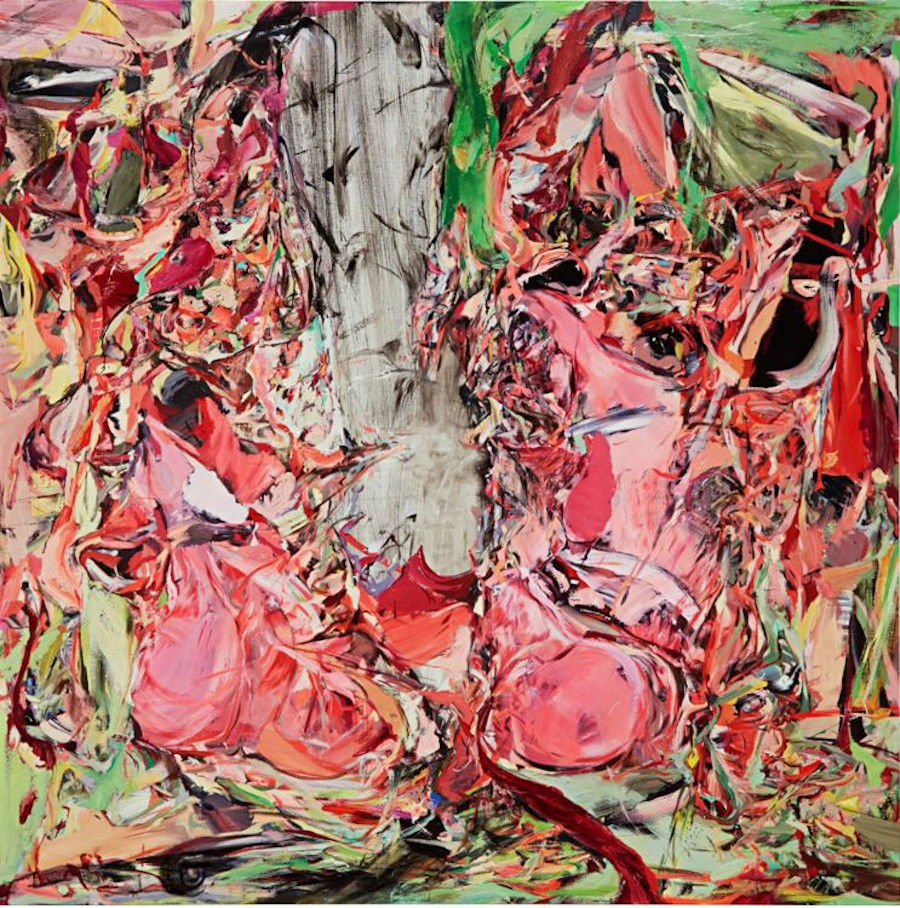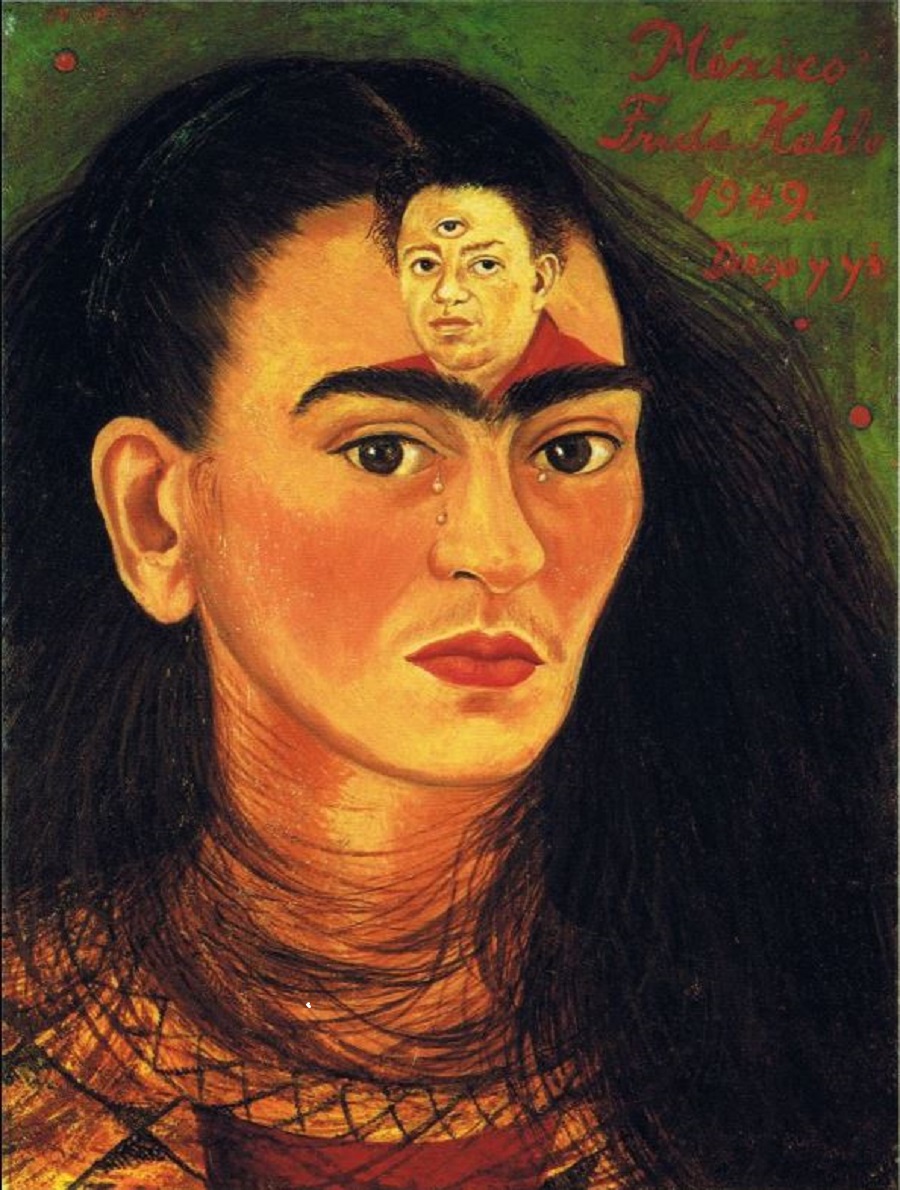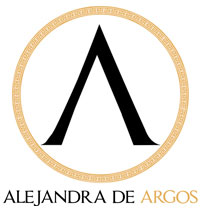- Details
- Written by Marta Sánchez
To contemplate a painting by Cecily Brown is to experience something vital, especially as regards the massive canvasses she churned out feverishly during the early years. Their surfaces manifest an intense vacuous horror, where a profusion of colours and brushstrokes reveal bodies twisted in passion or revulsion, fairytale characters, nudes, fruits, trees or, even, just lines of expression and vibrant colours that are a masterclass in composition.
Painting As A Reflection Of Passions
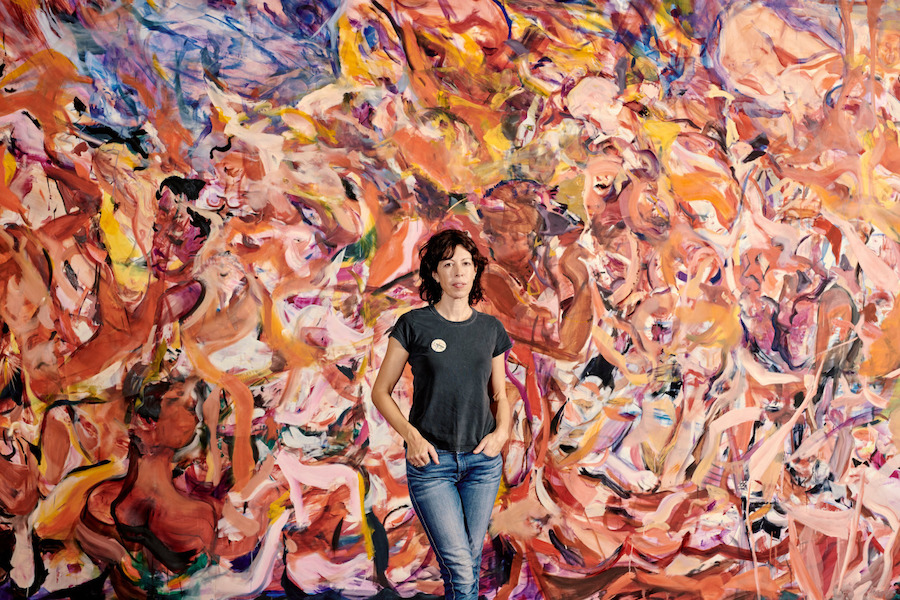
Cecily Brown
To contemplate a painting by Cecily Brown is to experience something vital, especially as regards the massive canvasses she churned out feverishly during the early years. Their surfaces manifest an intense vacuous horror, where a profusion of colours and brushstrokes reveal bodies twisted in passion or revulsion, fairytale characters, nudes, fruits, trees or, even, just lines of expression and vibrant colours that are a masterclass in composition. Although the influence of her friend and mentor Francis Bacon is evident in all her works (along with that of the classical and neoclassical masters), Brown still manages to escape the precarious stereotype of "women’s art" and forge her way into the field of 20th and 21st century abstractionism with a powerful sexuality and uncommon violence. Today, after struggling to make a name for herself on the New York art scene whilst working as a waitress, she is considered one of the key figures in contemporary painting. Her work expresses talent, energy and intellectual power, drawing the viewer into a complex web of brushwork, colours and intermingled shapes where each stroke has its place.
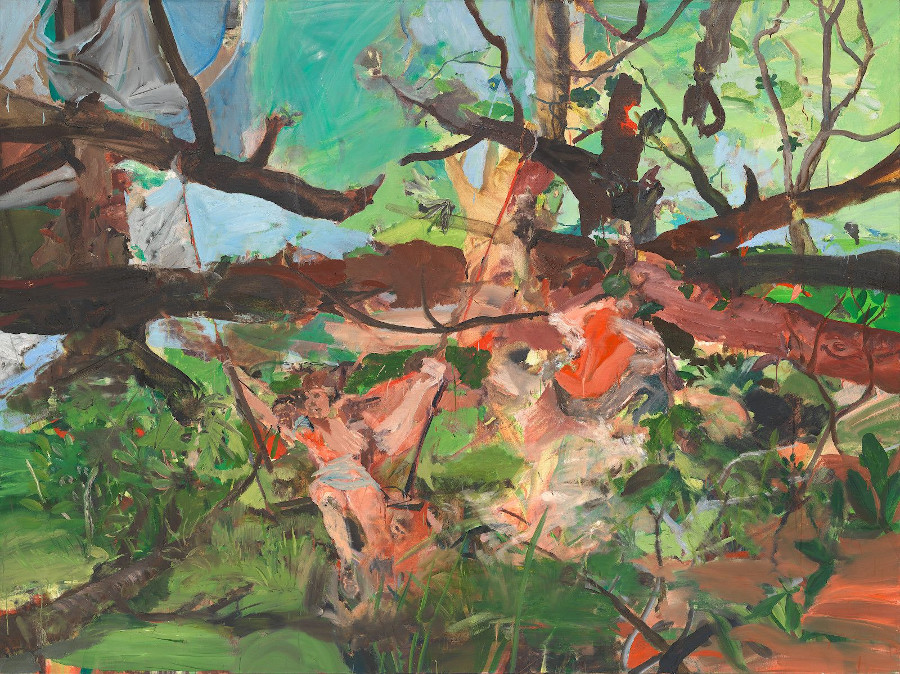
Girl on a swing (2005)
A childhood impacted by art (and Francis Bacon)
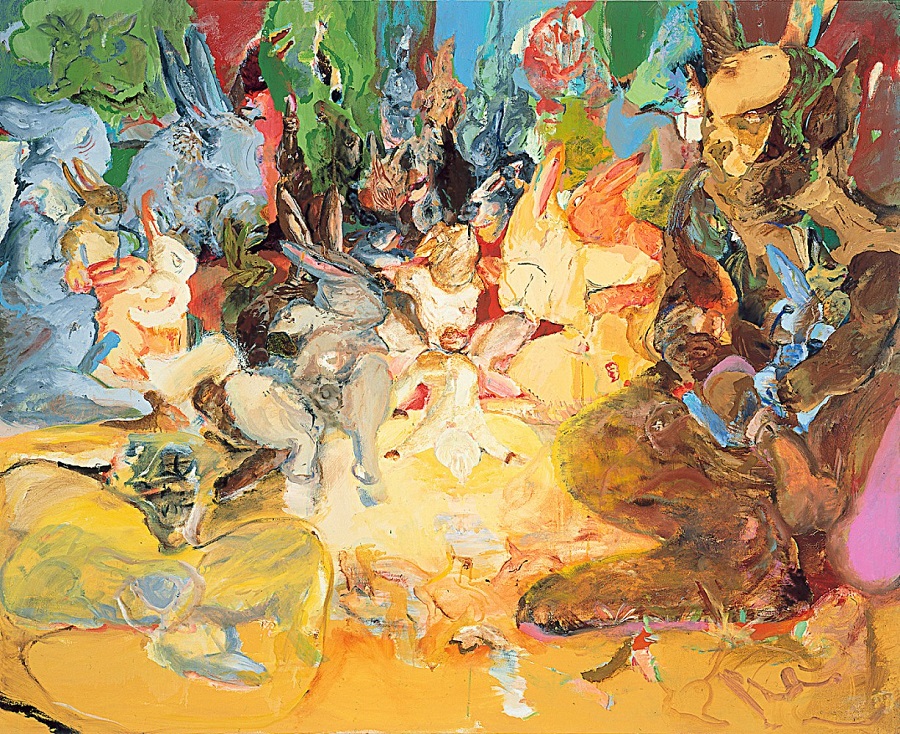
Untitled (1996)
Cecily Brown was born in Surrey, England in 1969 to a novelist mother and an art critic and curator father. She lived a bohemian childhood submerged in art, intellectualism and creative freedom - a family environment that would have a decisive influence on her future artistic vocation. In her own words, she decided to become an artist at the age of three, something that probably had not a little to do with her early contact with the British painter and draughtsman Francis Bacon, one of the most important figures in modern art and one whose paintings are among the most sought-after today. Bacon and Brown’s bonds of friendship would be maintained over time and exert a clear and profound influence on her own art. Likewise, the decisive impact of her mother’s creativity, work ethic and energy would also play a key part in the development of Brown’s personality, budding creative talent and work.
Adolescence and young adulthood in London – the difficult years
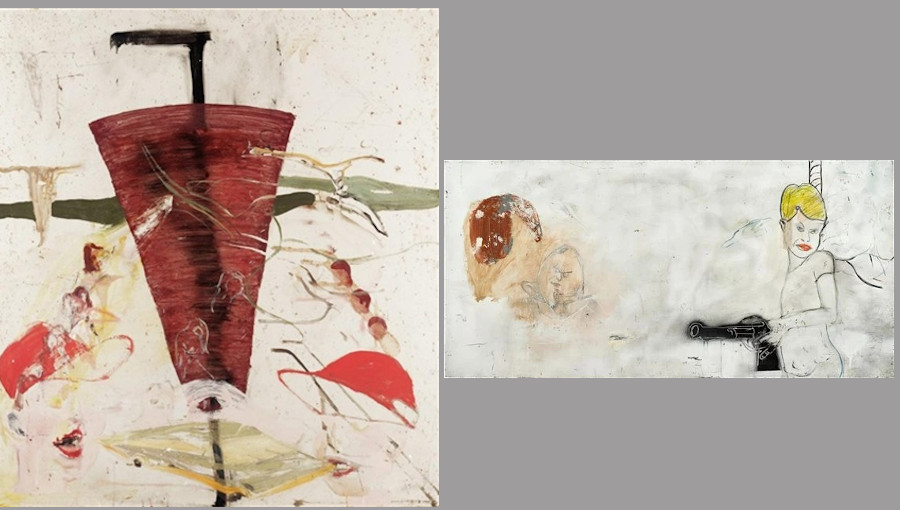
Untitled (Kebab) and Humpty Dumpty (1993)
At age 16, Brown left mainstream school to focus on a future in art. After two years at the Surrey School of Art and Design, she moved to London and studied drawing and engraving, as well as training under the tutelage of the painter Maggi Hambling. During that time and in order to survive in the big city, she worked as a cleaner - something she would continue to do until achieving definitive recognition. Paradoxically, her friendship with Francis Bacon continued and deepened due to their mutual fondness for visiting local art exhibitions. In 1993, Brown graduated with honours from the Slade School of Fine Art and won First Prize in the National Competition for British Art Students. Embracing the influence of Bacon's pictorial imaginary, she distanced herself from the London art scene of the 90s - a world of installations, large-scale or site-specific works and multimedia creations, among other contemporary disciplines. This commitment to a traditional style of painting would prevent her from making a name for herself in what was the capital’s highly dynamic art scene.
Fleeing to New York and the first signs of success
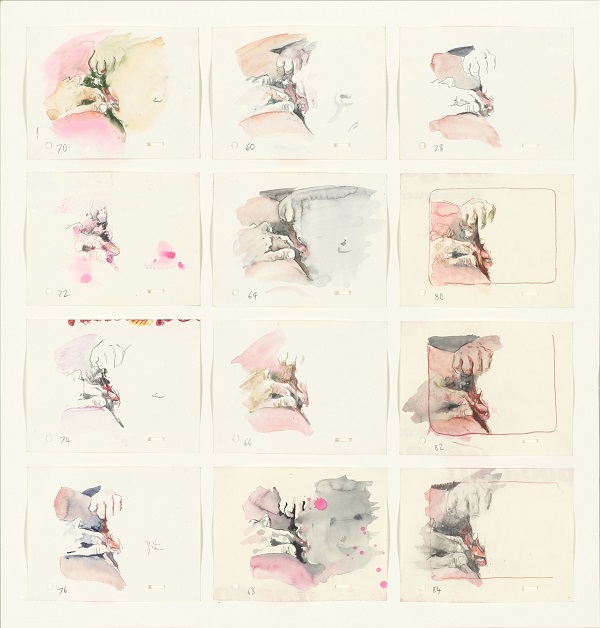
Four Letter Heaven (screenshots from animated short, 1995)
Tired of achieving no recognition in London, Brown moved to New York in search of new horizons. In 1995, she arrived in the city whose sights and lights had dazzled her on a previous trip and decided to move away from painting in order to explore other formats. This was when she created “Four Letter Heaven”, an animated short with erotic overtones using mixed media, which went on to win an award at the Telluride Festival. At that time, a still young Brown was working as a waitress and suffering severe economic hardship. She went back to working on canvas, painting in a compulsive and feverish way in her Manhattan studio and it was then that she began to create her emblematic large-scale works: paintings in which brushstroke and colour generate scenes of chaos, midway between abstraction and figuration and in which violence and sex always make an appearance.
Spree (1999)
From the moment of her solo exhibition organised by the Deitch Projects gallery in 1997, Brown's rise on the New York art scene was unstoppable, with exhibitions of her work continuing throughout the decade and receiving total acceptance from critics and the public alike. Aged just 29, one of the world’s most prestigious art galleries, the Gagosian in New York, decided to represent her and include her work in its catalogue. She continued to paint almost obsessively in the new studio she shared with Sean Landers, a fellow painter and her partner at the time. Success, however, did not bring her any sense of satisfaction and those days and years would become one long and intense succession of parties, alcohol, boyfriends and art. In later years, Brown would admit that she felt "forced" to play the role of "tormented genius", leading a lifestyle according to what seemed to be demanded then on New York’s art scene.
“life, death and the kitchen sink”
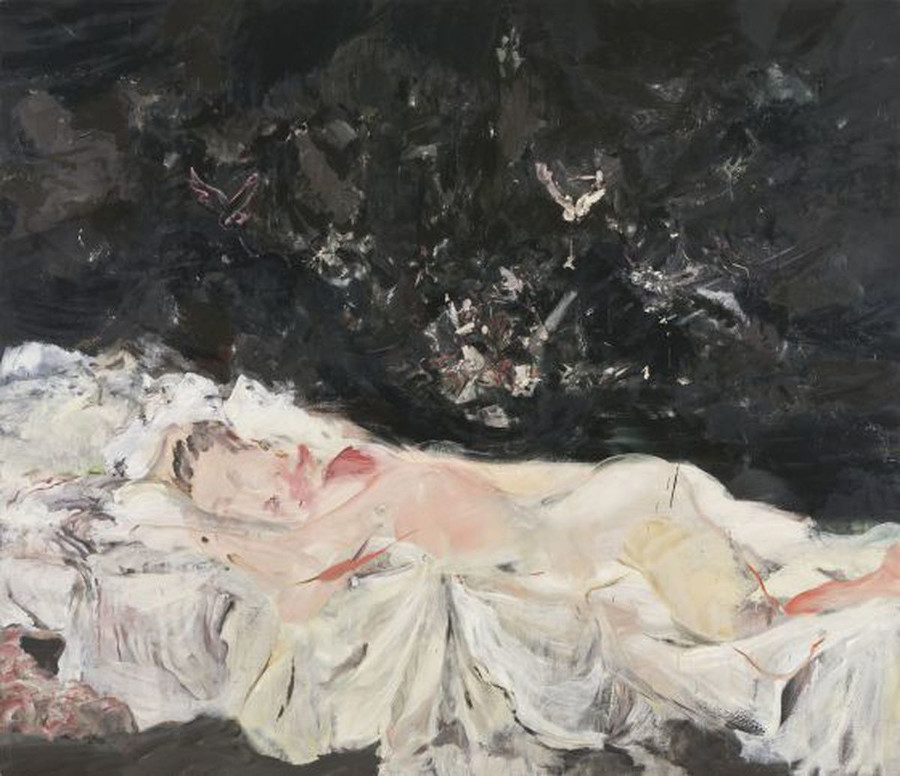
Black Painting (2002)
Brown has never hidden her admiration for classical masters and the avant-garde. From Goya to the American abstract expressionist Willem de Kooning, her canvases reflect clear influences from previous artistic schools: Goya's Black Paintings and Kooning's Monsters, among others. Brown’s series of Black Paintings took their inspiration and made it her own, with powerful brushstrokes, chaos and an intense, disturbing sexuality as new additions.
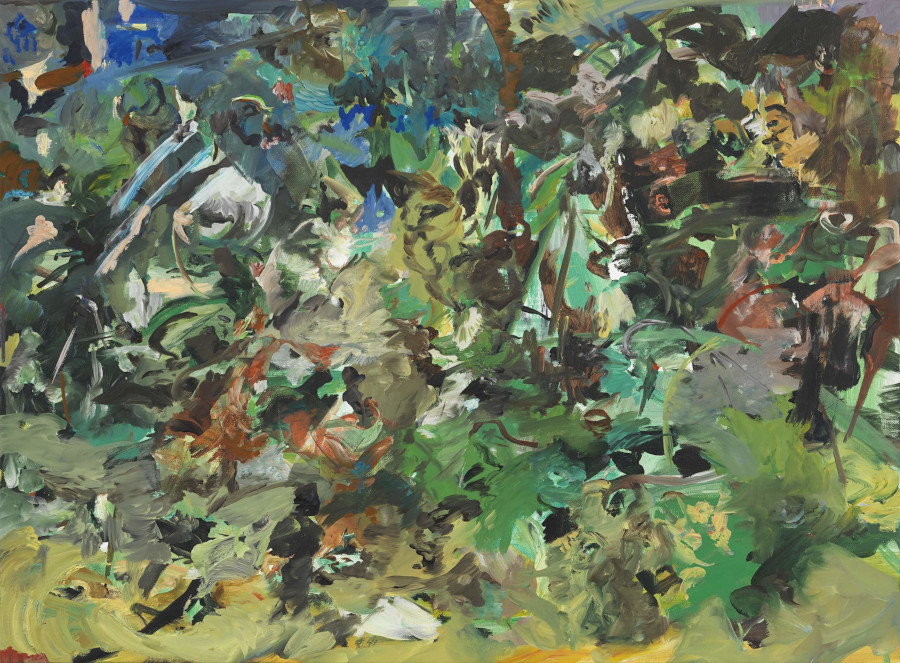
Untitled (2011)
While Brown has retained her style and creative identity over the decades, it is clear that in recent years her art has undergone an interesting evolution. After her 15-year collaboration with the Gagosian Gallery ended, her paintings began to take on a smaller size and an obvious change in themes - canvases where violence, chaos and human sexuality seemed to burst onto the canvas through colour and where gesture made way for less powerful themes. As Brown recently remarked, "What interests me now is life, death and the kitchen sink." In addition to working on canvas or panel, Brown has also created installations for multiple art spaces and has collaborated on the creation of murals.
Creation of a mural in Buffalo (USA) by the city's community of artists and art students, in collaboration with Cecily Brown
Exhibitions
Brown has seen her work exhibited in some of the most important museums and galleries in the world. In 2014, the Gagosian Gallery organized a large exhibition of her work so far that decade. Her work has also been recognized in multiple exhibitions and retrospectives, such as those held by the MACRO in Rome (2003) and the Queen Sofía National Museum of Art in Madrid (2004). Below are highlighted some of the most recent exhibitions of her work around the world.
Cecily Brown: Rehearsal (2016)
In New York, THE DRAWING CENTER is one of SoHo’s benchmark art institutions. 2016 saw its first ever Cecily Brown retrospective exhibition, with eighty drawings and sketches accompanied by several works in mixed media showcasing the relationship between both disciplines.
Cecily Brown. Paula Cooper Gallery (2020)
In 2020, another highly influential and prestigious venue, the Paula Cooper Gallery, exhibited a series of works Brown produced during the Covid-19 lockdown. The paintings are inspired by the Flemish Master Frans Snyders and depict tables stacked with hunting paraphernalia among which multiple vague human shapes that can just about be seen, some in openly erotic poses.
Cecily Brown at Blenheim Palace (2020-21)
Brown was the first person to feature in a major monographic exhibition here with works from her New York period, at the request of Blenheim Palace. In the video, Brown explains how her creative process works and how the Palace environment was an inspiration.
Books
Cecily Brown: Days of Heaven. StephanSchmidt-Wulffen. 2001
The presence of an intense eroticism, bordering on pornography, is common in Brown’s work. She explains: "I use [pornographic] material to study the body. With it I am interested in the emotional content of these models”. Seen from a certain distance, the dots, colours and brushstrokes of her paintings become naked bodies portraying erotic scenes. The exhibition “Days of Heaven” allowed visitors an insight into this side of the artist's work, as reflected in the catalogue of the same title.
Cecily Brown: The Sleep Around and the Lost and Found. Terry R. Myers. 2016
This catalogue features all of the works brought together for the exhibition of the same title, organized by the Berlin Centre for Contemporary Art in 2015. Its pages gleam with large full-page colour reproductions and also showcases the installation that the artist created for the occasion. The pictures are accompanied by an exhaustive essay on Brown's work, written by art critic, professor and curator Terry R. Myers.
Cecily Brown: Shipwreck Drawings. 2017
The violence that is so commonly depicted in Brown's painting by means of the human body shifts here to instead be portrayed through shipwreck imagery. Rather than painting on canvas, she chooses drawings to capture intense scenes of nautical disasters, by dint of which she highlights the tensions between the past and the present. In these charcoal, pastel, watercolour and ink drawings, she is clearly inspired by the work of Delacroix and, more so, by Géricault's well-known “The Raft of the Medusa”.
(Translated from the Spanish by Shauna Devlin)
- Cecily Brown: Biography, Works and Exhibitions - - Alejandra de Argos -
- Details
- Written by Marta Sánchez
“I am a specialist in life as a permanent crisis.” Thus defines himself Miquel Barceló, one of the most sought-after and internationally recognized Spanish artists alive today. His capacity for communication goes hand in hand with the scope and variety of his work: huge canvasses, small drawings, murals, engravings, book illustrations, ceramics, sculpture, opera staging, album covers, posters, television programmes
The art of sea caves, the ocean and the soul
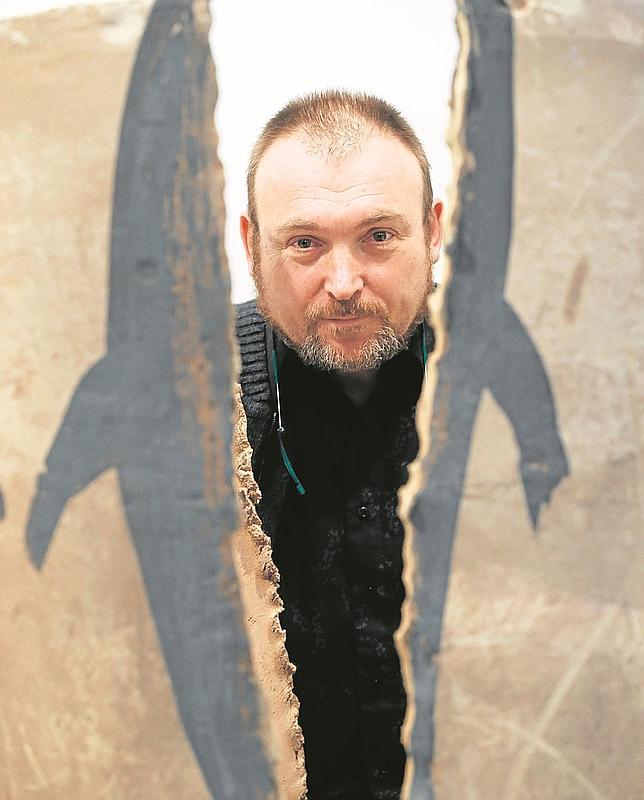
Miquel Barceló. Photo: Jaime García
“I am a specialist in life as a permanent crisis.” Thus defines himself Miquel Barceló, one of the most sought-after and internationally recognized Spanish artists alive today. His capacity for communication goes hand in hand with the scope and variety of his work: huge canvasses, small drawings, murals, engravings, book illustrations, ceramics, sculpture, opera staging, album covers, posters, television programmes ... Onto each and every one of those mediums, Barceló stamps his character, his energy and the "aggression" that distinguish his work - as well as his profound interest in Nature, whether that be in outdoor spaces or the life contained within them but always with a Mediterranean or African backdrop that connects his art directly with the land and the sea. His work is personal, original, complex and impossible to pigeonhole into any one artistic movement or context.
Adolescence, Nature and roots
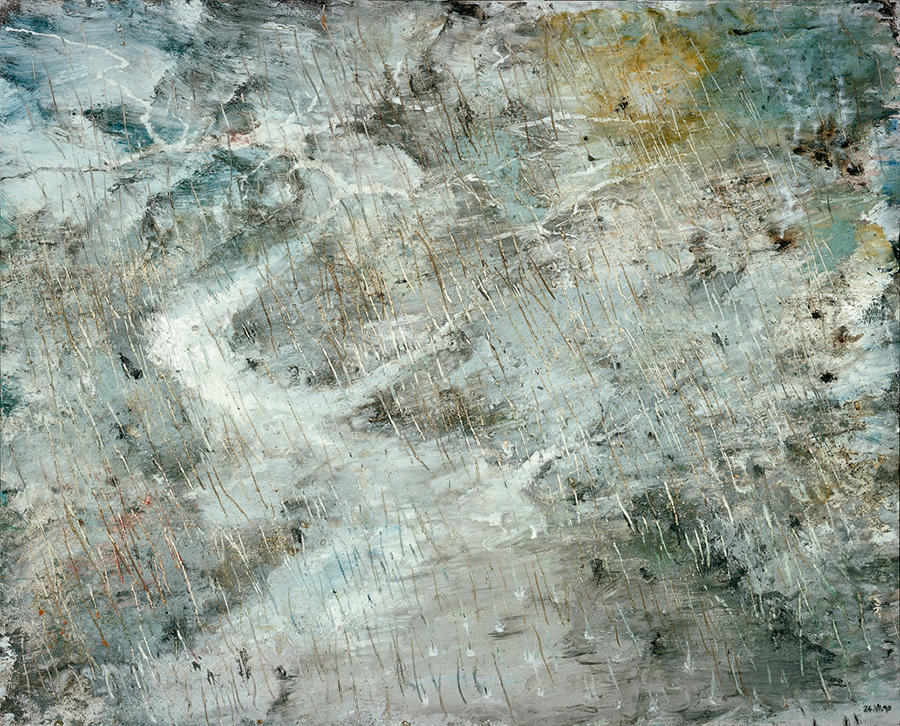
"The Flood" (1990). Guggehneim Museum, Bilbao
Miquel Barceló was born in 1957 in Mallorca, a Mediterranean island where the young artist first experimented with art. The influence of his mother, who herself was a painter for a time, might have had something to do with his desire to create but, without a doubt, art was already coursing through his veins. In Mallorca, "his island", where he became enamoured with the caves and the sea, he met Joan Miró who would have a profound influence on his early work (animal themes, which became a constant throughout his career, and a markedly Expressionist style). In his teens, he studied at the School of Arts and Crafts in the island’s capital - Palma de Mallorca - participating, aged 16, in his first collective exhibition – “Art Jovenívol” - and then organizing his first solo exhibition at the Picarol Art Gallery at 17. In the 1970s, Barceló travelled to Paris where he discovered the work of Klee and Dubuffet and also encountered Art Brut, a school with which he felt an intimate connection and which became a new starting point from which to explore new horizons.
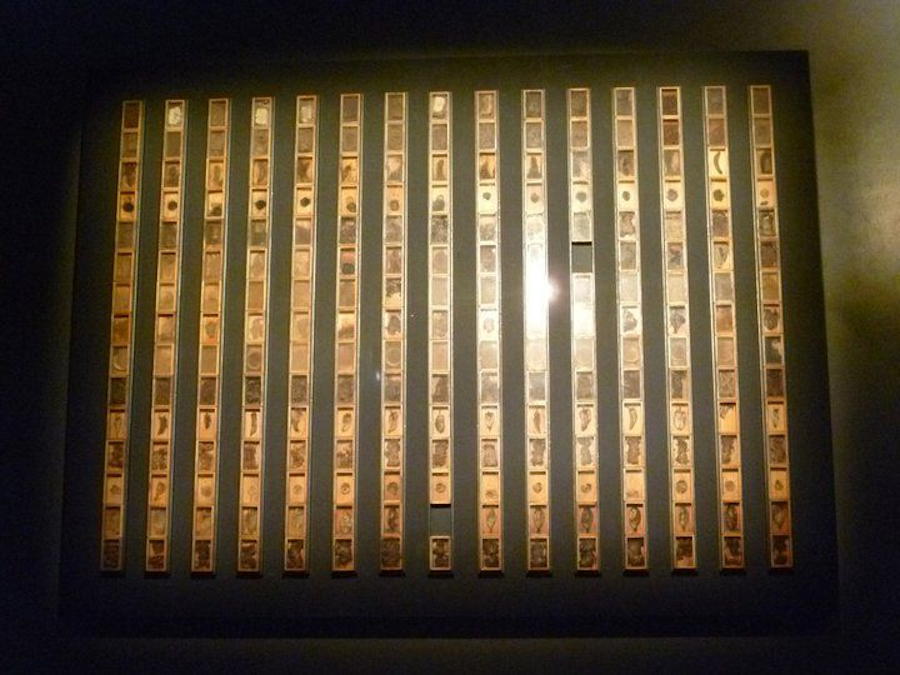
"Cadaverine 15" (1976)
Names such as Mark Rothko, Jackson Pollock, Willem De Kooning and Lucio Fontana then joined the list of his early influences, along with, of course, masters such as Velázquez, Tintoretto and Rembrandt who kept his work well rooted in excellence and classicism. During those years, he continued to demonstrate his concerns for both art and the environment, combining the organization of various exhibitions with activist action such as occupying the uninhabited Sa Dragonera island in 1977, with the aim of preventing its urbanisation. It is then that he meets and befriends the artist Javier Mariscal. From his very earliest years as an artist, Barceló made clear his deep affinity with Nature - always experimenting and incorporating natural and organic material into his works, with some of them embarking on their own journey of evolution over the passage of time. He would leave his paintings outdoors at the mercy of the elements which caused them to crack or rust. He also used organic matter, the deterioration of which was very much a part of its artistic significance, as seen in his exhibition “Cadaverine 15” (Mallorca, 1976) in which 225 glass-topped boxes containing organic and inorganic material showcased the process of decomposition and decay.
Success in Paris and the beginning of a nomadic life
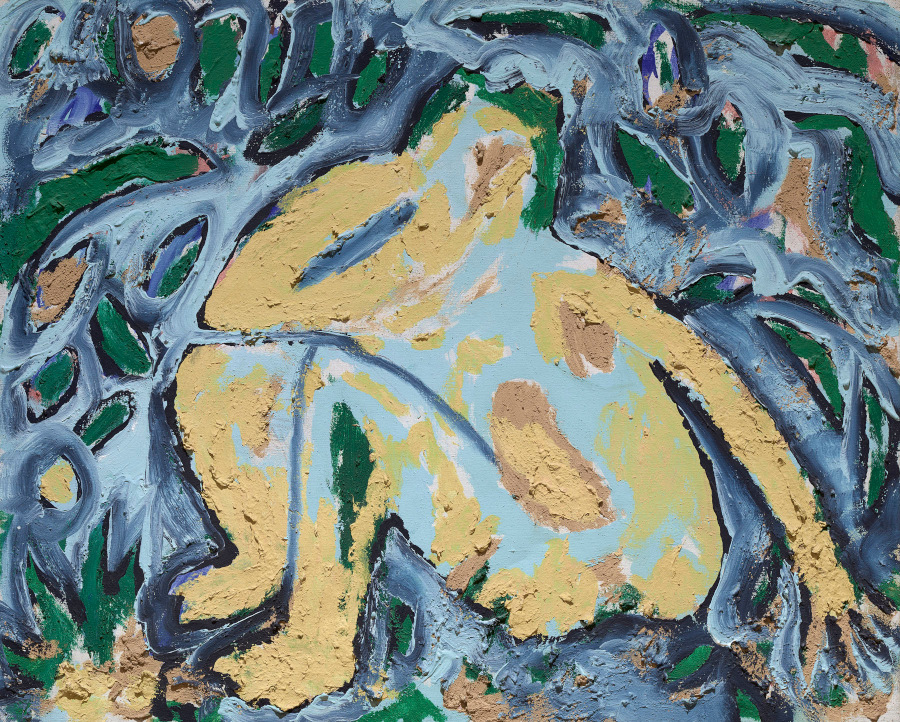
"Seated Venus Bruta" (1982)
Despite his deep-seated roots in Mallorca, Barceló's restless and curious spirit gave him itchy feet and he left the island in search of new locations for his art. In 1980, he landed in Barcelona and set up a studio there. That year, his career enjoyed a boost that would prove key to his future artistic career: he was the only Spanish artist selected to participate in the prestigious Kassel Documenta (Germany), in its seventh edition. He was still only 23 years old but showed a talent, a work ethic and a maturity that set him amongst the most important international creatives of the time. In fact, just two years later, he achieved the distinction of exhibiting in Paris, the art capital of the world, at the Yvon Lambert gallery. Success, however, did not mean that the young artist would rest on his laurels or settle down; in the ensuing years, Barceló would often move house and participate in various projects located in other European cities. This need to venture into other countries and experience other realities would almost become a lifestyle for the artist and would have a powerful influence on his work.
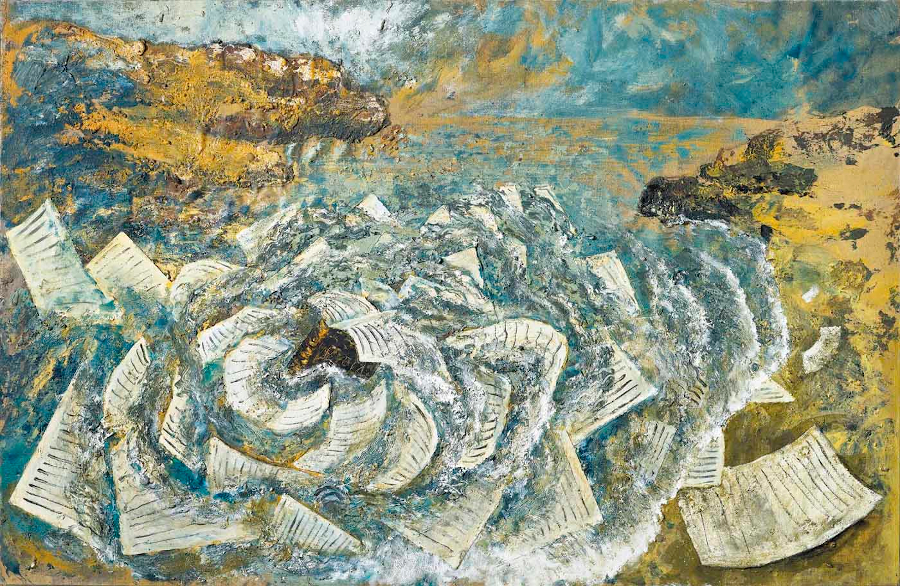
"Wet Novel" (1985)
Throughout his travels and multiple art projects, Barceló comes into contact with some of the most important figures in the art world of the time. Among them is the Swiss gallery owner Bruno Bischofberger, who was to have a decisive influence on his career and become his art dealer at international level. He also meets his future wife - the Frenchwoman, Cécile Franken. The year 1986 would see his fame cross the Atlantic to New York where he exhibits at the Leo Castelli gallery. He falls in love with the city and sets up a temporary studio there, in which he will work and live for several months. These are years of recognition for Barceló, an artist who had always been a legend in his homeland, and he receives the National Prize for Plastic Art in the painting category. Soon, the call of the homeland and the Mediterranean begin to become irresistible and he returns to Mallorca.
Trip to Mali: The beginning of a passion for Africa
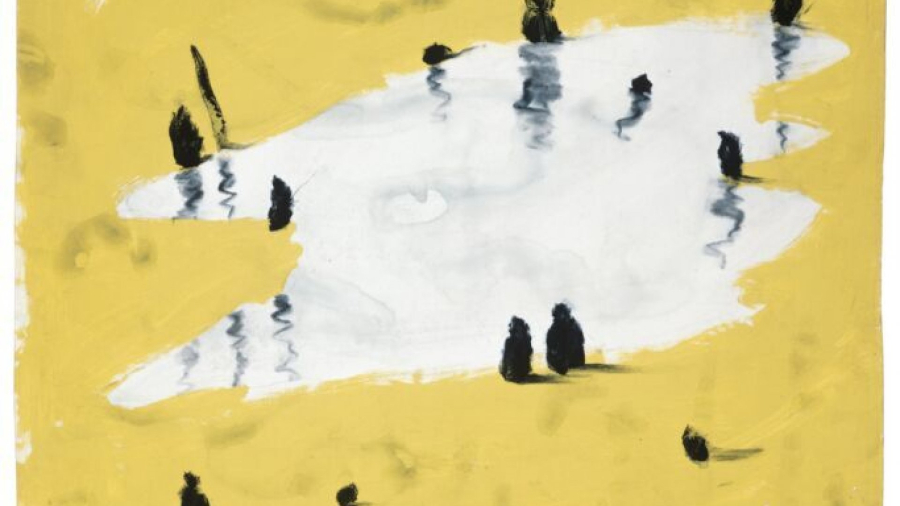
"In Mali" (1989)
Not a year goes by without Barceló’s restless spirit demanding new changes. In 1987, he travels to Paris and settles there, making the city his home from time to time, as it remains to this day. The following year will be a turning point in Barceló's life and work. He travels to Africa with a group of other artists but, instead of returning with them to Spain, he decides to stay on in Mali and also to travel around Senegal and Burkina-Fasso. These experiences are described in his "African Notebooks", written in both French and Catalan, which reveal the writer coexisting alongside the painter.
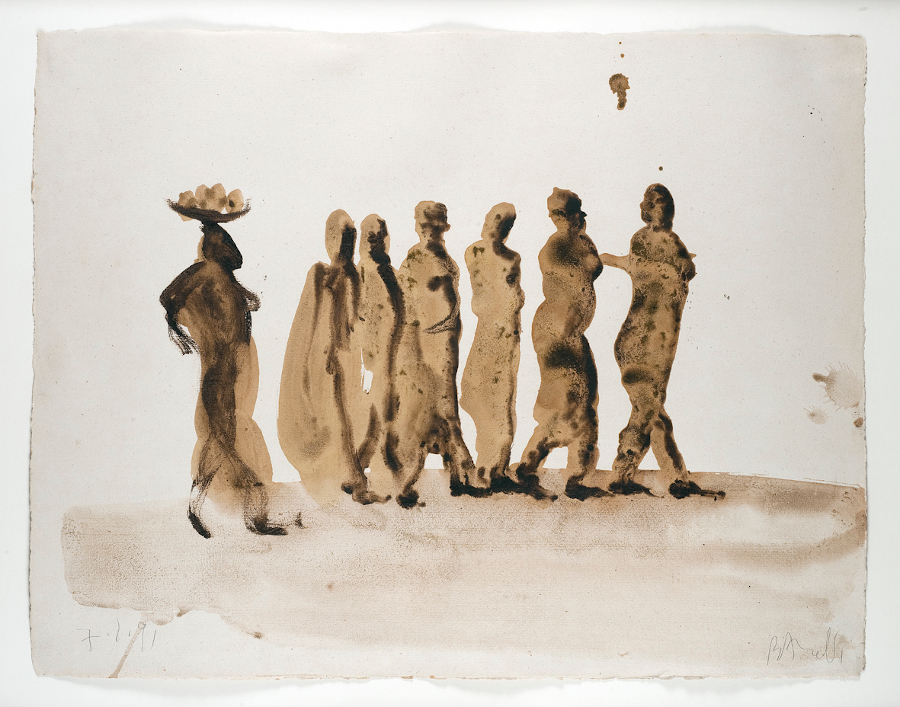
"Mali". Gouache on paper (1991)
Barceló then develops an intense love and deep connection with these peoples and places, as evidenced by the magnificent drawings that date from his time there. Contact with local people and life in the desert define his subject matter and methodology. He begins to show his concern for the natural environment, the passage of time and the origins in everyday scenes and small African landscapes, more detailed drawings, dense, dark raised surfaces that give the impression of reliefs, and for which he takes advantage of the mud and natural pigments he has at his fingertips. These works are now part of different public and private collections around the world, and have been displayed in several exhibitions, such as the one organized in 2008 by the Centre of Contemporary Art in Malaga. But Barceló does not limit himself to Africa and it is at this time that he adds a Mali workshop studio as a final corner to complete his vital triangle, along with Paris and Mallorca.
Awards and architectural projects
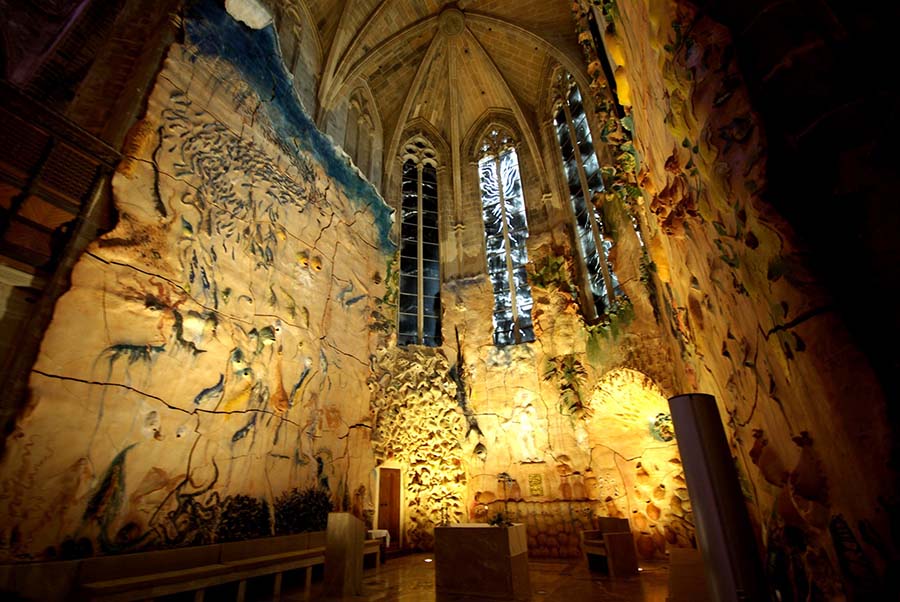
Chapel of Sant Pere in the Cathedral of Palma de Mallorca
1986 saw the beginning of his involvement with architectural projects, painting the dome of the lobby of the Mercat de las Flors Theatre in Barcelona. At that same time, 'velatura' starts to appear in his painting, along with overlays of materials giving the impression of transparency. Barceló continued to work without interruption and in 1995 he was selected to participate in the Venice Biennale and, three years later, the first major retrospective exhibition of his work was on display at the Museum of Contemporary Art in Barcelona. The awards kept coming over the decades until, in 2003, he was awarded the Prince of Asturias Prize for the Arts. The following year, the artist undertakes one of his most important projects to date - decoration of the Chapel of Sant Pere inside the Cathedral of Palma de Mallorca, which was completed in 2007. While the spectacular space underwent a renovation to its liturgical elements of stonework, stained glass windows and furnishings, Barceló also added a 300 m² ceramic mural representing "The Feeding of the Five Thousand". The work features a series of constants in Barceló's work - the sea, flora and fauna, grottoes and caves.
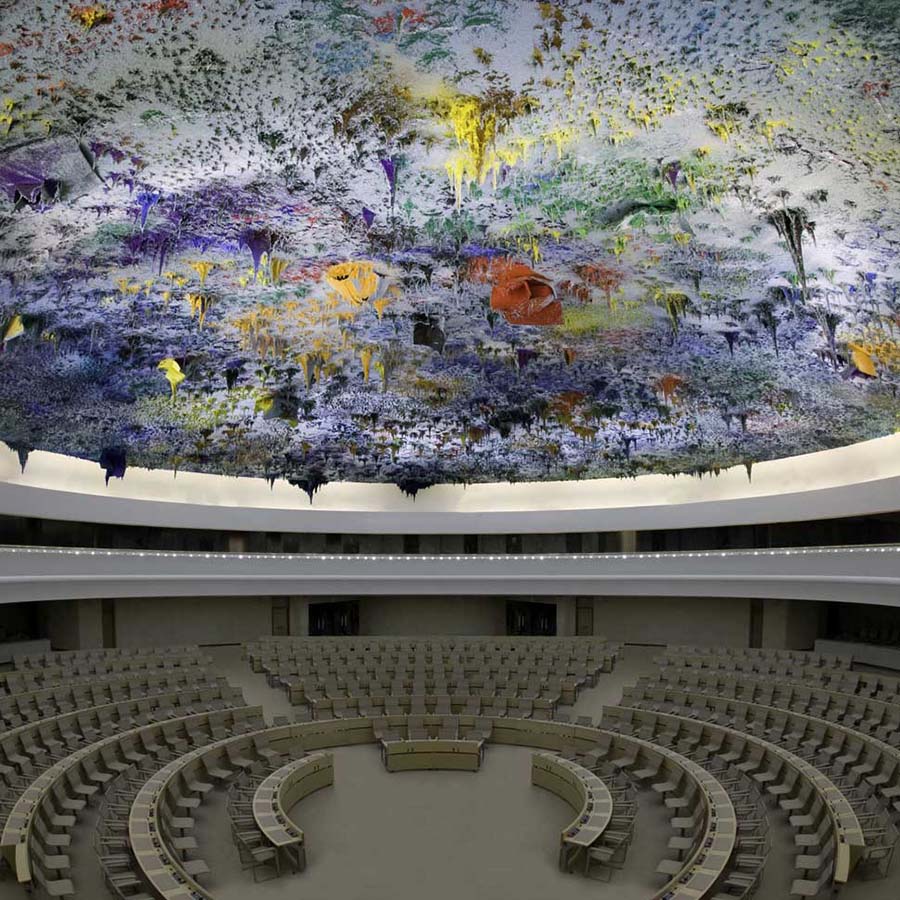
Dome of Room XX or the Human Rights and Allliance of Civilisations Chamber, UN European Headquarters, Geneva
The Dome of Room XX or the Human Rights and Alliance of Civilizations Chamber at the UN’s European headquarters in Geneva is one of his works with the greatest international import, albeit not without controversy due to its use of funds otherwise destined for Spain’s development aid budget. It is a huge 1,400 m² dome from which hang thirty-five tons of paint in the form of coloured stalactites, made with pigments sourced from all over the world. On the technique, Barceló commented: "I wanted to take painting against the laws of gravity to the extreme." and went on to explain: "On a day of intense heat in the middle of the Sahel Desert, I vividly remember seeing the mirage of an image of the world dripping skyward […] The cave is a metaphor for the agora, the first meeting place of human beings, the great African tree to sit under and talk about the only future possible, one with dialogue and human rights."
Work that branches out and grows on different terrains
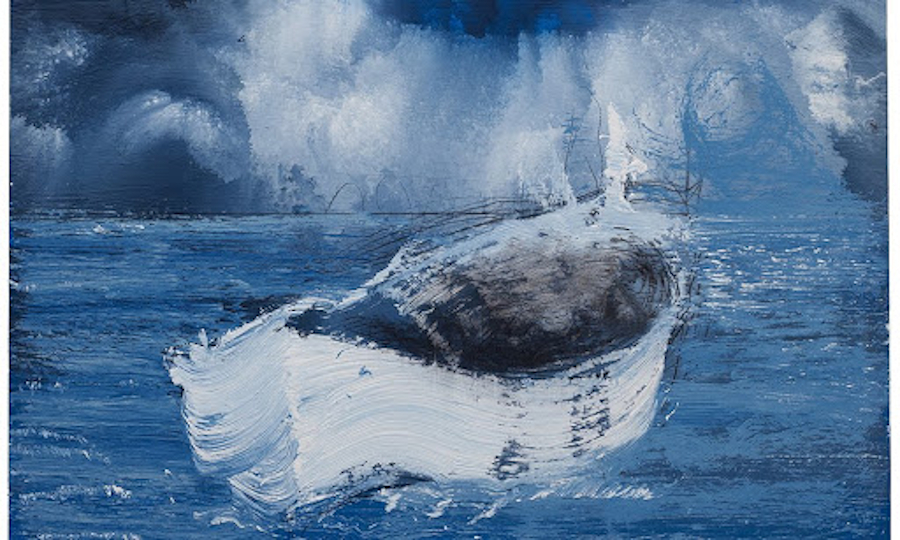
"Large Cove" (2018)
Barceló continues to expand his broad body of work at his three studios in Mallorca, Mali and Paris. His incessant and restless activity seeks an outlet in all kinds of media: illustrated books such as the poet Enric Juncosa’s "Book of the Ocean"; the forwards and texts of his own catalogues and notebooks; photography books such as "The Cathedral Under the Sea"; a book for the blind, "The Dismantled Shops or The Unknown World of Perceptions", with text in braille; and the three volumes of Dante's "The Divine Comedy" which were subsequently the subject of an exhibition at the Louvre in Paris.
Performance at the inauguration of the "Noah's Arc" exhibition (2017)
With his penchant for experimenting in every field of the arts, Barceló has also designed sets for opera. In Falla’s "Master Peter's Puppet Show" at the National Theatre of Comic Opera in Paris, he created the staging, costumes and large-scale puppets; and for Mozart’s “The Abduction from the Seraglio” at the Festival d'Aix-en-Provence in 2003, he took on the entire set decoration. More recently, Barceló has demonstrated his versatility and artistic passion via large exhibitions and personal interventions, such as his "Performance" in 2017 at the inauguration of "Noah’s Arc" at Salamanca University. Miguel Barceló interviewed by Elena Cué
Interview with Miquel Barceló. By Elena Cué
Exhibitions
Miquel Barceló. Spanish Pavilion at the Venice Biennale, 2009
In 2009, Barceló represented Spain again at the Venice Biennale in its 53rd edition. The exhibition showcased a series of large format canvasses from the previous nine years and also included ceramic pieces along with more recent work carried out during his decoration of the United Nations dome in Geneva.
“Miquel Barceló. 1983-2009” (2010)
“My life is like the surface of my paintings." This quotation from Barceló kickstarted an exhibition organized by the La Caixa Foundation and held at its headquarters in both Madrid and Barcelona. The show comprised a selection of 180 pieces completed between 1993 and 2010 and included some of his largest paintings alongside his sculpture "Big Elephant, Upright".
"Sol y Sombra (Sun and Shade)" (2016)
This exhibition opened in 2016 in one of Paris’s most iconic buildings - The National Library of France - which partnered with the city’s Picasso Museum to host a joint exhibition. Visitors were treated at both venues to the display of some never-before-seen pieces, enabling them to experience an authentic immersion in the Majorcan artist’s universe.
“Noah's Arc” (2017)
Salamanca University’s eighth centenary celebrations included a large exhibition of Barceló's work. The artist himself participated, performing during its inauguration. The exhibition took up four spaces at the university, as well as the city’s main square, with works from multiple disciplines: sculpture, ceramics, drawing and the performance itself.
"Miquel Barceló. Metamorphosis" (2021)
2021 began in Malaga with an exhibition held at the Picasso Museum, which included around one hundred works created by Barceló between 2015 and 2020. The exhibition took its name from Kafka's famous novel and comprised a selection of pieces on canvas and paper, as well as ceramics, notebooks and bronzes.
Books
Notebooks from Africa. (Galaxia Gutenberg Círculo de Lectores, 2008)
Barceló's journals from his stays in Africa between 1988 and 2000 have become an important body of work within his career. The entries compiled in this publication are interlaced with drawings, watercolours and gouaches from Mali, Senegal and Burkina-Fasso. The text, originally in French and Catalan and complemented by sixteen pictures, includes shopping lists, letters to friends, his fears and desires, details about the process of artistic creation, ... The writing is vivid, absorbing and the perfect accompaniment to the artistic output that immortalized Barceló's ‘Africa’ years.
Aurea Dicta. (La Casa dels Clàssics, 2018)
An authentic work of art, multi-award-winning and marked out for posterity. The Aurea Dicta project began in 1992 when a group of Catalan intellectuals set out to, in their own words, "for the first time, translate the Greek and Latin classics into modern-day Catalan in rigorous, entertaining and bilingual editions, in order to democratize and elevate the Catalan language and culture". The book is illustrated by Barceló in such a way that art dialogues directly with classical thought.
Un Grand Verre de Terre (A Large Glass Of Earth). (La Fábrica, 2020)
Once again, an artist's notebook that fuses Barceló's plastic artwork with an account of his lived experience and boasts beautiful photographs of the window panels he designed for the National Library of France in 2016. The images are especially important as this was a work of ephemeral art - the clay-on-glass fresco was dismantled by the artist himself at the close of the predetermined exhibition time. The notebook describes the process, sensations and end result of the work from the point of view of its creator. As the publisher points out, "a living work, designed to be observed from inside and outside the building, which introduced the visitor to an extraordinary exhibition".
(Translated from the Spanish by Shauna Devlin)
- Miquel Barceló: Biography, Works and Exhibitions - - Alejandra de Argos -
- Details
- Written by Marta Sánchez
Francisco de Goya's work is universally famous for its spectacular quality, its modernity and its commitment. The Fuendetodos teacher was a pioneer in technique and subject matter; a nonconformist in a society where he never quite fit in, but who surrendered to his dazzling artistry.
"Time also paints"
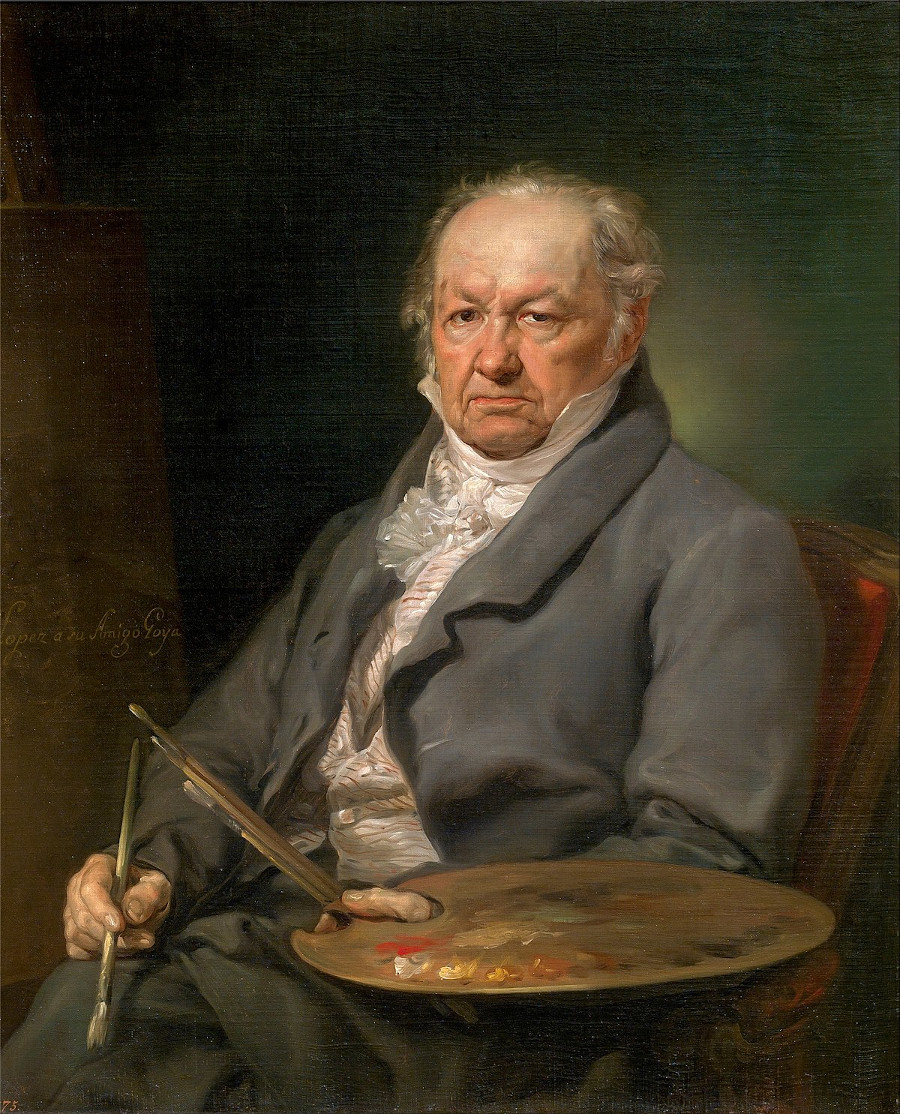
“The painter Francisco de Goya” (1826). Oil on canvas. Vicente López Portaña. Prado Museum
The Prado Museum is among the world's greatest art galleries and of all its rooms, the ones that draw visitors like a magnet are those showcasing the works of Francisco de Goya ~ one of the most important, charismatic and iconoclastic painters ever in the history of painting. His "Black Paintings" and engravings suite are much admired for their astonishing modernity and break from the norms of their time; his Costumbrista, portrait and religious paintings dazzle with the light they emit and the contemporaneity of their brushstroke which transforms them into works that are almost pre-Impressionist. His concept of art transcended that of the mere reflection of what surrounded him, instead interpreting his work as something in constant evolution: "Time also paints," he said on more than one occasion.
Goya's case is almost unique in the history of art, comparable only to that of masters such as El Greco or Turner. It is the story of those artists who shunned the schools of their time to pursue an art that would not be understood until many decades later, the intentions of their art being different, very different from those of their contemporaries. In Goya's own words: "The exceptional qualities of their work are ruined by these mannered masters, who always see lines and never bodies. But where do they find lines in nature? All I can see are light bodies and dark bodies, planes that move backwards or forwards, reliefs and concaves." - words that many avant-garde artists of the 20th century could subscribe to, written more than 150 years earlier.
Early learning and a trip to Italy
Francisco de Goya was born in Zaragoza on 10 March 1746 with art running through his veins, the son of a master gilder and a mother from the lower rungs of the aristocracy. In the mid-18th century, Zaragoza was a rich and powerful city with a flourishing business in the construction of churches and convents which then needed craftsmen to decorate them with altarpieces, paintings and panels. Goya's father's skills were much sought-after and he decided to push his children's aspirations along the same path. The future Court painter took his first steps towards paper and canvas aged 13 under the tutelage of José Luzán Martínez, who had been schooled by Neapolitan painters and whose influence would prove decisive in Goya's attraction to Italian painting. After Luzán Martínez, Goya continued his apprenticeship with Francisco Bayeu and, at the age of 17, applied for a grant and tenure from the Royal Academy of Fine Arts of San Fernando but was turned down. A further application in 1766 was again unsuccessful.
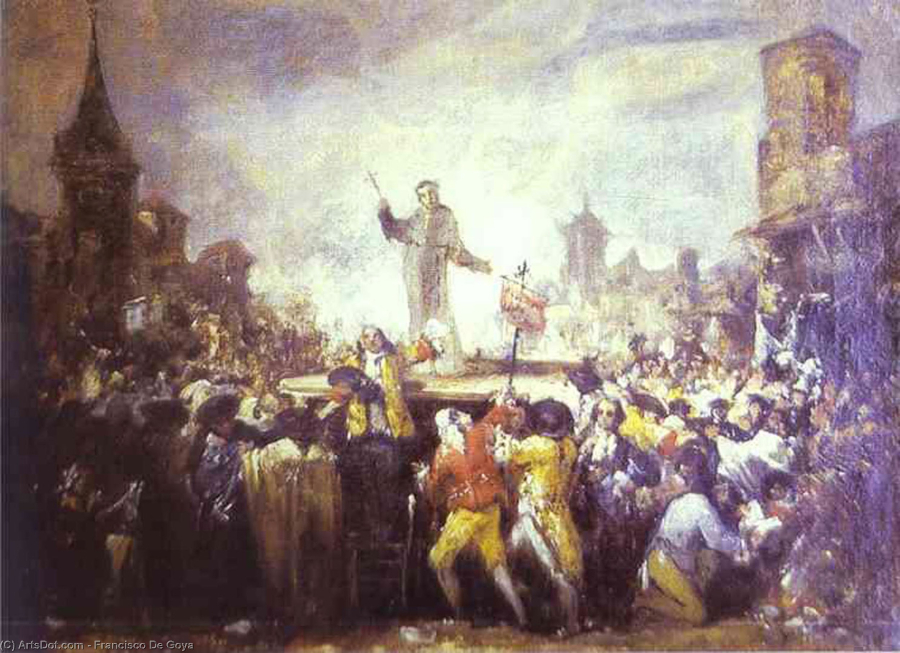
"The Esquilache Riots" (circa 1766)
Works attributed to Goya at this time are scarce, with some religious-themed paintings remaining but the one that stands out most is "The Esquilache Riots" (c. 1766). It is an ensemble painting that depicts an actual incident of great intensity and social relevance and displays some of what will become future constants in his work: the theatrical use of light and shadows, loose brushstrokes, vibrant colours, movement and a marked interest in balance and composition. In 1770, the young artist travelled to Italy, where his passion for masks, popular customs and street theatre was born - a passion that tallies with his fascination with people's faces and grotesque figures. During the trip, Goya decided to submit his entry in a competition held by the Academy of Fine Arts of Parma: "Hannibal the Conqueror views Italy for the first time from the Alps". While Goya's eponymously-titled painting garnered good reviews, the potency and "lack of realism" of the colours did not convince the jury to award him first prize. Goya's risky, personal and vibrant artistic style was already standing out for its modernity against the obvious academicism of his colleagues.
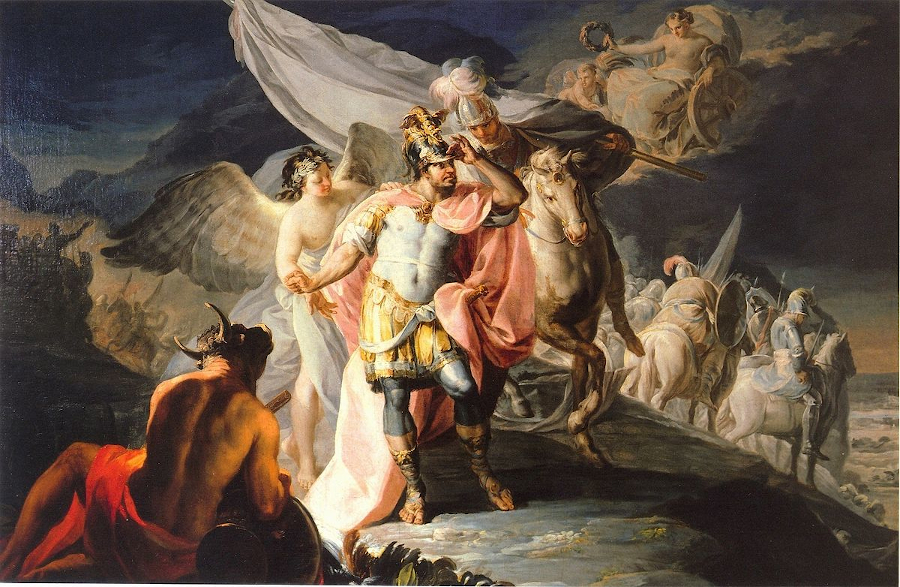
"Hannibal the Conqueror views Italy for the first time from the Alps" (1770). Selgas-Fagalde Foundation
First steps to success. Frescoes and Tapestry Cartoons
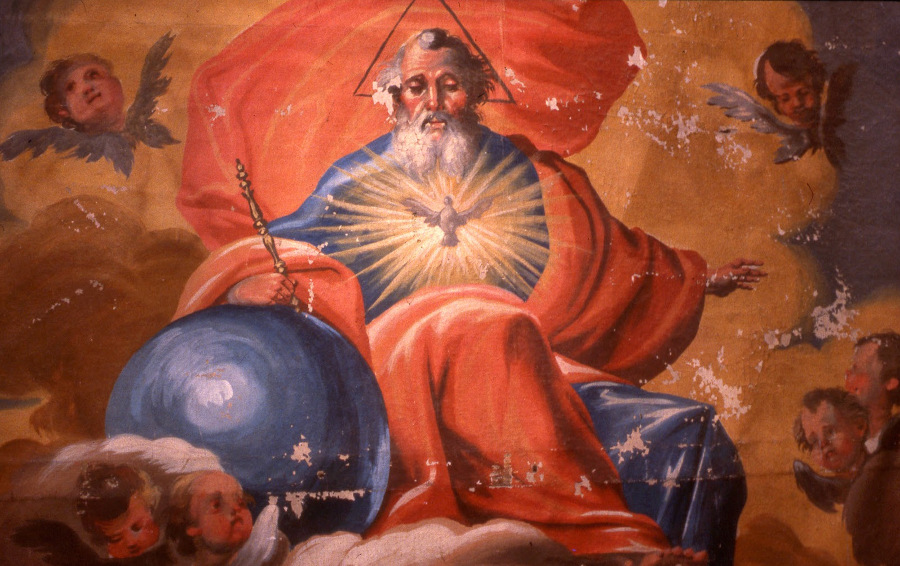
Detail from the Chapel of the Conde de Sobradiel, Zaragoza (1770). Barboza Grasa Archive
On his return, a now 25 year-old Goya takes on his first important commission: to paint a fresco in one of the vaults of Zaragoza's Basilica of the Pillar, applying the techniques learnt during his stay in Italy. This work wins him more contracts: frescoes for churches and palaces and, primarily, portraits of the Aragonese aristocracy. It was during this time that he completed paintings to decorate the chapel of the Palace of the Count of Sobradiel. His work earns him a certain fame and a stable position, factors that convince his former teacher, Francisco Bayeu, to allow Goya to marry his sister Josefa. Of all the seven children from their marriage, only the youngest, Francisco Javier Pedro, will survive to adulthood. How deeply the deaths of his children tormented the artist's soul will emerge later in his "Black Paintings", "Caprichos" and "Disparates" print series.
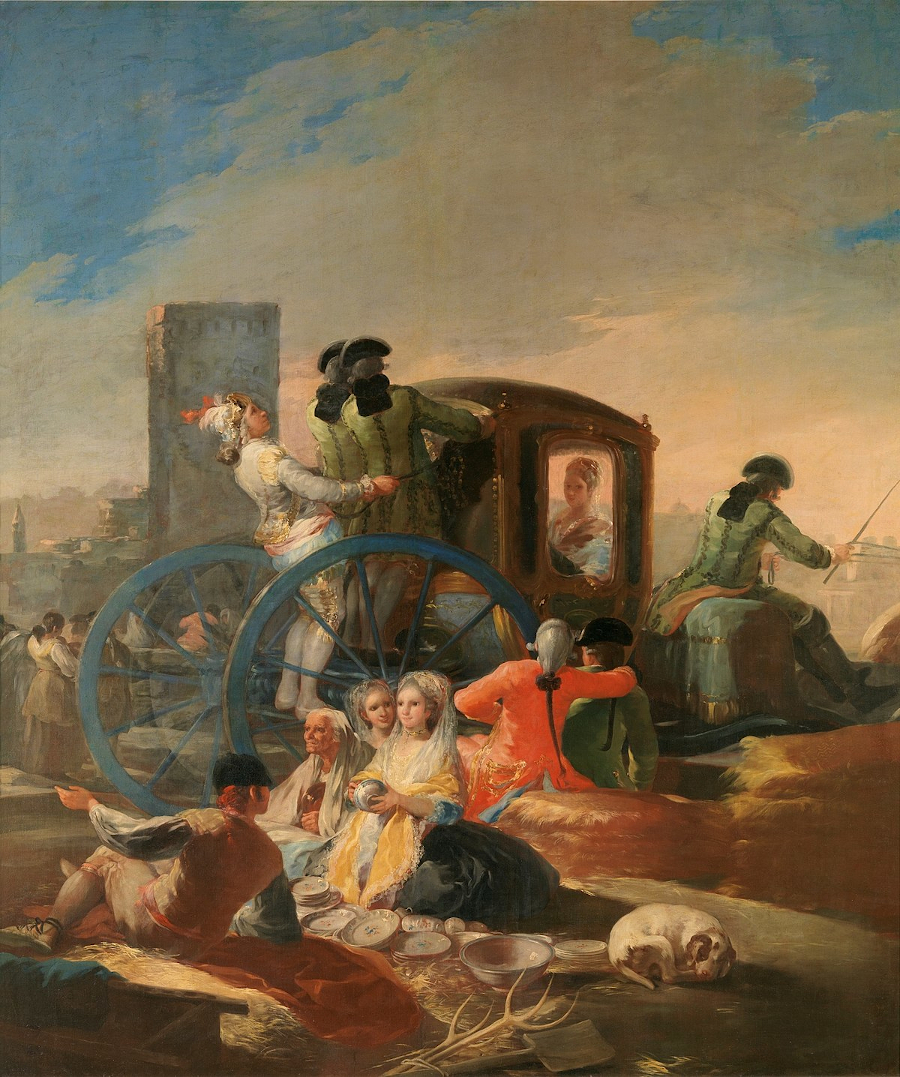
"The Pottery Vendor” (1779). Tapestry cartoon for The Royal Factory of Santa Barbara
1775 was to be a crucial and life-changing turning point for Goya. Anton Raphael Mengs, first painter to King Charles III and also commissioned as master painter by other European courts, calls on him to design and paint tapestry cartoons for the Royal Factory of Santa Barbara. The first ones were painted that same year: a total of nine works, each serving as a pattern guide for tapestries destined for The Royal Seat of San Lorenzo of El Escorial. Goya continues his production and the following year begins another series of cartoons, this time destined for the collection of the Palace del Pardo. Between 1778 and 1780, he both worked and lived at court which afforded him the opportunity to befriend the then Secretary of State, the Count of Floridablanca. This and other relationships, together with his undeniable talent and the originality of his work, guarantee him stability and Goya will then take his first steps towards becoming the future Court Painter. In 1780, he presents "Christ on the Cross" in support of his application to enter the Royal Academy of San Fernando and is admitted unanimously
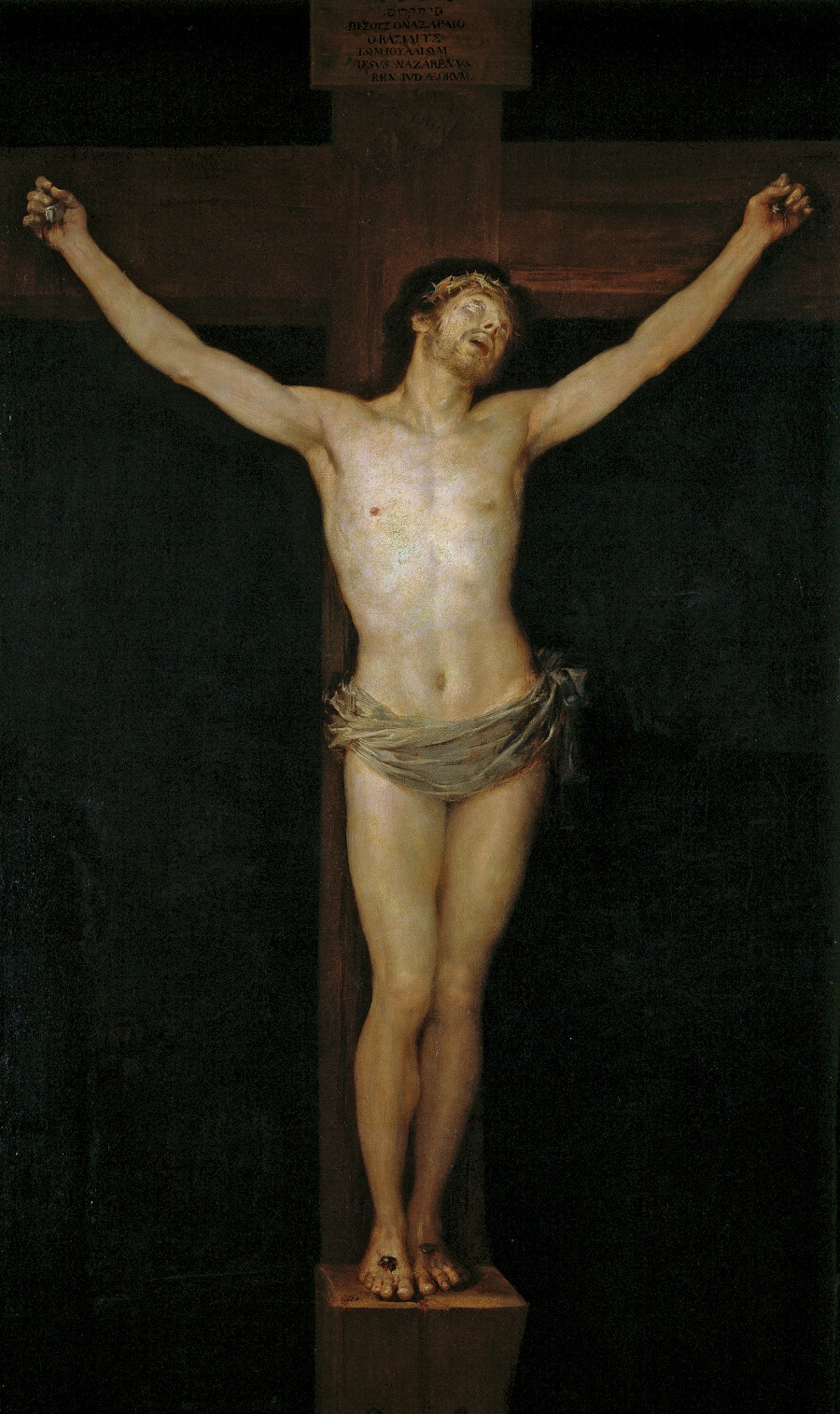
"Christ on the Cross” (1780). Prado Museum
A career on the rise: Jovellanos, Ceán Bermúdez and the Enlightenment
In that era, art and painting were characterized by their ironfisted academicism. Neoclassicism cast a long shadow over artists forced into ironclad and stereotypical constraints based on centuries-old rules. Goya rebels against these impositions and chooses his own path, something that will characterize his work and attitude for most of his life. The 1780s bring him both successes and failures; from the rejection of audiences and academics alike to his Virgin Mary frescoes for the Basilica of the Pillar, to the unreserved acclaim for his "Saint Bernardine of Siena preaching to Alfonso V of Aragón" (1873), created for an altar of the Basilica of Saint Francis the Great. With his fame now well-established, Goya devotes time to painting the portraits of important families and members of the upper classes such as the Duke of Osuna and the Earl of Floridablanca. In fact, the patronage of the Dukes of Osuna was to win him numerous commissions.
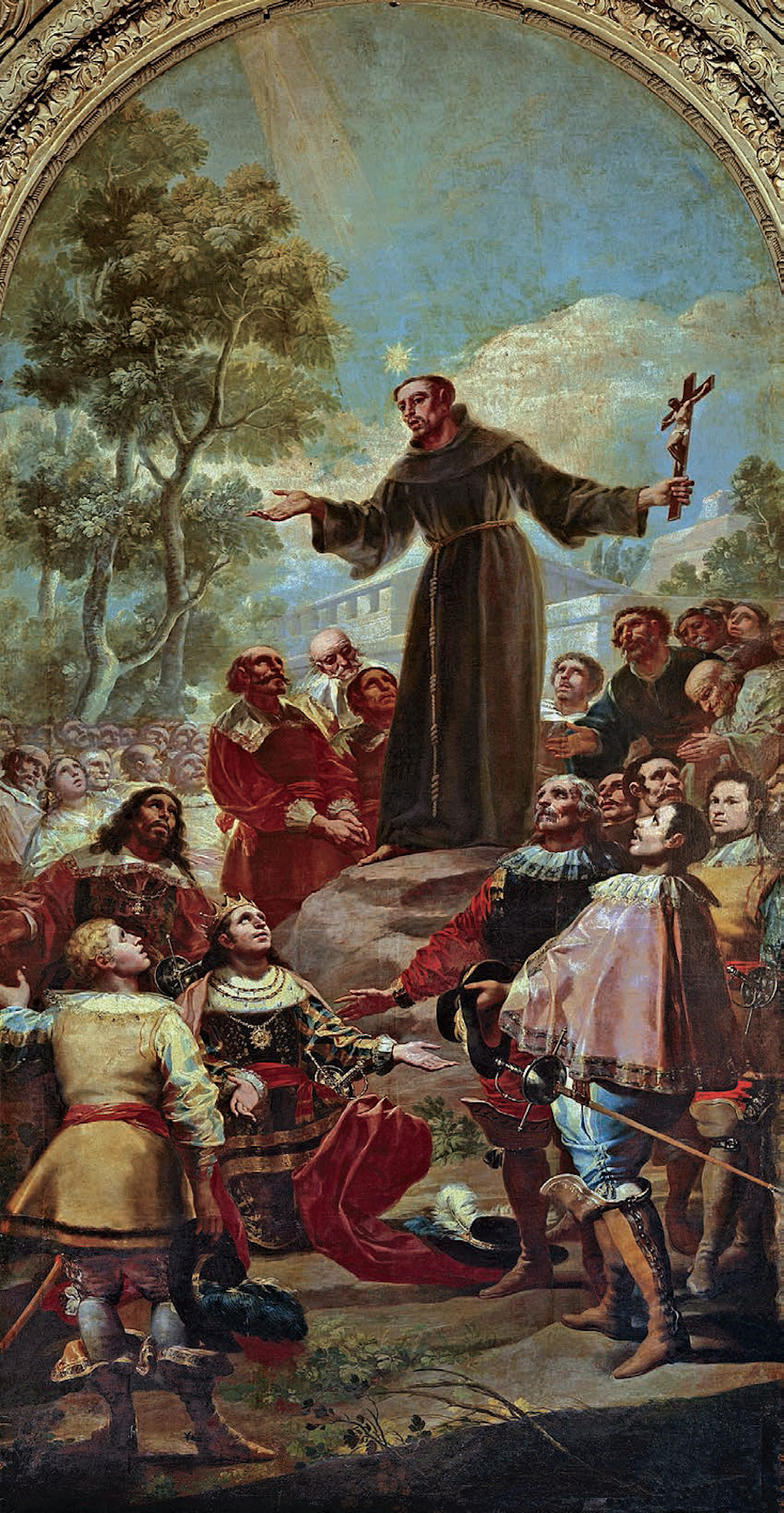
"Saint Bernardine of Siena preaching to Alfonso V of Aragón” (1781-83). Basilica of Saint Francisco el Grande
Goya's anxious soul propels him towards certain environments, individuals and ideas that would become fundamental throughout his life. At this time, he makes the acquaintance of Gaspar Melchor de Jovellanos and the art collector Juan Agustín Ceán Bermúdez. Through these friendships, his career as a painter continues to rise, thanks to the numerous commissions they secured for him. However, these commissions were by no means the most important benefit he receives from his friends: they open the doors to intellectual and reformist circles advocating for the Enlightenment to come to Spain. It is a discovery that impacts the artist, who immediately identifies with these new views on education and politics. These are critical and revealing moments which also affect his painting; his canvasses begin to abandon idealist and perfectionist concepts in pursuit of expressionism, as represented by the exaggerated and the grotesque. Unknowingly, Goya becomes one of the forerunners of a movement that would soon spring up throughout Europe: Romanticism.
Ill health, nudes and war. The time of realism.
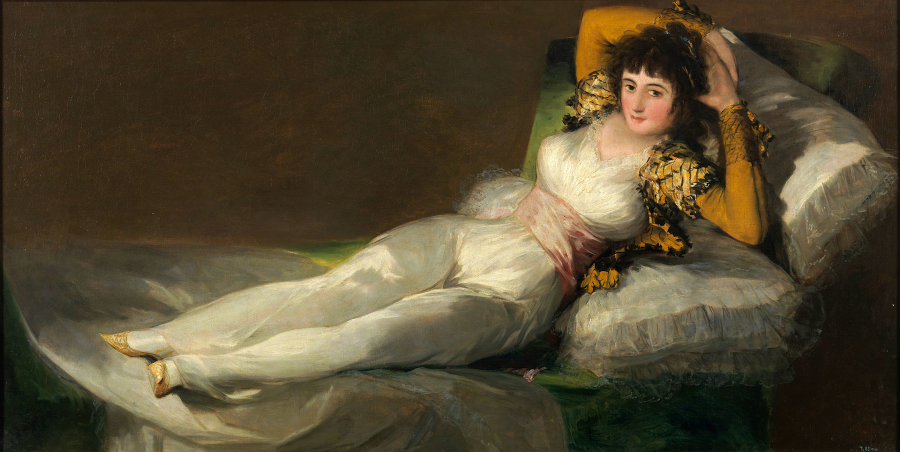
"The Clothed Maja" (1800-1807). Prado Museum
1792 is a dark year in the life of Francisco de Goya. While travelling around Andalusia, he suffers a terrible illness that leaves him profoundly deaf at the age of 46, a deafness that will accompany him until his death and infuse many of his thoughts and paintings with blackness. The painter finds refuge in his art and creates a series of small paintings where the presence of tragedy and crime is strong. However, Goya rises phoenix-like from the ashes and in 1795 becomes Director of Painting at the Academy of Fine Arts of San Fernando. He continues as a portraitist to the nobility, even securing the patronage of the recently-widowed Duchess of Alba. The artist continues to develop his interest in the grotesque, popular folk traditions and social criticism through his engravings, as evidenced in the "Caprichos" (1799). At this time, he also paints his famous works "The Clothed Maja" and "The Naked Maja", which would later bring him the wrath of the Inquisition.
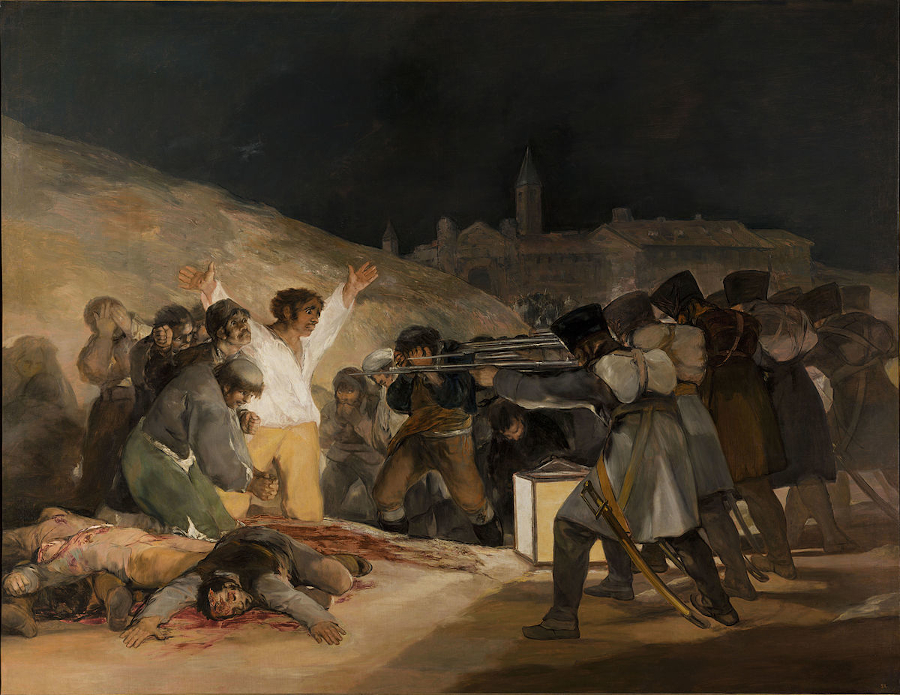
“The 3rd of May 1808 in Madrid" (1813-14). Prado Museum
On the outbreak of the War of Independence (1808-1814), Goya is obliged to be seen to take the government's side, although his output does remain critical in series such as "Disasters of War". His wife, Josefa, dies in 1812 which is when it is believed he begins a relationship with Leocadia Zorrilla. After the war, he continues to work as Court Painter to the king and nobility, even going so far as to paint the portrait of Ferdinand VII, the "Felon King" and self-declared absolute monarch he neither liked, respected nor accepted. However, despite only showing the regime-critical drawings and prints to his most trusted friends, his prudence was insufficient protection from the Inquisition which, in 1815, brought a tribunal against him for his "The Nude Maja". Undeterred, he continues his production of etchings with two emblematic series: "Tauromaquia (Bullfighting)" and the unfinished "Disparates (Follies)".
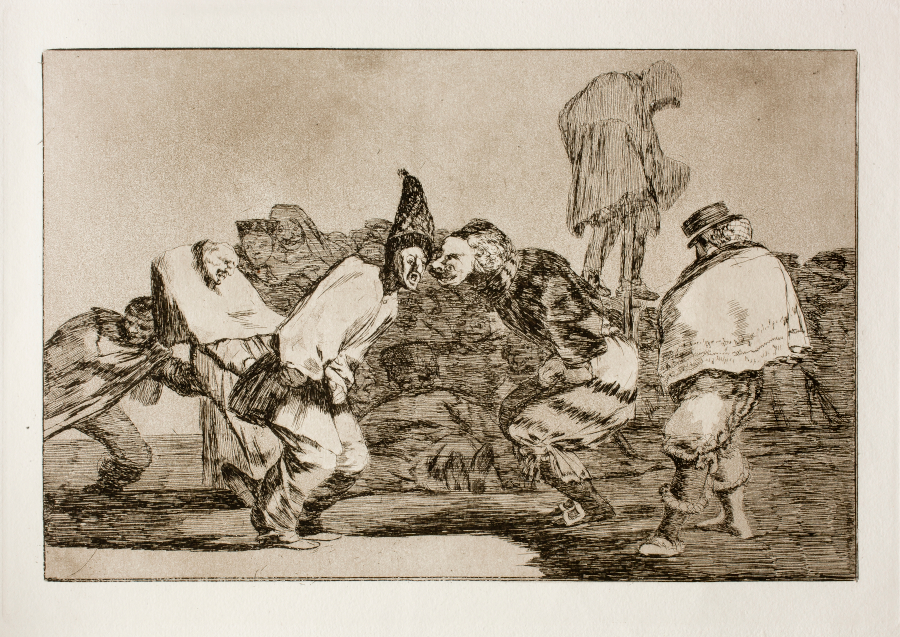
“Carnaval Folly”. Etching 14 from the series “Disparates” (1815). Prado Museum
Final years. The Deaf Man's House and death in Bordeaux.
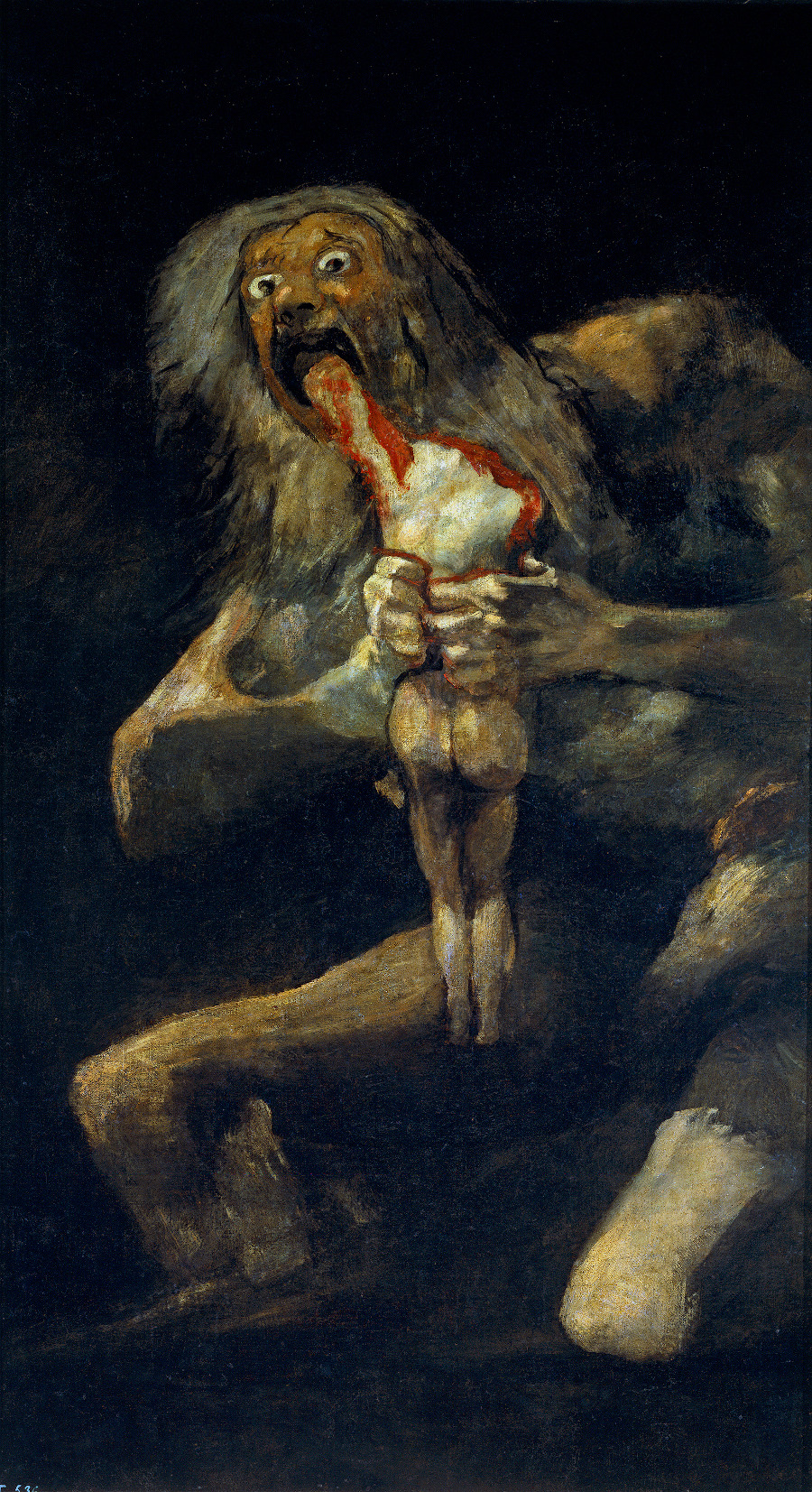
“Saturn Devouring His Son" (1819-23). Prado Museum
By 1819, Goya is 73 years old. The illness, the deafness, his disillusionment with the absolutist government and his problems with the Inquisition have taken their toll on his body, mind and spirit. He acquires the Madrid property he had fallen in love with for its views and ample grounds and it will come to be known as The Deaf Man's House. The elderly painter suffers another severe bout of his illness but lives through it to leave his swansong reverberating around its walls. I refer here to the famous "Black Paintings", where Goya returns to focus on the subjects that had always nested in the depths of his art: death, man's humanity to man, the degradation wrought by the passage of time and the evil hiding in the human soul. In 1824, Goya goes into self-imposed exile in Bordeaux in an attempt to distance himself from the absolutist government he both despised and feared. He is accompanied by Leocadia Zorrilla and her two children, the youngest of whom, Rosario, Goya considers his own daughter and instructs in the art of painting.
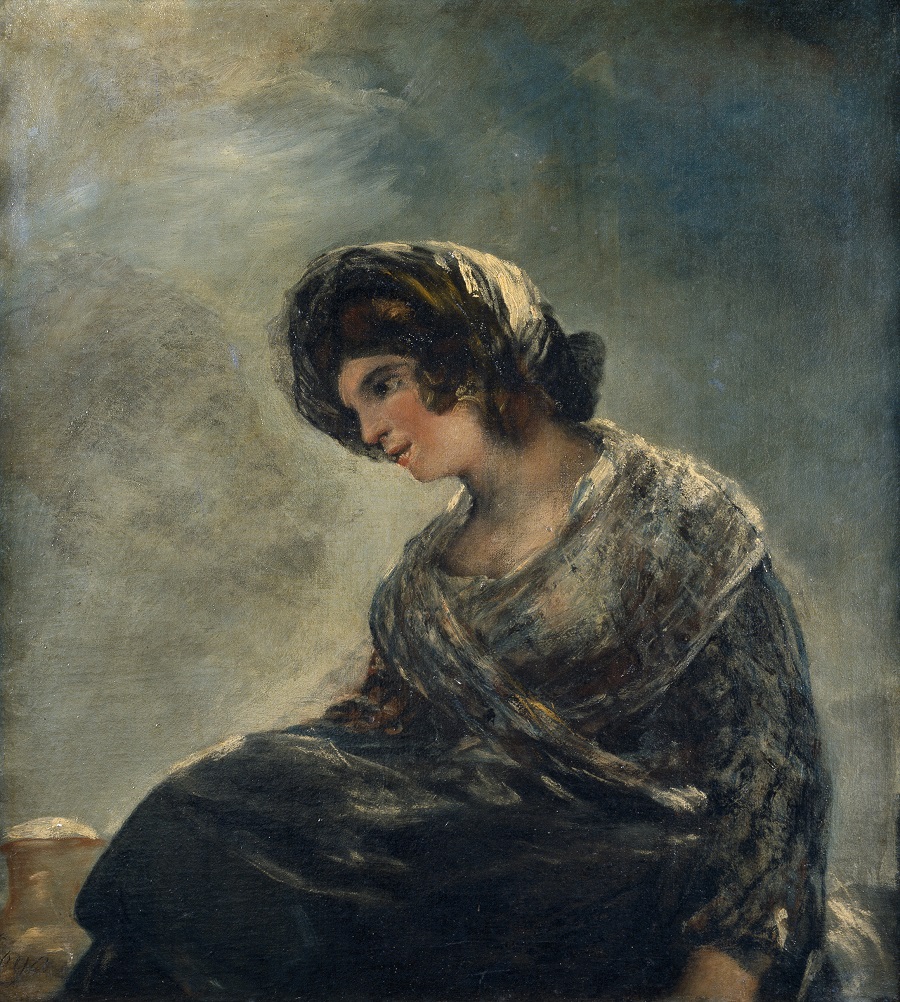
“The Milkmaid of Bordeaux” (1827). Prado Museum
In 1826, Goya is finally able to retire and live out his final years quietly and comfortably-off, dedicated to his graphic work, enriching it with series such as the "New Caprichos", and bullfighting-themed engravings. Standing out among his last works is "The Milkmaid of Bordeaux" (1827), painted a year before his death, that dazzles with its free use of brushstroke, framing, composition and theme, displaying a surprisingly creative and pictorial freedom which foreshadowed the Impressionism of masters such as Renoir and Manet. It should also be pointed out that today, the painting has sparked no little controversy with some experts doubting Goya's authorship and suggesting the possibility that it could actually have been by the hand of his student Rosario. In 1828, Goya dies in Bordeaux, leaving to posterity an oeuvre that is unique in the world, full of creative freedom, modernity, social engagement and beauty.
Exhibitions
Goya in Madrid (2014-15)
The cartoons Goya painted as pattern studies for tapestries were historically considered "minor works". However, these are magnificent paintings in themselves that reveal the master's inimitable hand and foreshadowed artistic movements that would come many decades later. The Prado Museum held an entire exhibition of these cartoons, showcasing them along with those of other artists of the time as well as the paintings and sculptures that served as model and inspiration.
Goya: The Portraits (2015)
In 2015, London's National Gallery celebrated the dazzling work of Goya the portraitist in an exhibition of seventy portraits that, in the institution's own words, "demonstrate his daringly unconventional approach and remarkable skill at capturing the psychology of his sitters." The exhibition included paintings, drawings and miniatures rarely or never-before-seen in the British capital.
Goya and the Enlightened Court, Illustrated (2017)
The Museum of Fine Arts, Bilbao organized this exhibit in collaboration with the Prado Museum and the La Caixa Foundation. The selection included ninety-six works that reflect Goya's activity during his years as a court painter, allowing the public to admire such famous works as "Blind Man's Bluff" and "The Straw Manikin". It was the first ever exhibition dedicated to Goya in the capital of the Biscay province.
Masters of Spain: Goya & Picasso (2018)
Goya shared space with another of Spain's artist greats, Pablo Picasso, in this exhibition organized by the Polk Museum of Art in Florida (USA). More than 50 works of art were on display, including the famous "Tauromaquia" (Bullfighting) series, showcased alongside several pieces created by Picasso on multiple types of media from ceramics to cardboard. Most works were on loan from The Art Company, located in Pesaro, Italy.
Goya. Drawings. "Only my Strength of Will Remains" (2019)
Again in 2019, the Prado Museum dedicated a portion of its exhibition calendar to the work of Francisco de Goya. On this occasion, the exhibition was based on the research and documentation undertaken for the new catalogue raisonné that the museum intended to publish, based on an agreement signed by the Prado and the Botín Foundation. It was the first time that over 300 of Goya's drawings, comprising the Prado's own holdings and loans from collections around the world, were gathered together.
Books
Goya and His Critics. Nigel Glendinning (Yale University Press, 1977 & 2017)
Nigel Glendinning was a renowned scholar on the work of Francisco de Goya. This book, written in 1977 and republished in 2017, is the first document to study the artist and his work through its contextualization in time. The author, who died in 2013, was a pioneer in reflecting on different analyses and studies of the painter's work over decades. The book adds other later studies by the author himself, as well as texts by other experts. In general, this book is considered the most complete study carried out to date on the work of the artist.
Francisco Goya. Life and Works. Valeriano Bozal (TF Editores, 2005)
Valeriano Bozal is a renowned expert on the work of Francisco de Goya and whose contribution can be found in reference books, such as the above-mentioned new edition by Nigel Glendinning. His book Francisco de Goya. Life and Works is an important text for, among other things, the innovative and original point of view it brings regarding the passions and obsessions of the painter. The scholar begins the book with the phrase: "Goya does not lend us his eyes, he opens ours. To the past, to the present." Comprising two volumes, it is an essential work with which to enter the personal world and turbulent times of a once-in-a-lifetime artist.
Goya In Literature. Leonardo Romero Tobar (Marcial Pons, 2016)
Professor of Art Leonardo Romero Tobar has done sterling work on this study, a well-organized and annotated monograph that sheds new light on the work of Francisco de Goya. The text is an extensive collection of annotated bibliographical references, a magnificent contribution for any scholar on the work of the artist. Far from being a collection of quotations and text by the master, the book is a compilation of references that add an interesting analysis of the painter's work, interests and context.
(Translated from the Spanish by Shauna Devlin)
- Francisco de Goya. Biografía, obras y exposiciones - - Alejandra de Argos -
- Details
- Written by Marta Sánchez
"Art has nothing to do with ugliness or sadness. Light is the life of all it touches; so the more light there is in a painting, the more life, the more truth, the more beauty it will have." It is no coincidence that Joaquín Sorolla is known as "the painter of light". The spectacular effects that the Valencian master imprinted on his canvases have yet to be matched by any other artist.
Life through light
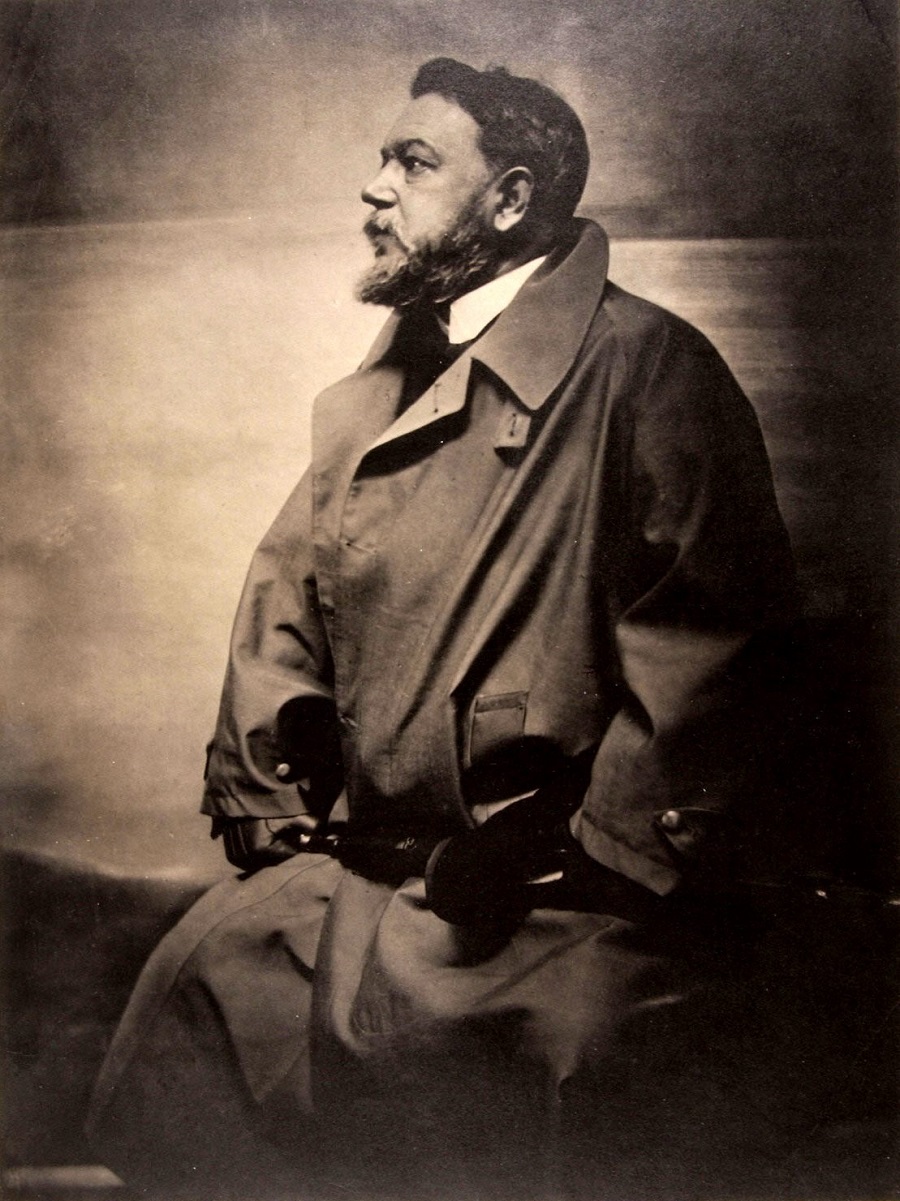
Joaquín Sorolla photographed by Gertrude Käsebier, 1908
"Art has nothing to do with ugliness or sadness. Light is the life of all it touches; so the more light there is in a painting, the more life, the more truth, the more beauty it will have." It is no coincidence that Joaquín Sorolla is known as "the painter of light". The spectacular effects that the Valencian master imprinted on his canvases have yet to be matched by any other artist. The search for life through light was a constant in his work, often imbued with the brightness of the beaches and landscapes of his native Valencia. However, Sorolla's work is not limited to just seascapes, beaches or figures on the seashore. As a painter, he was also a magnificent portraitist and an exceptional portrayer of Costumbrista scenes.
The sheer magnitude of his output would be near impossible to equal, his works coming to almost three thousand paintings, in addition to the more than twenty thousand drawings and sketches he produced throughout his life. His prodigious visual memory enabled him to adopt one of impressionism's remits: that of capturing ephemeral moments or incidents and turning them into works of art. Sorolla was able to remember the light and movement of a scene from a single moment and then capture that scene in his studio. Today, Sorolla's paintings embody and convey the full light of the Mediterranean in each brushstroke and, due to their impressive, innovative qualities, they enjoy a special place in the most important museum collections and art galleries in the world.
Painting, an innate vocation
Joaquín Sorolla y Bastida was born in Valencia in 1863. At the tender age of two years old, the future artist and his sister Eugenia lost their parents to the cholera epidemic sweeping the city. The two orphans were taken in by an aunt and uncle, who assumed responsibility for their education and upbringing. From his earliest years, Joaquin demonstrated an innate passion for art, drawing and painting. His locksmith uncle tried to steer him towards his own trade, to no avail. It was the headmaster at his secondary school who realized how gifted he was and suggested he train at the School of Craftsmen of Valencia. Sorolla enrolled at the age of 13 and two years later moved up to the High School of Fine Arts in Valencia where he was already proving to have extraordinary skills in brushwork and the rendering of realistic images, heavily influenced by Valencian seascape painters such as Rafael Monleón y Torres, among others.
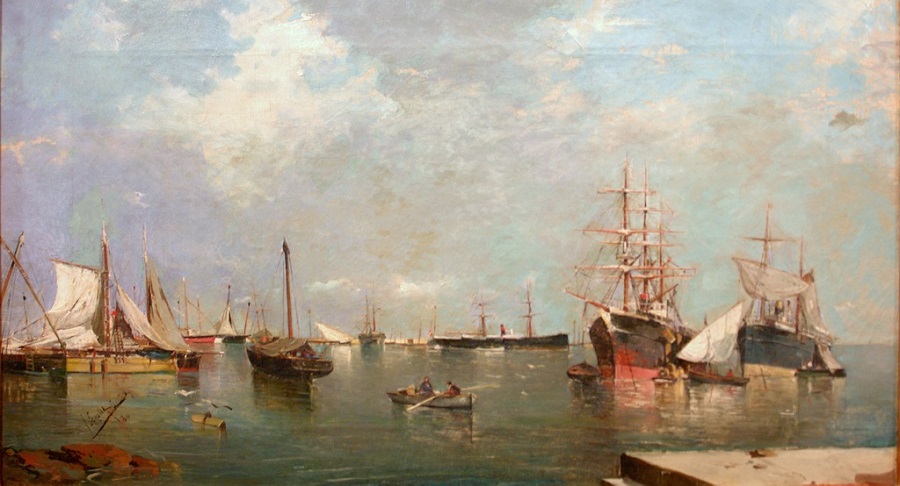
Seascape (1880)
After finishing his studies, Sorolla meets the painter Ignacio Pinazo who introduces him to brand a new way of treating light in painting, a recent trend he had discovered on a trip to Italy. It is the young artist's first contact with Impressionism and, for the rest of his life, his work will adhere to many of its tenets. The fundamentals of this school are already reflected in his first seascapes, three of which he will send to Madrid for participation in the 1881 National Exhibition of Fine Arts. It is around this time that Sorolla met the photographer Antonio García, who would offer him work in his photography studio and whose daughter, Clotilde García, he would end up marrying.
“To get famous, you have to paint dead people"
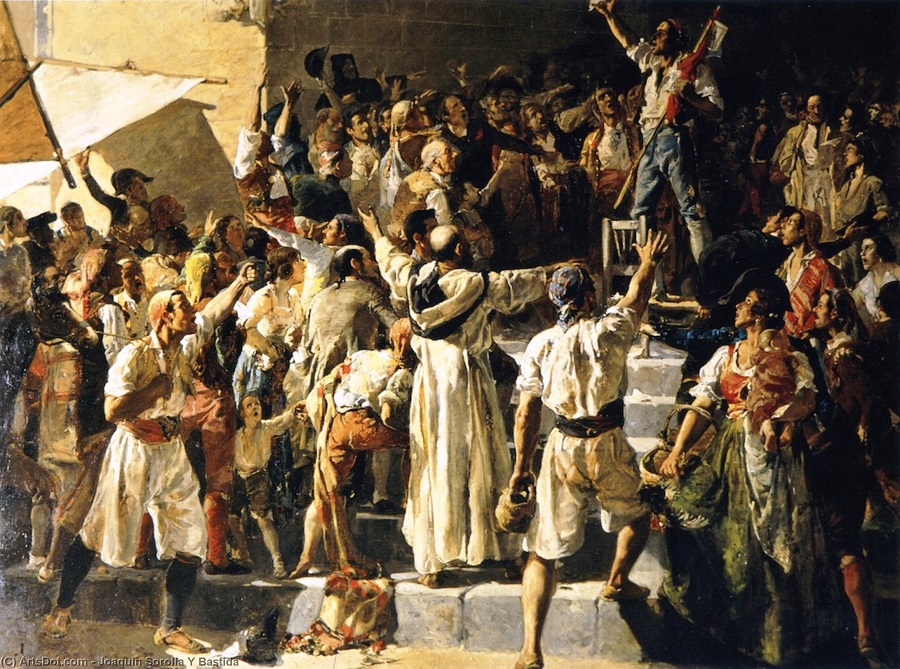
The Cry of the Palleter (1884)
The stringent artistic constraints of late 19th century Valencia did not lend themselves to the restless spirit of the young painter, who nevertheless adapted to its demands in order to succeed. In 1884, the Provincial Council of Valencia convened a painting competition with the winning entry to be awarded a scholarship to complete their studies in Rome. The theme was the 1808 War of Independence. Sorolla submitted his work "The Cry of the Palleter" which made such a deep impression on the jury, they granted him the scholarship. Sorolla accepted the prize with skepticism and irony, confessing to a friend and colleague: "Here, to get famous and win medals, you have to paint dead people."
During this stay in Rome, Sorolla discovers the work of the great Italian Renaissance painters but his admiration is not limited to the classical as he also comes into contact with the work of Mariano Fortuny, whose canvases exert a powerful influence on his future work. This influence is clear in paintings such as "Moor with oranges" in 1887. From Italy, he travels to Paris where he acquires a new social conscience that will see itself reflected in many of his future works. In his early Italian period, he developed the long, powerful brushstroke that would characterize his work in the ensuing years. The presence of light will continue to gain importance in his canvases although this earned him serious criticism in Spain, where it still took precedence over technique and innovation.
Light and social realism. In search of his own style
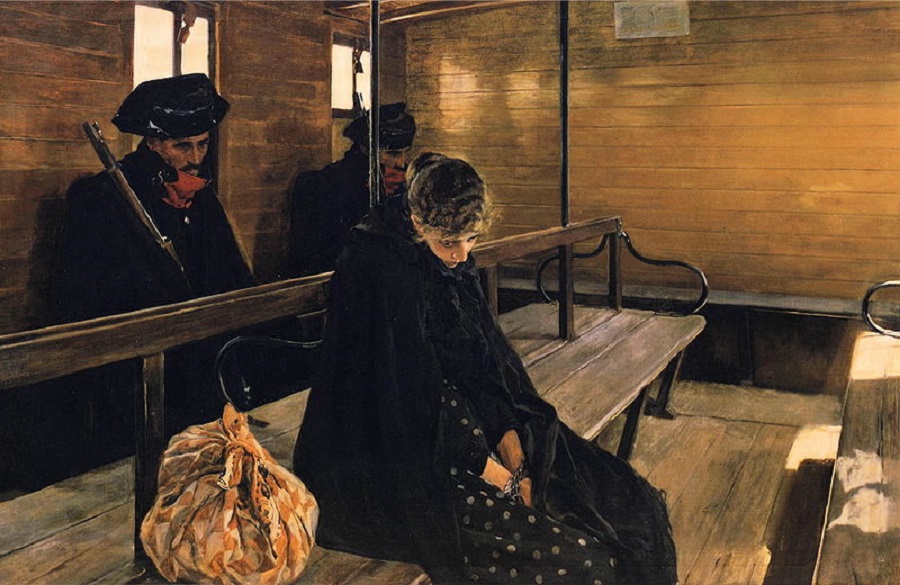
Another Margarete (1892)
By 1889, Sorolla had completed his scholarship and learning period and, accompanied by his now wife Clotilde García del Castillo, returned to Spain where he began a time of consolidation, continuing to search for his own style, which was now beginning to appear in his work. His painting combined passion for the portrayal of an instant in time and light, characteristic of Impressionism, with personal touches (such as long brushstrokes or the use of earthy and black tones). Sorolla also opted to portray topics of a social and realistic nature, which also distanced him from the Impressionism that was triumphing throughout the rest of Europe. A good example is "Another Margarete" (1892), a work depicting an inmate being taken to prison in a train wagon after murdering her son. The title refers to the character of Margarete, one of the protagonists of Goethe's play "Faust". The oppressive and dramatic atmosphere of the canvas is accentuated by the use of light and the depiction of the characters' expressions. It won first prize at the National Exhibition of Fine Arts in 1892.
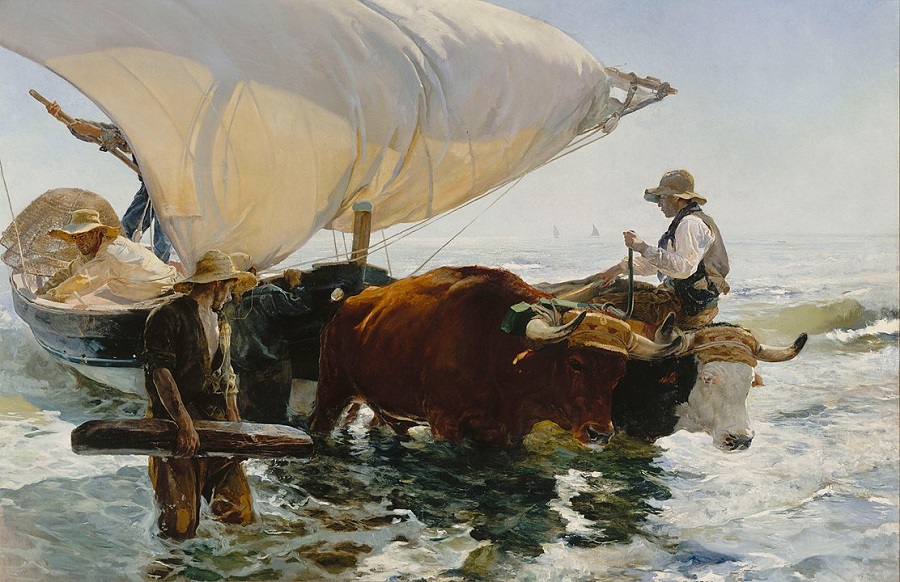
Return Of The Fishing Boat (1894)
In the ensuing years, Sorolla continued to gain recognition, with works such as "And they still say fish is expensive!" and "Return Of The Fishing Boat", both painted in 1894. This latter work in particular marked the moment when he finally hit upon a way to depict light that he had been seeking from the very beginning and which he would adopt in his future works. During these years, he achieved widespread success and popularity, the painting being acquired by the French Government and also winning the Second Place Medal at the Paris Salon in 1895.
On the beach. Brushstrokes and seascapes
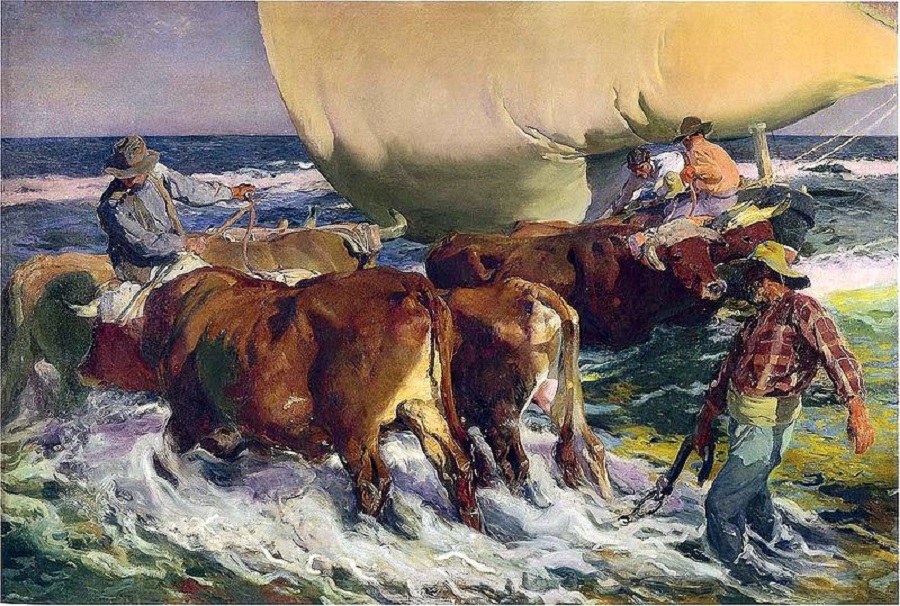
Evening sun (1903)
On the advice of his friend Aureliano Beruete, Sorolla then began working as a portrait artist. He went on to achieve considerable success, painting some of the most important figures in the social, intellectual and political spheres of the day. At the same time, he and his family spent three summers in Jávea, where he painted numerous landscapes, seascapes and beach scenes. The presence of bathers, swimmers, children on the shore and fishing boats became a constant, giving rise to works such as "Evening Sun", from 1903 (considered by Sorolla himself as his best painting).
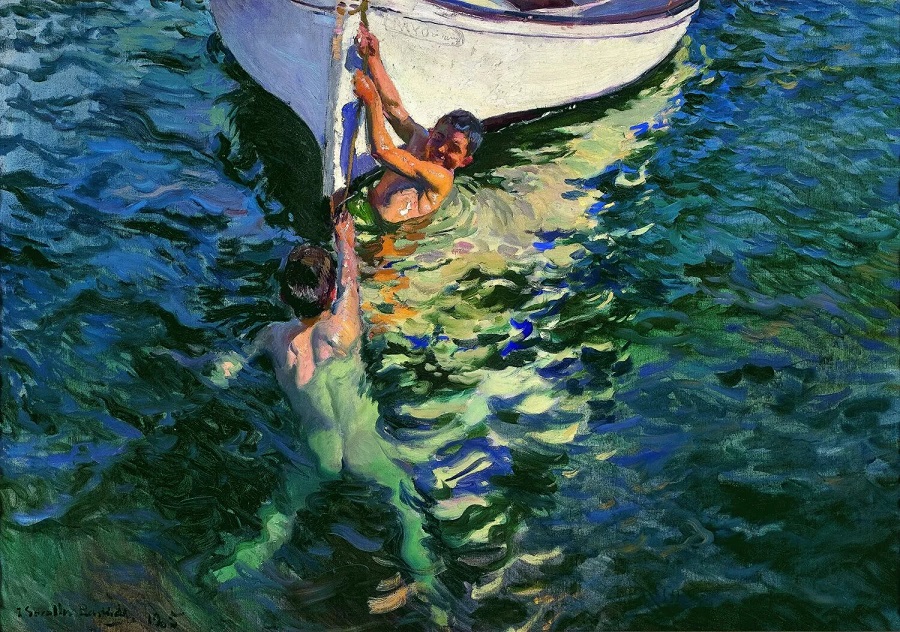
The White Boat (1905)
Sorolla's treatment of light, framing and colour in these paintings is masterful and as personal as it is unique. On the one hand, his work is very much in the vein of Impressionism but, at the same time, breaks away from it, through long brushstrokes and his colour palette. In 1905, he painted one of his masterpieces, "The White Boat", followed by even more famous and lauded paintings such as "Children at the Beach", "A Horse Bathing" or "Seaside Stroll" (all painted in 1909).
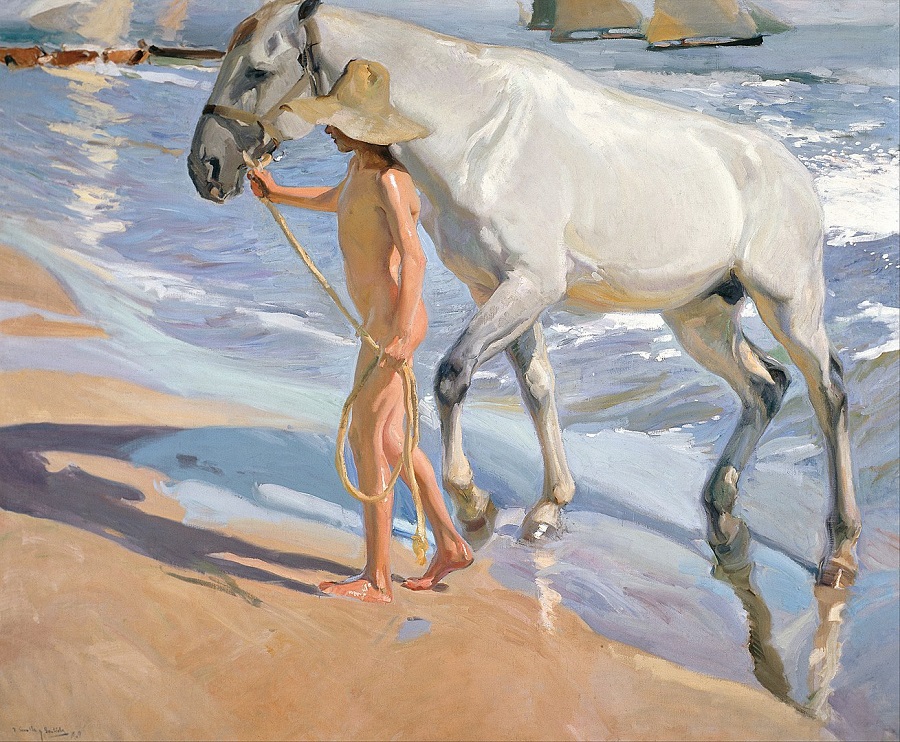
A Horse Bathing (1909)
The Hispanic Society panels: the work of a lifetime
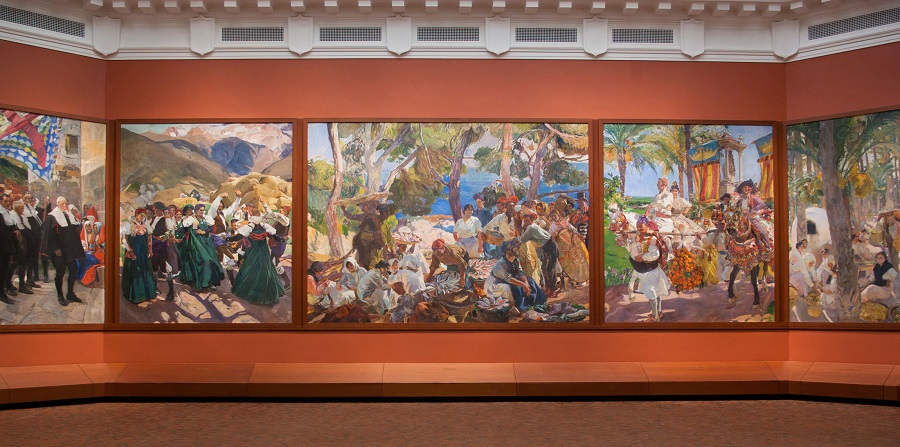
The Sorolla Gallery (north wall), Hispanic Society of America
1911 was a momentous year for Sorolla. The Hispanic Society of New York commissioned him to paint fourteen panels to decorate the library at its headquarters, an enormous task he undertook with enthusiasm, producing a series of paintings depicting scenes from different Spanish regions. Sorolla would define it as his "lifetime's work" and dedicate his final years to its completion. He was then living and working in Huelva from where, in 1919, he sent a telegram to his family announcing he had finished the last painting. The following year, he suffered a stroke that left him unable to travel to New York where he had planned to deliver, assemble and attend the inauguration of his work. The commission would thereby remain unresolved and the contract unsettled until after Sorolla's death in 1923 on the reading of his will.
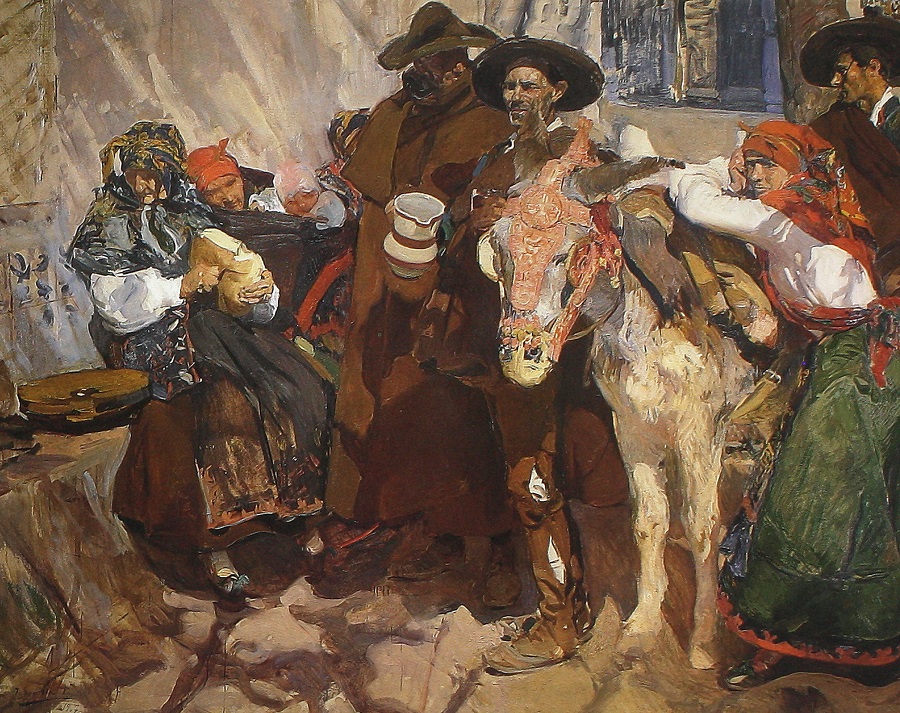
Sorolla Gallery (detail), Hispanic Society of America
In 1926, the gallery was finally inaugurated, bringing to a close a work that perfectly sums up Sorolla's style and technique. Although for a large part of the twentieth century, the advent of avant-garde and new pictorial schools forced Sorolla's work into the background, the latter decades saw a renewed interest in his paintings which, from then on, were to sell for astronomical prices and become much sought-after by museums and private collectors alike. Today, Sorolla is considered one of the greatest artists of the twentieth century and the most skillful at capturing the light of the Mediterranean on canvas.
Exhibitions
Joaquín Sorolla. 1863-1923 (2009)
In 2009, the Prado Museum organized its first retrospective of Sorolla's work. The exhibition was at that time the largest ever held to date, either in Spain or abroad, and brought together more than a hundred paintings. For the occasion, the Prado was loaned all fourteen of the panels that Sorolla painted as a commission for the library of the Hispanic Society of New York.
Sorolla: A Garden To Paint. Bancaja Foundation Valencia (2017)
A total of 120 paintings were selected for this exhibition in his hometown, organized by the Bancaja Foundation. Away from the classic seascapes and beach scenes that make up his best-known works, the exhibition focused on his passion for gardens and his depiction of them in paint. According to Sorolla, these places contained the "emotional parameters" so sought after by himself and other avant-garde painters.
Sorolla and Fashion. Thyssen-Bornemisza Museum and Sorolla Museum (2018)
In collaboration with Madrid's Sorolla Museum, the Thyssen-Bornemisza offered here an unprecedented and novel point of view. The paintings selected for the exhibition analyze the influence of fashion and clothing trends on Sorolla's painting. Seventy works, some of them never before exhibited, were displayed alongside outfits, accessories and garments of the period. Sorolla's canvases are a magnificent chronicle of the trends and fashion of the late nineteenth and early twentieth centuries, painted with the mastery and freedom of technique that characterize his work.
Sorolla: Spanish Master of Light. National Gallery, London (2019)
This retrospective by one of the most important museums in the world was one of the largest exhibitions of the Valencian painter's work ever organised outside Spain. For the occasion, London's National Gallery selected sixty masterpieces that cover the painter's entire trajectory from genre scenes of Spanish life to seascapes, beach scenes, portraits and garden views.
Books
“Eight essays on Joaquín Sorolla y Bastida”. VV.AA. (Nobel)
Successful republication of 'Eight essays on Joaquín Sorolla y Bastida', first published in 1909 on the occasion of the exhibition held that year at the headquarters of the Hispanic Society of America (New York). The exhibition welcomed some 170,000 visitors, which led to the publication of the texts in response to its resounding success. According to Blanca Pons-Sorolla, great-granddaughter and Sorolla expert, it is one of the most important books about her great-grandfather, that deserves to be "in every important museum and library in the world".
“Sorolla. Masterpieces”. Blanca Pons Sorolla. (El Viso)
The aim of this splendid compilation is to become the definitive publication about Joaquín Sorolla and his painting. The book uses high-resolution photographs of the artist's best works, including those that have been restored in recent years. Blanca Pons-Sorolla has personally ensured that the images remain as faithful to the originals as possible, as well as being responsible for the selection and writing of the accompanying texts.
“The Collected Letters of Joaquín Sorolla”. (Anthropos Barcelona)
This book includes the five hundred letters that Joaquín Sorolla exchanged with his friend Pedro Gil Moreno de Mora, who he met in Rome in 1885 during his stay and scholarship there. Although they rarely met up in person, they both kept up the friendship over decades through their correspondence. The letters are documentation of great historical relevance, revealing the intimate personality of the painter as well as his pictorial and artistic concerns.
(Translated from the Spanish by Shauna Devlin)
- Joaquín Sorolla: Biography, Works and Exhibitions - - Alejandra de Argos -
- Details
- Written by Marta Sánchez
Tamara de Lempicka never gave up her independence and freedom. She maintained both thanks to her inate talent for painting, which gave her fame and fortune during her time. Nowadays she is considered the Queen of Art Déco, and her paintings are included in the best public and private colections of the world.
An artist in constant self-reinvention
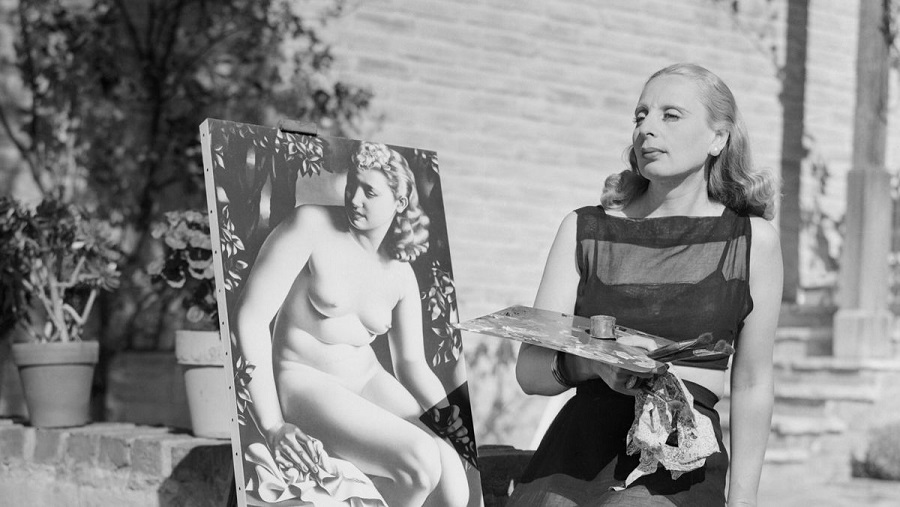
Tamara de Lempicka painting “Suzanne Bathing” (1938)
Tamara de Lempicka was not always acclaimed as an artist. At various times in her life, she enjoyed huge recognition and was, in fact, one of the few women who managed to earn a living as an artist. But in her later years, during the heyday of American abstract expressionism when anything remotely resembling the figurative was shunned, her work lost critical acclaim and even interest. In recent decades, however, de Lempicka's work has been rediscovered and reappraised, and although she figures today as one of the most sought-after artists of the 20th century, her life and character are still somewhat of a mystery - her inherent mythomania having driven her to invent her own narrative in which reality coexisted with pure fabrication.
What we do know to be true, however, is the power, solidity and innovation her paintings brought to the art scene in the first half of the 20th century. In particular, her portraits and female nudes have become the iconographic paradigm of the Art Deco movement, being very much in demand by celebrities and collectors alike. De Lempicka was very clear about who she was and, above all else, who she aspired to be. "I was the first woman to paint pictures that were neat, precise and finished and that was the secret to their success. Out of a hundred paintings, it was always possible to recognise mine. And the galleries tended to centre me in their best rooms because my art was attractive to the public." - something that remains true today with de Lempicka's work attracting thousands of visitors to museums and exhibitions for their remarkable modernity, harmony and timeless qualities.
Childhood in Russia and first contact with classicism
It is difficult to pinpoint the exact date of de Lempicka's birth. Her penchant for reinventing her own story meant she blurred biographical data to such an extent that even the experts are confused. However, many biographers are agreed that she was born in Warsaw in 1898 while, according to the artist, she was born in Moscow in 1907. What is unequivocal, though, is that her father, a well-to-do Russian lawyer, moved the family to St. Petersburg when she was still a child.
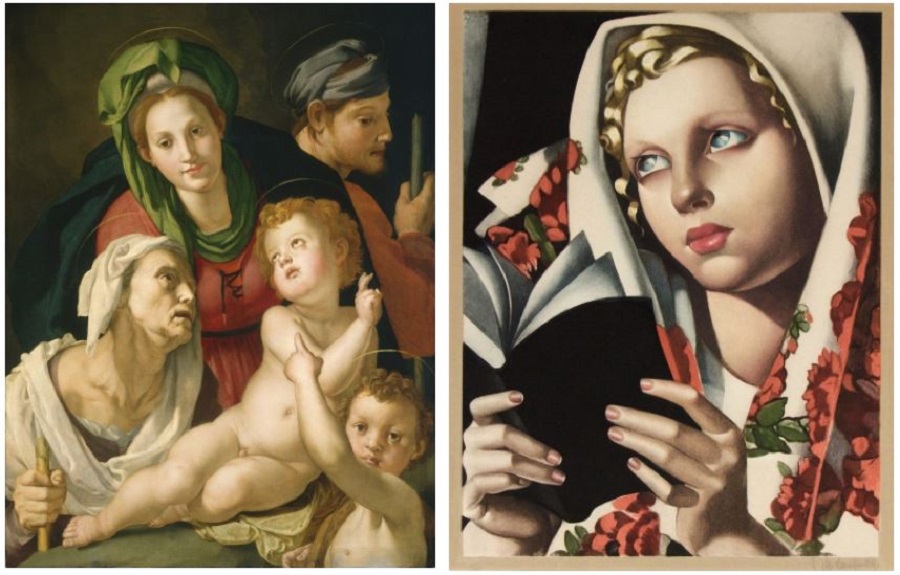
The Holy Family (1527-1528), Agnolo Bronzino. The Polish Girl (1933),Tamara de Lempicka
During her childhood, de Lempicka's first contact with art had a deep impact on the budding painter's impressionable young personality. Her aristocratic grandmother took her on a trip around Italy in 1911 when she was just 13 and which she later described as: "Suddenly, I came across works painted in the 15th century by Italian artists. Why did I like them so much? Because they were so clear, so sharp ..." The clean lines and saturated surfaces characteristic of Italian Mannerists were to exert a powerful influence on her art, an influence that would last for the rest of her life.
Escape to Paris and years of artistic training
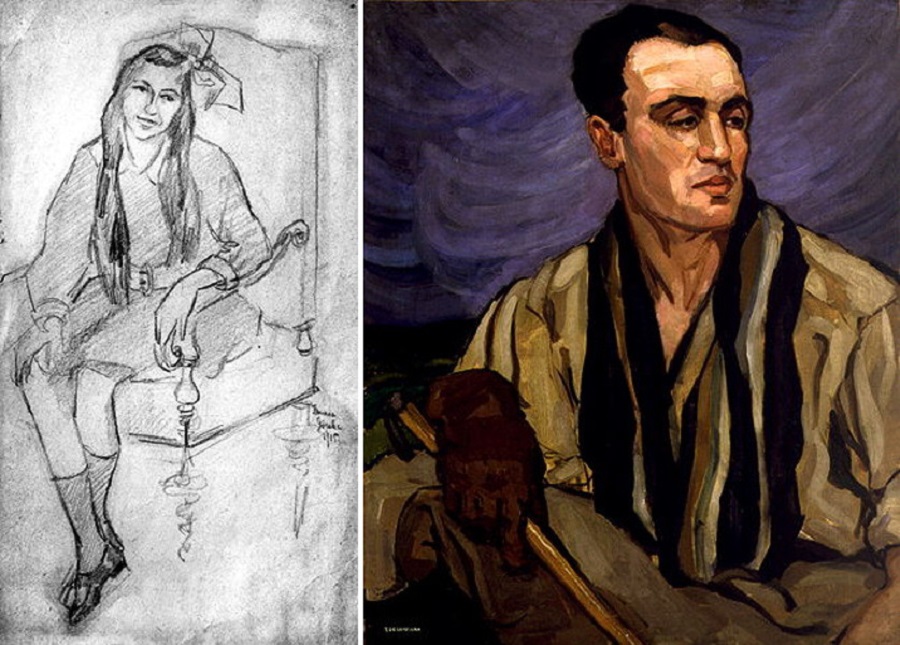
“Portrait of Irena Kleinman” (1915) and “Portrait of a Polo Player” (1922)
Despite her obvious passion for art, the future artist did not take up painting during her teenage years. As was usual at the time and in the wealthy social class to which she belonged, at just 18 she married the Russian lawyer Tadeusz Lempicki and had a daughter, Kizette. It is a year of luxury and glamour and the couple are the toast of society salons and dinner parties just before the eruption of the Russian Revolution in 1917. And then things change radically: Lempicki is imprisoned and only freed thanks to the perseverance of his young wife, who leaps into action and appeals time and again, office by office, for his release. The Lempicki family flees to Denmark and then to Paris, where they are forced to confront a new adversary in the form of financial hardship and a lack of the luxuries to which they had been accustomed. Her sister Adrienne, who lived in Paris at the time and was fully integrated into the modernity of the city (which advocated for the liberation of women and their equality with men in terms of rights and obligations), gives her the best advice of her life: "get a career and you won't have to depend on your husband."
In later life, de Lempicka would define herself on various occasions as a self-taught artist. During her early adulthood, however, she studied at several Parisian institutions, from the Académie de la Grande Chaumiére (where she trained under the Symbolist painter Maurice Denis) to the Académie Ranson, founded by the Fauvist Paul Ranson. She also spent whole days at a time in the Louvre, soaking up the work of the masters. But, without a doubt, her greatest mentor was the fauvist André Llhote, from whom she absorbed and internalized the ability to capture solidity and volume in forms, while applying some of the fundamentals of Cubism (especially the fracturing of perspectives and the distortion of shape).
On society's margins: the 1920s
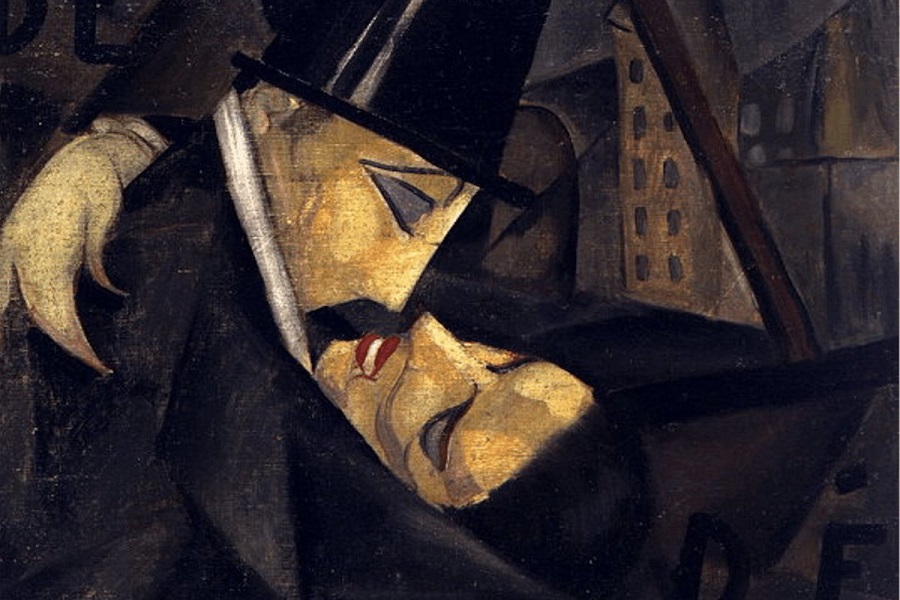
“The Kiss” (1922)
"I live life on the margins of society, and the rules of normal society don't apply to those who live on the fringe." de Lempicka once said. She always considered herself an exceptional, privileged person and took pains to create and maintain a close relationship with the highest aristocratic circles and uppermost echelons of the avant-garde of her time. It was in 1922 that she added the "de" (of) to her surname and began modifying and creating her new biography. De Lempicka was a regular at literary salons where cocaine, hashish and alcohol flowed freely and, as Jean Cocteau once commented, she adored "art and high society in equal measure". Her bisexuality, widely tolerated by the circles she moved in, is faithfully reflected in many of her works. The artist's paintings leave no doubt as to their celebration of the female body in all its potency and solidity, and in their depictions of love and sexual attraction between women.
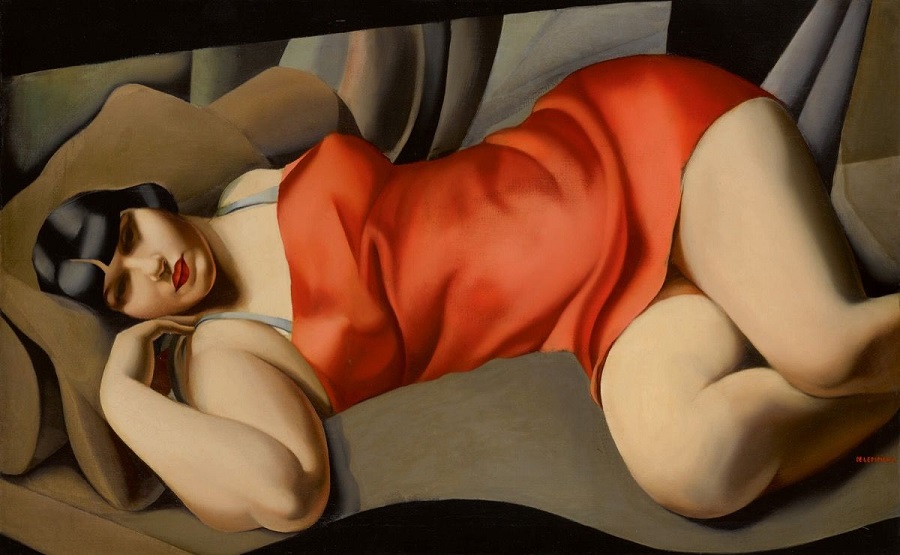
“La Belle Rafaela” (1927)
Works such as "Group of Four Nudes" (1925) or "La belle Rafaela" (1927) show tightly-cropped areas totally occupied by close-ups of naked female bodies in openly sexual positions and with the flat, geometric and sharply outlined style that have made de Lempicka's work the paradigm of Art Deco. The influence of 19th century masters is evident in these works and clearly linked to the paintings of Ingres and Manet. Like the latter's "Olympia", Rafaela was a prostitute from Marseille (and also one of her lovers) but, unlike the woman portrayed by Manet, de Lempicka's Rafaela is virile, voluptuous and totally indifferent to 'the male gaze' and male judgment. Also around this time, she paint the portraits of many aristocratic figures, thanks to the sale of which she was able to maintain her high standard of living.
Success, separation and war: getaway to the U.S.A.
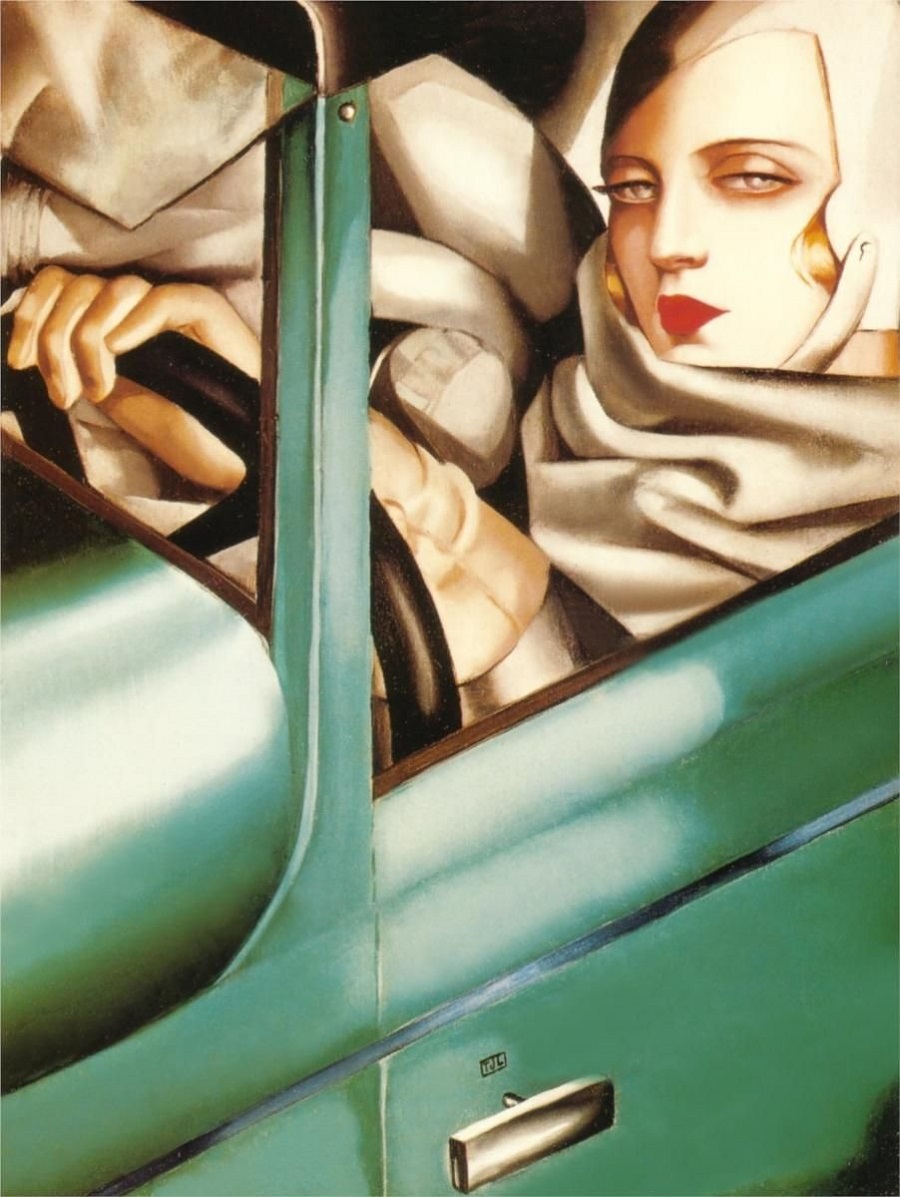
“Self-portrait in a green Bugatti” (1929)
In the 1920s, de Lempicka became the darling of the aristocratic, high society set but it was in the late 1920s and early 1930s that her success reached its height. In 1929, she painted one of her most famous works, "Self-Portrait in a Green Bugatti", that would become the most famous and recognizable icon of Art Deco painting. On the canvas, the subject looks defiantly at the camera and paints herself in the driving seat usually occupied by men. It was commissioned for the front cover of the German fashion magazine Die Dame (The Lady) and is a compendium of the artist's unique and personal style: fully covered surface, geometric and outlined areas, metallic reflections that make it almost impossible to distinguish between metal and fabrics, and a blatant challenge to 'the male gaze'. This period of success is followed by a dark time for de Lempicka: that same year she divorced her husband and, in 1933, her commissions began to dry up due to the economic crisis occasioned by the Great Depression.
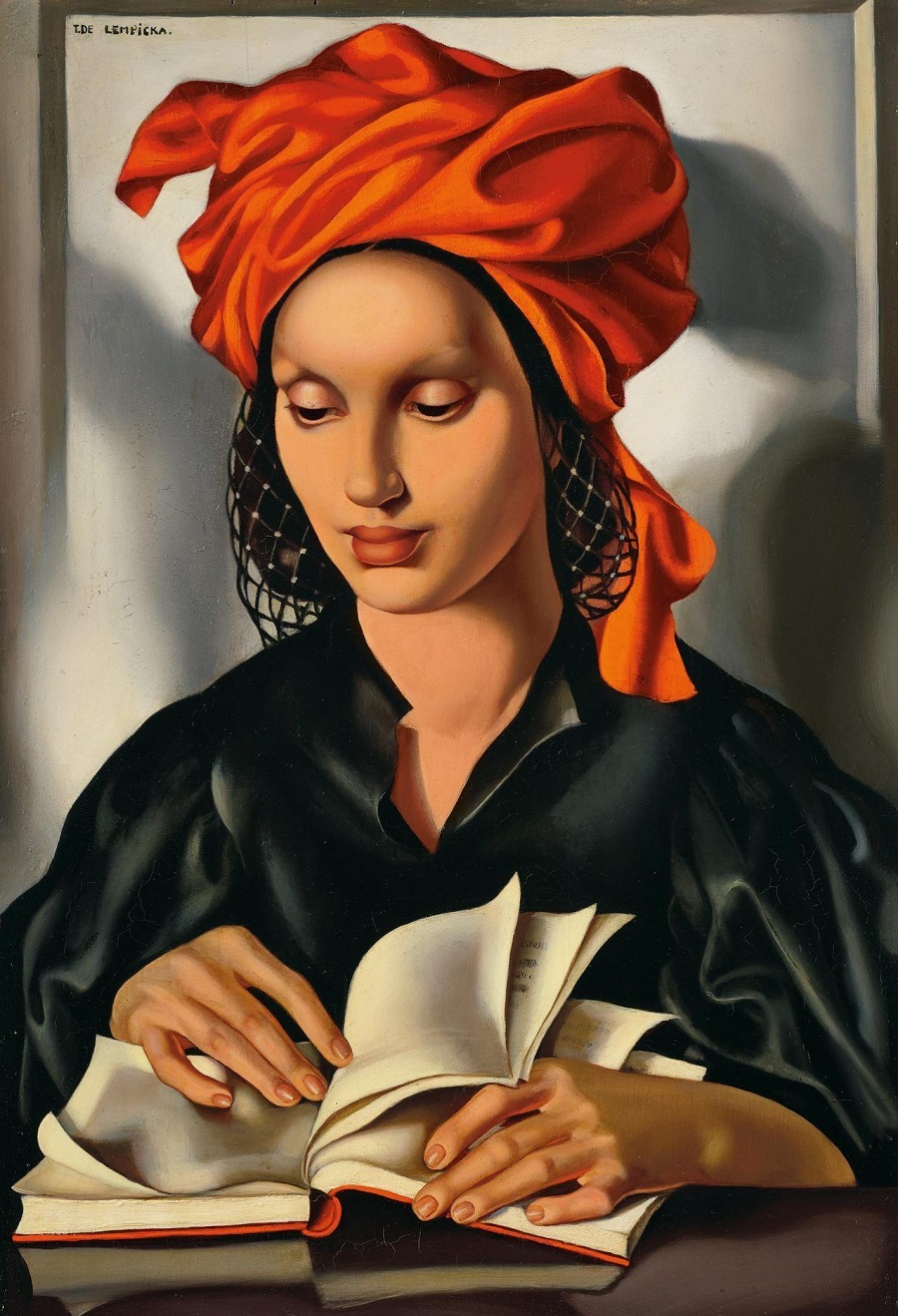
"Wisdom" (1940-41)
In 1939 and on the brink of WWII, de Lempicka marries Baron Raoul Kuffner and the couple move to the United States. She chooses a destination to match her aspirations and lifestyle: Hollywood. However, the reception afforded her in the United States is not what she expected - in her new home she is considered a "hobby" artist who painted for fun. In 1949, they move again, this time settling in New York where she continues to paint but in a style more reminiscent of the Old Masters than her work from the 1930s. She also dabbles in interior design, creating makeover projects for the homes of high society clients.
Final years in Mexico
In 1962, Lola's Gallery in New York held a solo exhibition of de Lempicka's work. The critical reception was lukewarm but she persevered with her painting, regardless. That same year, her husband died suddenly and she moved to Houston to be closer to her daughter who lived there. In her final years, de Lempicka decided to move to Mexico, a country that became her final home, having always been close to her heart.
In 1972, the Luxembourg Museum in Paris organized an exhibition that rekindled public interest in her work and brought about the artist's reconciliation with critics. In 1980, de Lempicka died and, following her express wishes, she was cremated and her ashes scattered around the foothills of Popocatepetl volcano.
Exhibitions
Tamara de Lempicka (2015)
In 2015, the Italian city of Turin exhibited the well-known "Girl in Green", on loan from the Pompidou Centre in Paris, which triggered a large retrospective of de Lempicka's work that filled out galleries in the Polo Reale museums and the Chiablese Palace.
The many faces of Tamara de Lempicka (2019)
“The many faces of Tamara de Lempicka” was the name the Kosciusko Foundation of New York chose for its retrospective of the artist. The exhibition afforded the public an opportunity to admire a wide selection of paintings and drawings documenting the artist's life during the nearly six years she spent in the artistic capital of America.
Tamara de Lempicka: Queen of Art Deco (2015)
In 2019, The Gaviria Palace organized a grand exhibition on the "Queen of Art Deco", with a view to reigniting the Madrid public's interest in de Lempicka's painting. The retrospective brought together over 200 works in total, loaned by nearly 40 public and private collections against a backdrop of magnificent Art Deco design objects from the period.
Books
“De Lempicka”. Giles Néret (Taschen)
The German publisher Taschen does an excellent job of compiling de Lempicka's oeuvre in this essential guide. In it, historian, journalist and art conservator Gilles Néret frames the painter's work within the collective memory of the 1920s and the history in general of women artists.
“Passion by Design. The art and times of Tamara de Lempicka (Revised)”. Kizette de Lempicka-Foxhall (Abbeville Press)
Who better than her own daughter, Kizette, to do a fascinating analysis of Tamara de Lempicka, the person? To this day, the book remains the definitive compilation of her life and work. The new edition is illustrated with excellent reproductions of her most famous works and includes never-before-seen documentation, including private photographs from family albums. The introduction is written by Marisa de Lempicka, great-granddaughter of the painter.
“Tamara de Lempicka”. Virginie Greiner and Daphné Collignon (Planeta Cómic)
Nothing like art to illustrate (or recreate) part of de Lempicka's life. In this case, it is that of V. Greiner and D. Collignon, creators of a graphic novel full of beauty and passion. A book that reflects de Lempicka's talent, freedom and powerful personality in fictional form.
(Translated from the Spanish by Shauna Devlin)
- Tamara de Lempicka: Biography, works and exhibitions - - Alejandra de Argos -
- Details
- Written by Marta Sánchez
Long after her death, Frida Kahlo has ultimately transcended her own reality. From revolutionary painter, creator of intimate worlds and a woman tortured and wronged but also open to love, her public image has since become that of a veritable icon, perhaps even to the point of tipping over into a dangerous banality. But the millions of images of the artist that have become merchandising do not in any way detract from the enormous power of her work.
Art with wings to fly
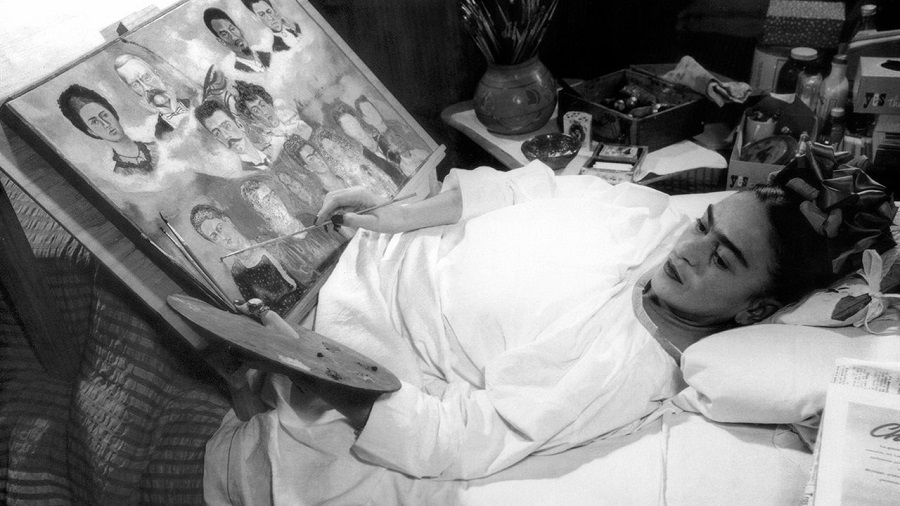
Frida Kahlo painting “Portrait of Frida's Family”. Photo: Juan Guzmán,1950-51 from www.historia.nationalgeographic.com.es
Long after her death, Frida Kahlo has ultimately transcended her own reality. From revolutionary painter, creator of intimate worlds and a woman tortured and wronged but also open to love, her public image has since become that of a veritable icon, perhaps even to the point of tipping over into a dangerous banality. But the millions of images of the artist that have become merchandising do not in any way detract from the enormous power of her work. Kahlo's potential and talent flourished through sickness, suffering and prostration. In her own words, "Everything can be beautiful, even the worst horror". She was also able to turn herself into works of art with their own entities, following in the wake of other artists such as Salvador Dalí.
Rooted in her own culture and a lover of beauty (her own and others’, within and without), Kahlo’s image and persona enjoy actual cult status in Mexican society, where portraits of her even take pride of place in altar places dedicated to other saints. In life, Kahlo was faced with a terrible reality and used art to show her suffering, overcome it and learn to live with it. And she did not have far to go in order to create her own personal imaginary, so admired by artists like André Breton, saying "I never paint dreams or nightmares. I just paint my own reality."
Childhood, apprenticeship and tragedy. The early years.
Magdalena del Carmen Frida Kahlo was born in the famous Casa Azul (The Blue House) in Coyoacán, Mexico City, in 1907. Her father, Guilermo Kahlo, had emigrated to Mexico from Germany in 1890, at the age of 19. Frida was the third of four children to Matilde Calderón, Guilermo’s second wife, the first, with whom he had had two other daughters, having died in 1884. In her early childhood, the budding artist lived a life of luxury, resulting from her father's profession as a jeweler to Mexican high society and his work as a photographer, which he took up after his second marriage. However, after the end of Porfirio Díaz's rule (known as "The Porfiriato"), the family began to experience serious money problems.
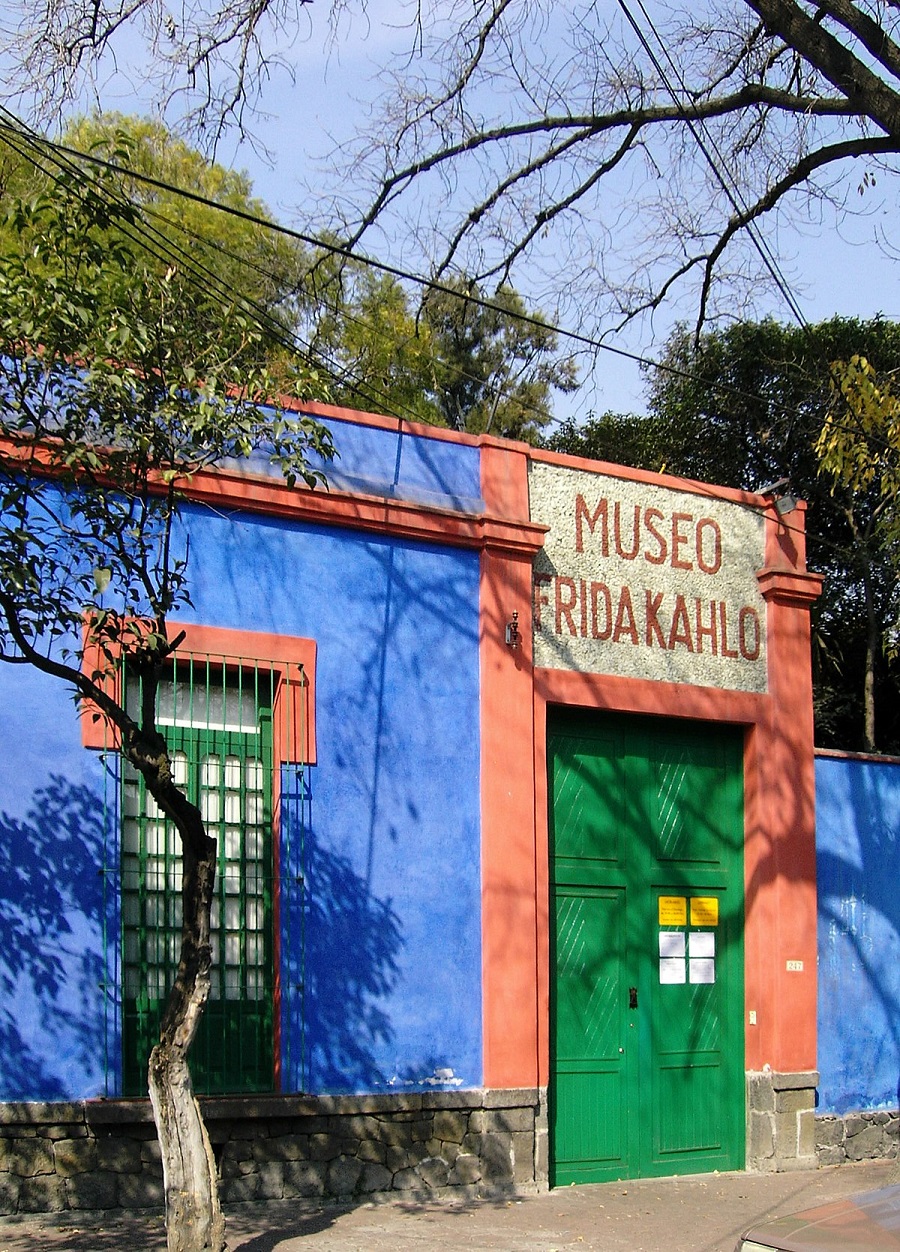
La Casa Azul, now the Frida Kahlo Museum
In 1913 and at the age of six, Frida was diagnosed with polio and bedbound for 13 months, her first contact with the disease which was to become a permanent shadow throughout her life. Although she managed to recover and despite her right leg being seriously deformed, as a little girl she was already showing early signs of her ability to overcome adversity and began assisting her father in his work, participating in tasks such as developing, retouching or taking photographs. This collaboration was her first, and a fundamental, contact with art.
In 1922, Kahlo enters the National Preparatory School where she comes into contact with the most progressive ideas of her time. Intelligence and talent are her best defense against the taunts occasioned by her limp but her forceful personality wins out and she becomes a member of the group ‘Los cachuchas’, where she meets her first boyfriend, Alejandro Gómez Arias. In 1925, the bus on which they were both travelling collides with a tram. The accident causes Frida multiple fractures throughout her body and greatly exacerbates the poliomyelitis in her right leg.
Painting as salvation and a means of expression
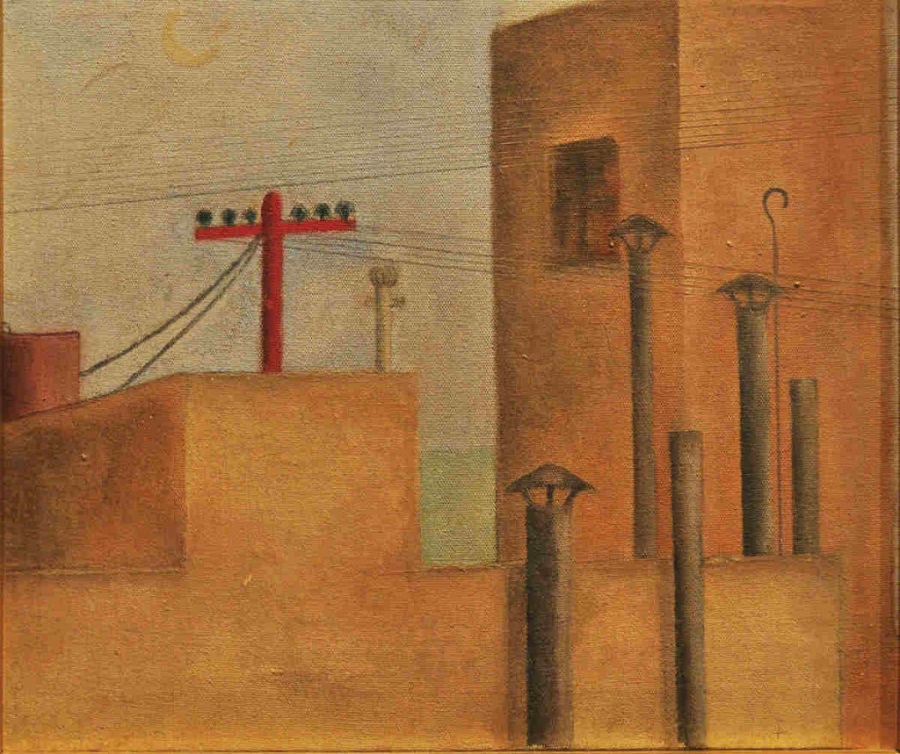
“Urban Landscape”, circa 1925. From arquine.com
Bedridden, her father gifts her a box of paints and brushes. It is the beginning of her unbridled passion for the art that would be her companion throughout countless periods of prostration and serve as psychological alleviation from the constant pain that would never leave her while she lived. As Frida herself described it, she began painting in bed "with a plaster corset that went from the collarbone to the pelvis", with the help of "a very funny device" - an angled contraption devised by her mother to support a stiff board and paper.
In one of her earliest works, "Urban Landscape" (circa 1925), some of what would become constants in her pictorial trajectory were already discernible. Painting was not an end in itself but a means by which to explore reality and portray a series of sensations. The landscape, anodyne and austere, is not of the utmost importance. According to the writer and biographer Araceli Rico, the work shows a space that is "narrow, reduced to inconceivable dimensions [...], a small theatre staging her own life".
Exploring her identity. Self-portraits
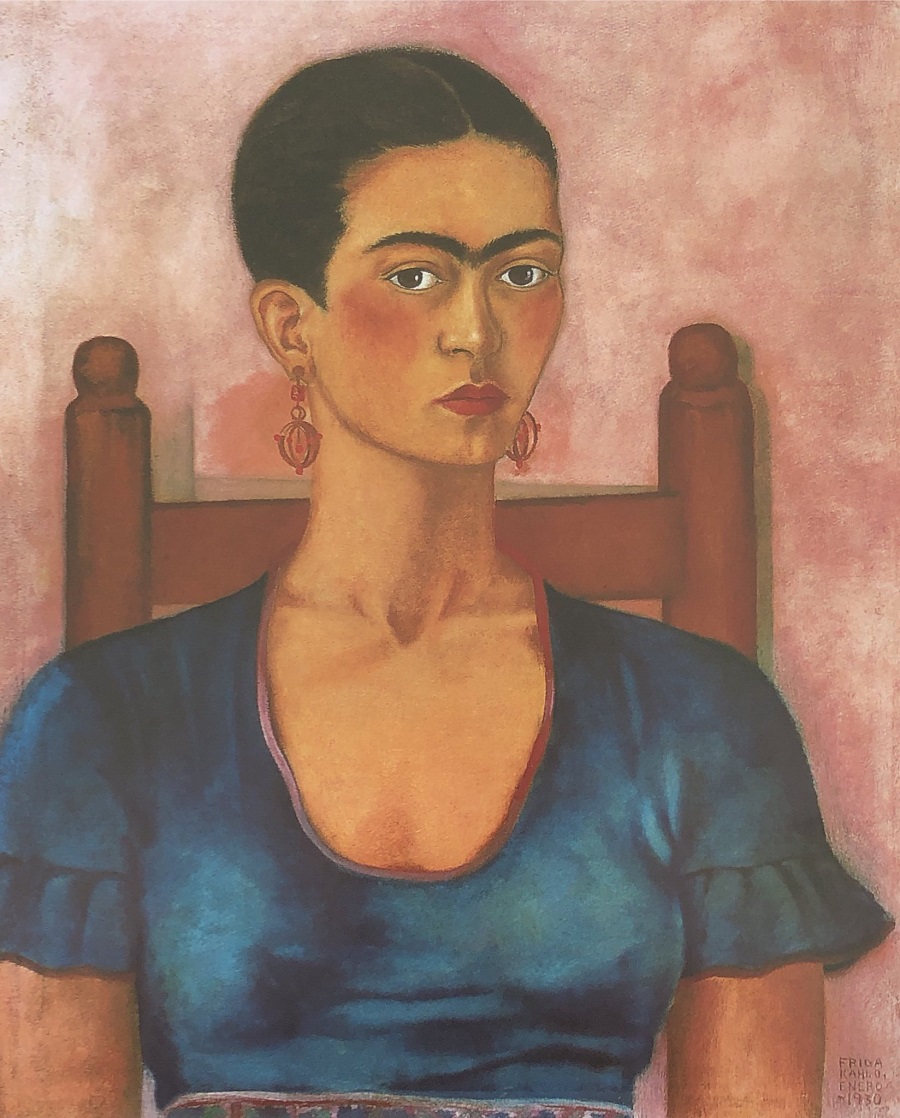
“Self-portrait” (1930). From westwing.es
Kahlo's enforced prostration led her to examine her own person, her body and her identity. A mirrored panel above the bed allowed her to embark on the famous series of self-portraits she painted throughout her life. At first, they were austere portraits of a woman with piercing eyes but over time, they would also come to reflect raw emotion, suffering, passion and desire. And although these works would make her an "object of desire" for the Surrealist movement led by André Breton, she never saw herself as a Surrealist painter: in her own words, "Surrealism doesn't correlate with my art. I don't paint dreams or nightmares. I paint my own reality, my own life."
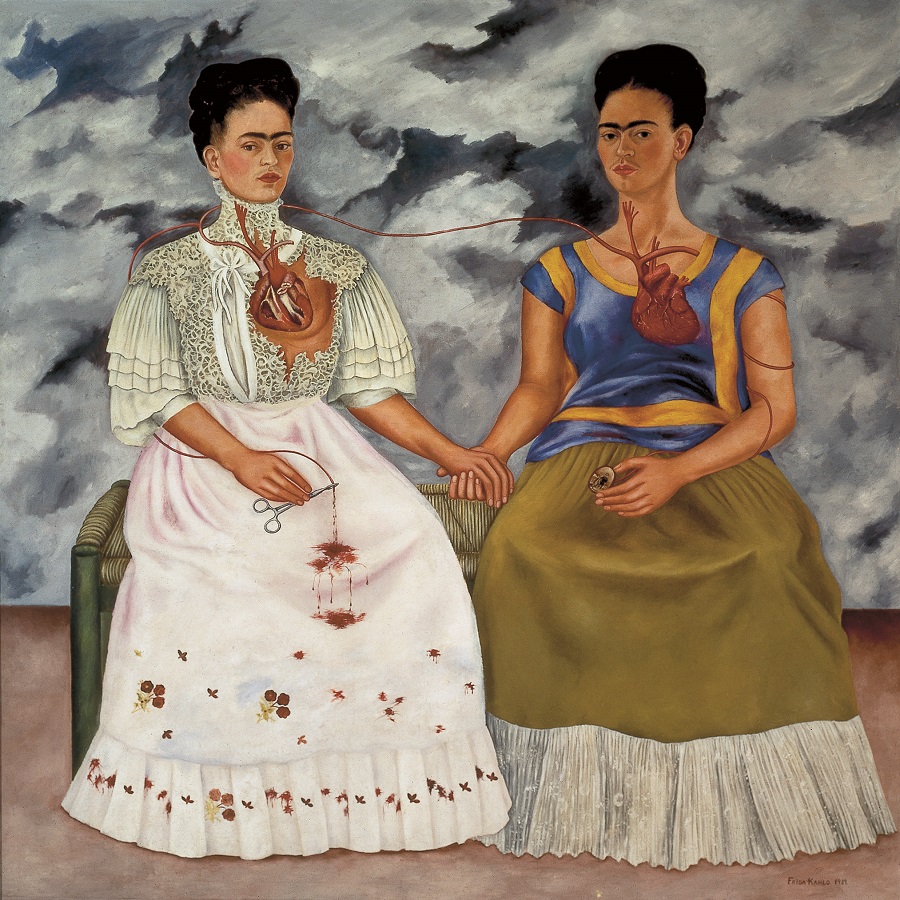
“The Two Fridas” (1939). From inbal.gob.mx
Throughout her life, the exploration of self-identity was a constant in Kahlo's work. In addition to the self-portraits that constituted the most common subject matter of her artistic output, she also reflected on her family ancestry, her friends, romantic partners and close relatives. All of them blended the powerful, primary colors so characteristic of Mexico's plastic and aesthetic cultures, their emotions expressed through visual metaphors: thorn necklaces, animals, blood, tears, corsets ... Her first self-portrait was dedicated to her then boyfriend, Gómez Arias, who distanced himself from her after the accident. Although Kahlo suffered deeply from the breakup (while the young lawyer downplayed their relationship), she would keep in touch with him for the rest of her life.
Diego Rivera. Love, loathing and despair
“Diego and I” (1949). From i.pinimig.comm
The accident that destroyed Kahlo's skeletal structure was never an obstacle to her social and cultural activities. From adolescence on, she was no stranger to Mexico City's artistic and political circles. Through the photographer Tina Modotti, she was introduced to the muralist and painter Diego Rivera, who would become the love of her life in a relationship marked by passion, disillusion, jealousy and infidelities. Kahlo painted him on several occasions and described her feelings for him in her diary with phrases such as "I feel that since our very origins, we've been together, that we're of the same matter, on the same wavelength, that we carry within us the same sensibilities" making clear the intensity of her love which was both powerful and destructive.
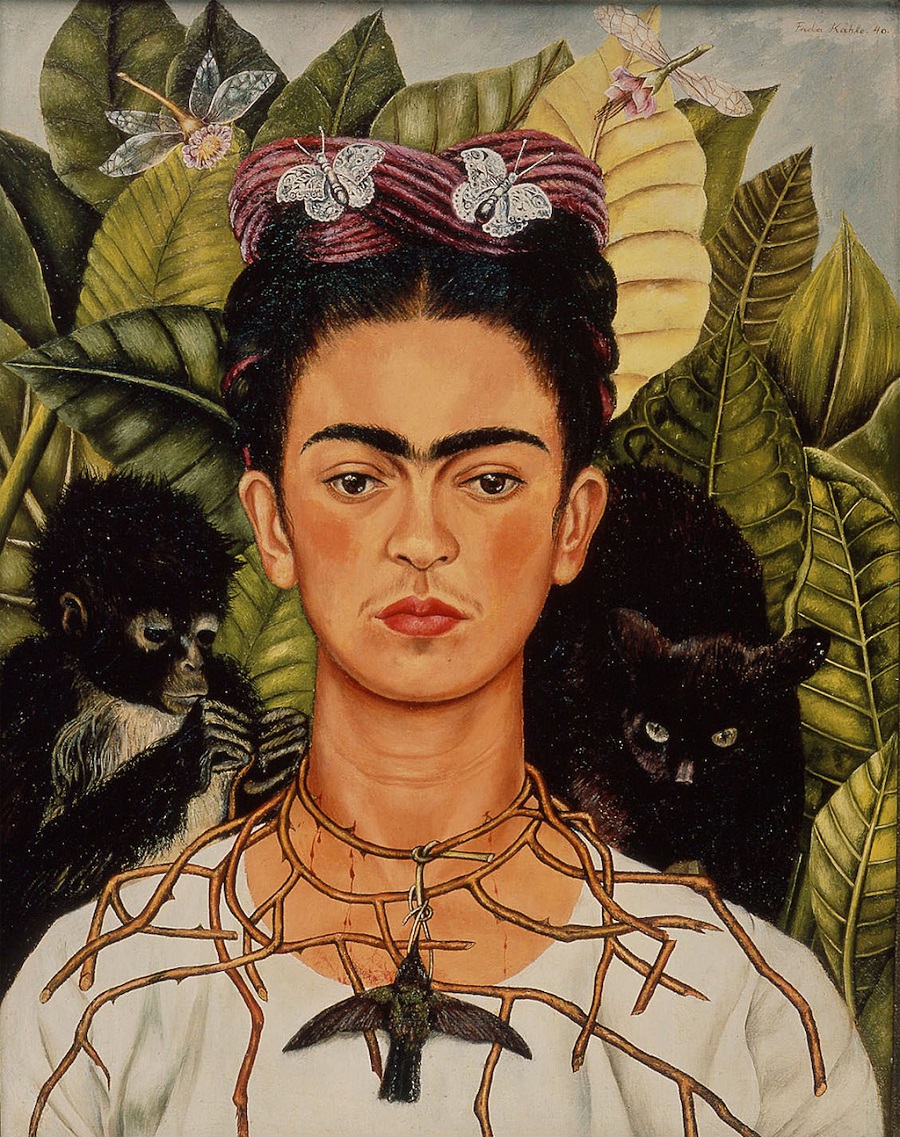
“Self-portrait with thorn necklace” (1940). From matadornetwork.com
In 1929 and at the age of 22, Frida Kahlo married Diego Rivera, who was then 43. It was "the marriage between an elephant and a dove," in her words. During the ensuing years, they lived together in La Casa Azul (The Blue House), spending long periods in the United States. In this house, and later in the current Studio House Diego Rivera and Frida Kahlo, the couple keep up an intense cultural and social life characterized by their political commitment to left-wing ideals. In fact, between 1937 and 1939, they would offer asylum to Leon Trotski and his wife who had been persecuted by Stalin. Frida and Diego's relationship underwent countless ups and downs due to the muralist's infidelities, to which Kahlo chose to respond with her own. They divorced in 1939 only to remarry in 1940, this time with a commitment to an 'open' relationship.
The final years. A decade of activity, passion and pain
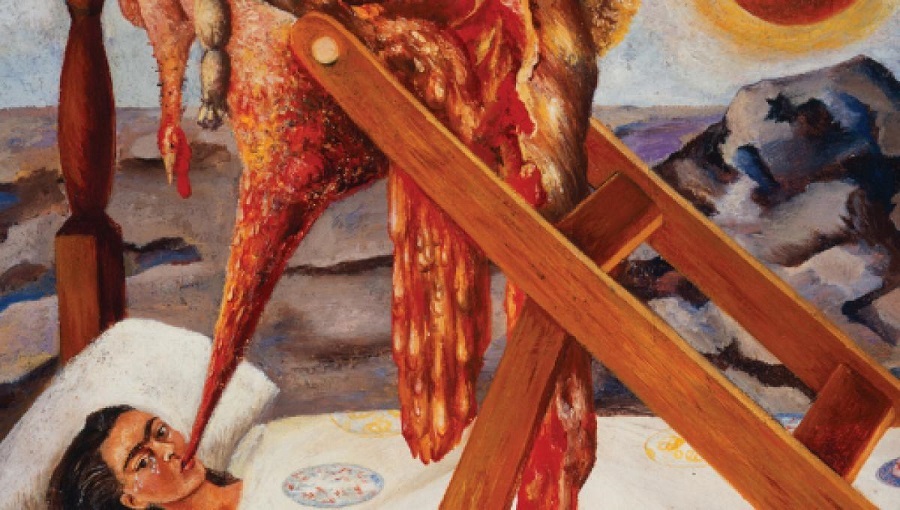
“Hopeless” (1945). From es.blastingnews.com
The 1940's were a decade of intense artistic activity for Kahlo but although she was long thought to have been overshadowed in life by Diego Rivera's powerful presence and did not at that time achieve the fame afforded to her husband, her work was indeed recognized by artists such as Breton, Picasso and Kandinsky, among others. In 1938, the Julien Levy Gallery in New York organized the first solo exhibition of her work and she began participating in collective exhibitions. Her work was exhibited in Mexico, Paris, New York, Boston and other American cities. In 1942, she joined the Seminary of Mexican Culture as a founding member and in 1943, she joined the National School of Painting, Sculpture and Engraving "La Esmeralda" as a teacher. In 1953, the year before her death, the Lola Alvarez Bravo Gallery organized a solo exhibition of her work in Mexico City which would turn out to be the only one held in the country during her lifetime.
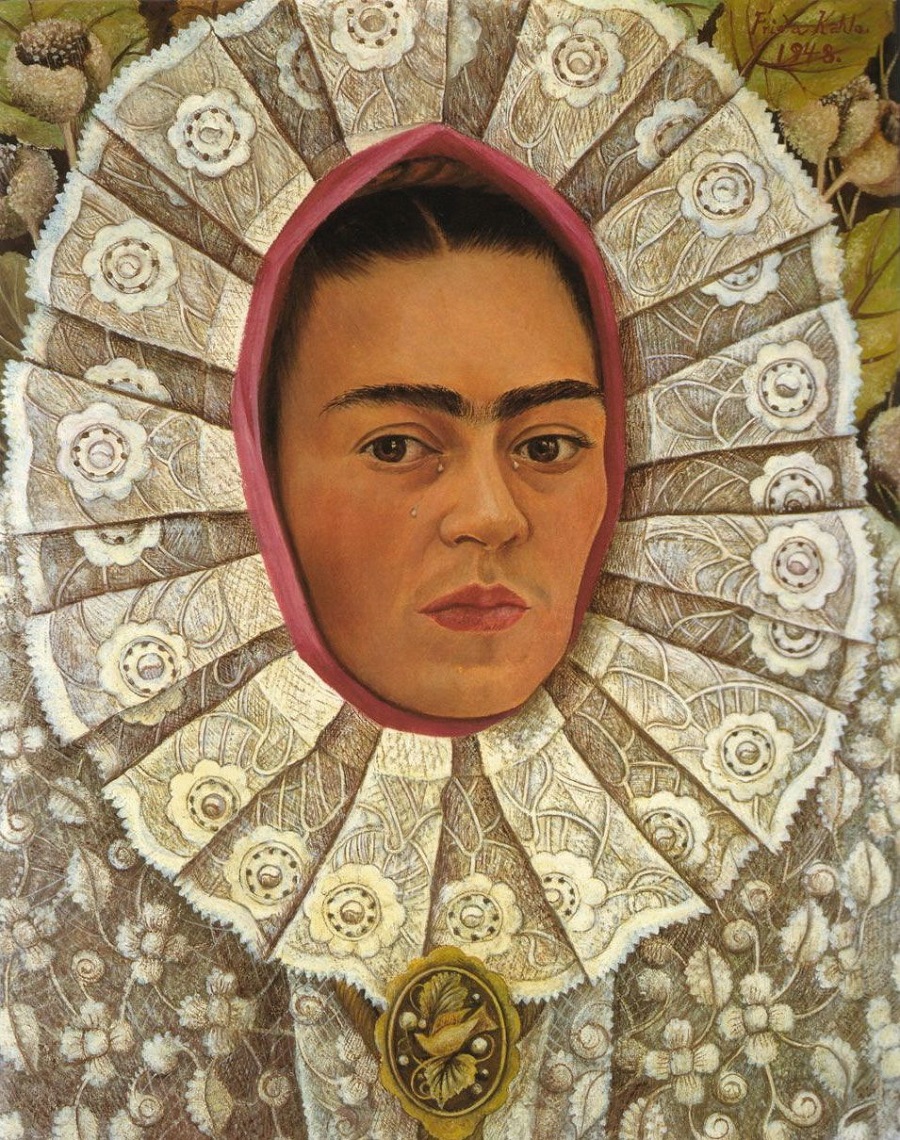
“Frida's Eyes” (1948). From bodegonconteclado.wordpress.com
Kahlo's physical and medical problems left her incapacitated in bed for long periods but she persevered with her painting and created magnificent portraits full of symbolism, depth and personality. This was the case with "Frida's Eyes" (1948), a work that reflects two of the constants in her painting: suffering and a passion for Mexican traditions. Pain and the proximity of death, which Kahlo felt was fast approching, are recurring themes on her canvases. In 1950, her health deteriorated due to spinal surgery that caused her significant problems. In 1954, Kahlo attempted suicide twice, unable to endure the pain any longer. That same year, Kahlo died at the age of 47 and her coffin, draped with the Communist flag, was placed in the capital's Palace of Fine Arts, where the most prominent Mexican artists and intellectuals of the day came to pay their respects.
Exhibitions
Frida Kahlo (2010)
In 2010, Vienna's Kunstforum organized one of the largest ever retrospectives of Kahlo’s work. In total, the exhibition included some 150 works, among them many of her most famous self-portraits.
Frida Kahlo. “Paintings and drawings from the Mexican Collection” (2016)
Kahlo's connection with the Soviet Union dates back to her youth. She always expressed her commitment to communism, social engagement and the most vulnerable members of society. In 2016, present-day Russia organized an exhibition in her honour at the Fabergé Museum in St. Petersburg: it was the first time her work had ever been shown in the country. The exhibition included some 34 pieces including paintings, drawings and photographs.
Frida Kahlo: "I paint myself” (2017)
"I paint myself because that's what I know best." These are the words with which Kahlo justified her obsession with self-portraiture. The exhibition held at the Dolores Olmedo Museum in Mexico City was a compilation of 26 works from the museum's own collection returning home although for a limited time only, as they are constantly out on loan to exhibitions around the world.
Frida Kahlo: Appearances can be deceiving (2019)
Kahlo's unique and inimitable style was without doubt an indissoluble part of her own identity and what made her an omnipresent plastic and aesthetic icon of the 21st century. The artist defined herself in her paintings and in her persona through illness, political engagement and cultural kinship. This Brooklin Museum exhibition was the largest in the United States for ten years and, in addition to paintings, included personal items, clothing and intimate treasured possessions only discovered in 2004.
Books
“The Diary of Frida Kahlo: an intimate self-portrait ”. (La Vaca Independiente)
Frida Kahlo’s life and personality, as well as her work, cannot be understood in all their magnitude without reading her diary. Written during the last ten years of her life and locked away for nearly 50 years, it is a raw testament to the painter's private feelings. Illustrated with fantastical watercolors and shot through with her unbridled and destructive passion for Diego Rivera, the journal has a prologue by the author Carlos Fuentes and includes an essay by Sarah M. Lowe. 170 pages of art, emotion and intimacy.
“Frida Kahlo: Beneath The Mirror”. Gerry Souter (Parkstone Press)
Frida Kahlo used herself as the exclusive model for dozens of self-portraits. It is precisely these works that conceal and distill the essence of her life, her history and her feelings. They are, without a doubt, the best autobiographical testimony we have of the artist. Gerry Souter's biography uses these works and other paintings to articulate her story. The writer later wrote a second volume dedicated to Kahlo's husband and muralist and painter Diego Rivera.
“Frida Kahlo: Fantasy of a Wounded Body”. Araceli Rico (Plaza y Valdés)
The author Araceli Rico was one of the first to recognise the enormous importance of Frida Kahlo's work in the sphere of world art. Page by page and word by word, the internal tension that Kahlo always experienced is revealed, as is the symbiosis she experienced between art and life, body and painting. This is an essential book to get to know both the person and the painter, both trapped in the same body, both loved and tortured.
(Translated from the Spanish by Shauna Devlin)
- Frida Kahlo: Biography, Works and Exhibitions - - Alejandra de Argos -
- Details
- Written by Marta Sánchez
Joan Miró was never one to play it by the book. As an artist, he lived and worked with the most notable creatives of his time and was open to the influence of any and all movements, works of art, schools and manifestos. But his work breaks away subtly from that of his contemporaries, invariably following its own unique and personal trajectory. By dint of constant creativity and his interest in all manner of artistic techniques, Miró left a legacy that is vast, versatile and full of coherence.
That most personal of all 20th century avant-garde art
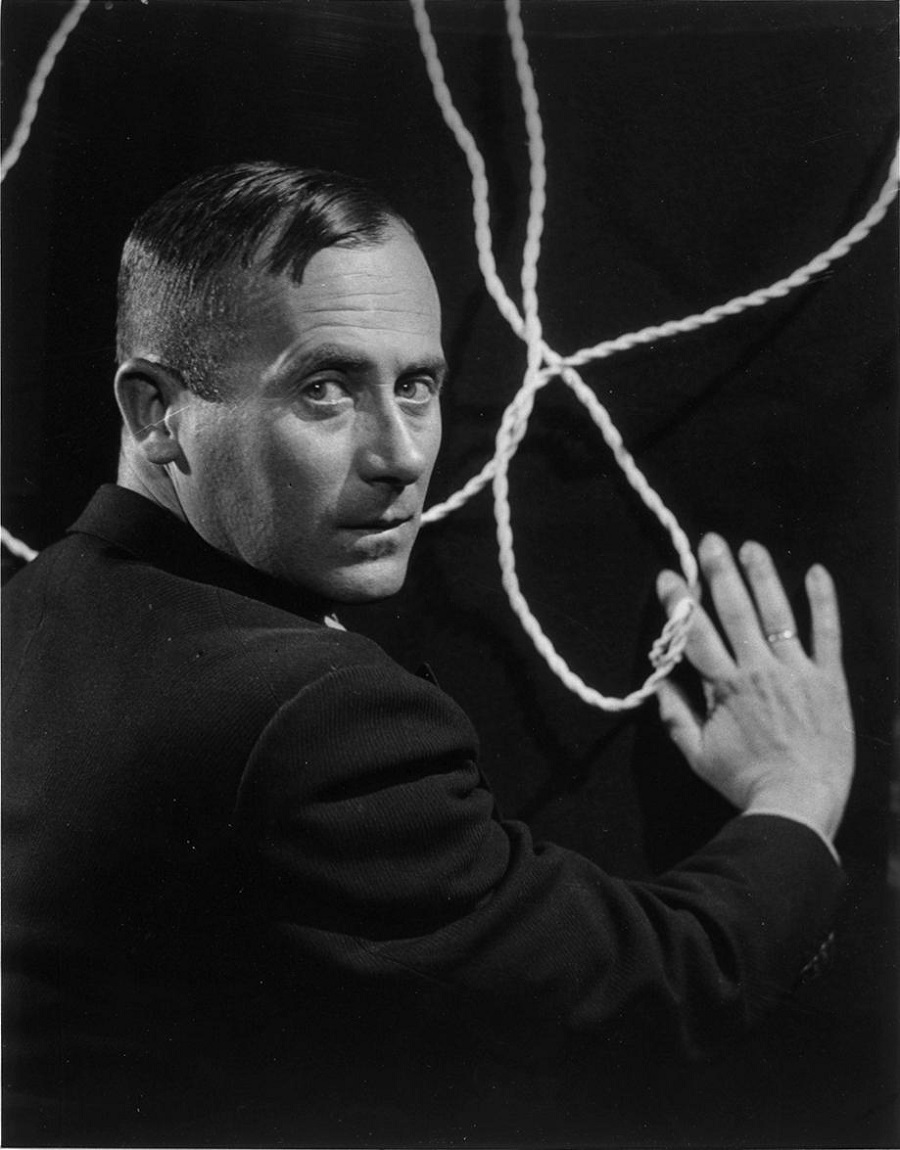
Photo of Joan Miró by Man Ray (1933). From www.museoreinasofia.es
Joan Miró was never one to play it by the book. As an artist, he lived and worked with the most notable creatives of his time and was open to the influence of any and all movements, works of art, schools and manifestos. But his work breaks away subtly from that of his contemporaries, invariably following its own unique and personal trajectory. By dint of constant creativity and his interest in all manner of artistic techniques, Miró left a legacy that is vast, versatile and full of coherence. Today, he is considered one of the most important artists of the 20th century on an international scale, his influence transcending the field of plastic art to impact and shape others such as graphic design and advertising. During his ninety years of life, Miró lived and worked in Barcelona, Mallorca, Paris and New York and his deep-seated love for home, especially Barcelona and the island of Mallorca, remained at the heart of his work, infused with the other landscapes that influenced his life.
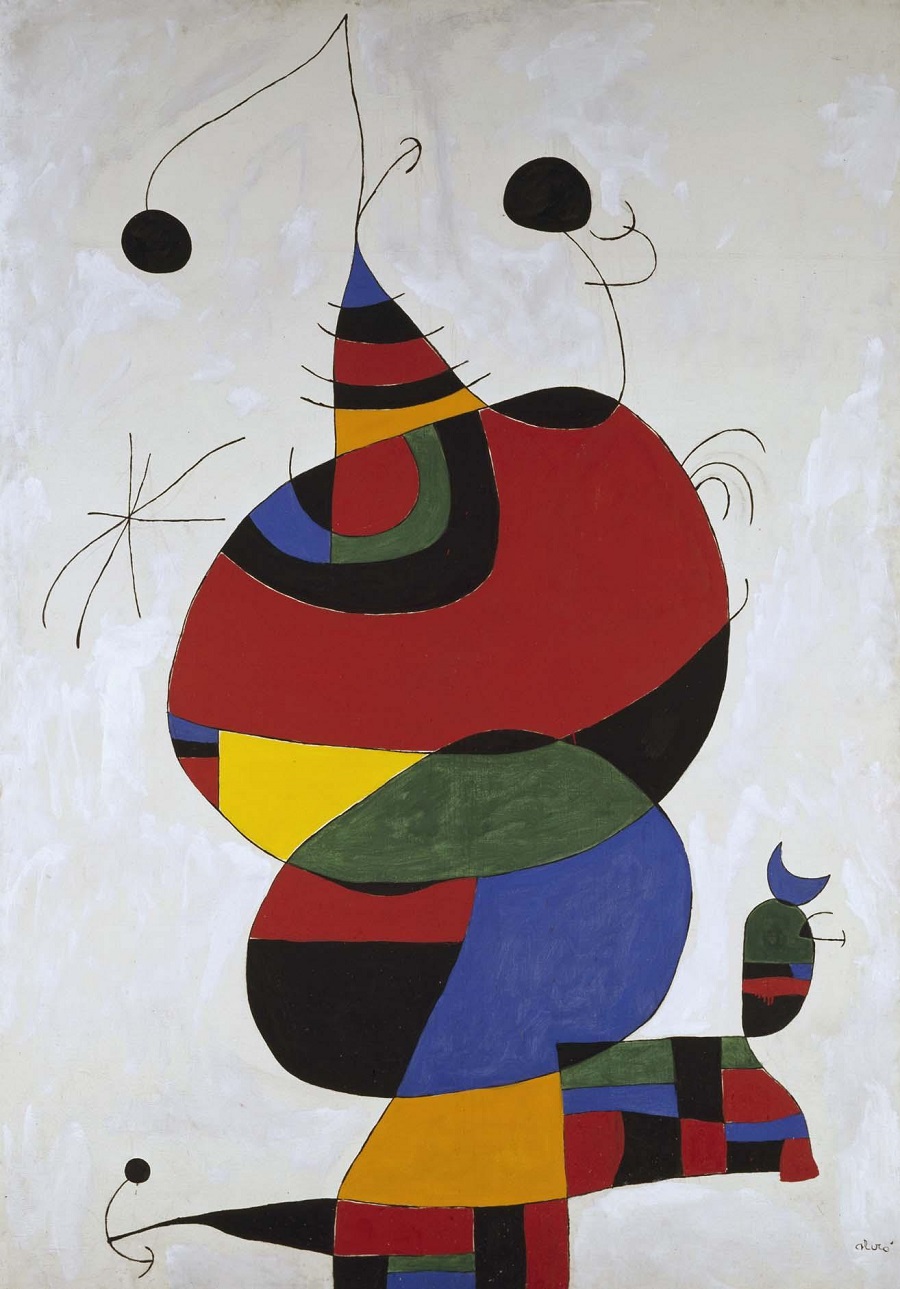
"Femme, oiseau, étolie (Hommage to Pablo Picasso)", 1966-1973. From www.museoreinasofia.es
The love of art and discovery of modernity
Joan Miró i Ferrà was born in Barcelona in 1893 as the 19th century drew to a close and the arrival of the 20th augured a worrying shift in society, culture and artistic practices. Miró's artistic vocation was probably underpinned by his family's professions - his father was a goldsmith and watchmaker while his grandfather was a Mallorcan cabinet maker. The first known drawings by Miró date from 1901 when he was just 8 years old. During his university years, he combines Business with Fine Arts studies and in 1910 starts work as an accountant at a pharmaceutical company but his artistic disposition rebelled against the stasis of number-crunching and he resigns. At around the same time, he becomes ill with typhoid fever and goes to live for the first time at Mont-Roig, in a country house owned by his parents, and the surrounding Catalan Lowlands will remain forever in his heart and mind, becoming the protagonist in many of his works.
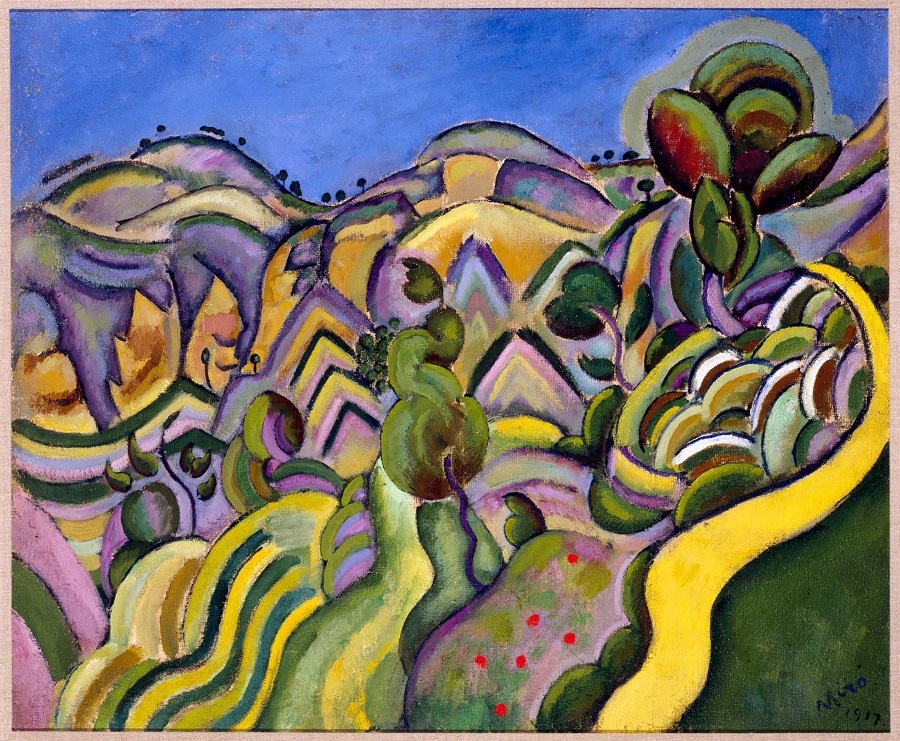
"Sirurana, el camí” (1917). Reina Sofia Museum, Madrid. From www.museoreinasofia.es
Convalescence allows Miró the time to reflect on his future and it is then that he decides to dedicate his life to painting and enrolls at the Francesc Gali School of Art where he first comes into contact with the circle of Catalan artists who will later become his friends, colleagues and art dealers. These are years of passion and youth, of painting live models and sharing studios with other artists. They are also years of discovery: Dadaist art and avant-garde Catalan and French publications spark the young Miró's interest.
The Paris Years
In the early 1920s and after his first exhibition at the Dalmau Galleries belonging to his friend and first dealer Josep Dalmau, Miró moves to Paris, where he works at Pablo Gargallo's studio. During his months off, he returns to Mont-Roig which, along with Paris, Barelona and New York, constitutes the nucleus around which his work would be structured. These were exciting years during which he meets Picasso, André Masson, Ernest Hemingway, André Breton and Paul Éluard, among other notable figures from the intellectual and artistic elites of the time. Miró works on projects above and beyond mere painting, such as his collaboration with Max Ernst on the costumes and staging for the ballet "Romeo and Juliet". It is also at this time that he creates his first "Spanish Dancers" (1928), Dadaist-inspired collages that will mark his later work. From 1930, Miró shows a growing interest in other disciplines, such as bas-relief and sculpture, which will come to feature more prominently in the ensuing years than his painting although he never abandons it altogether.
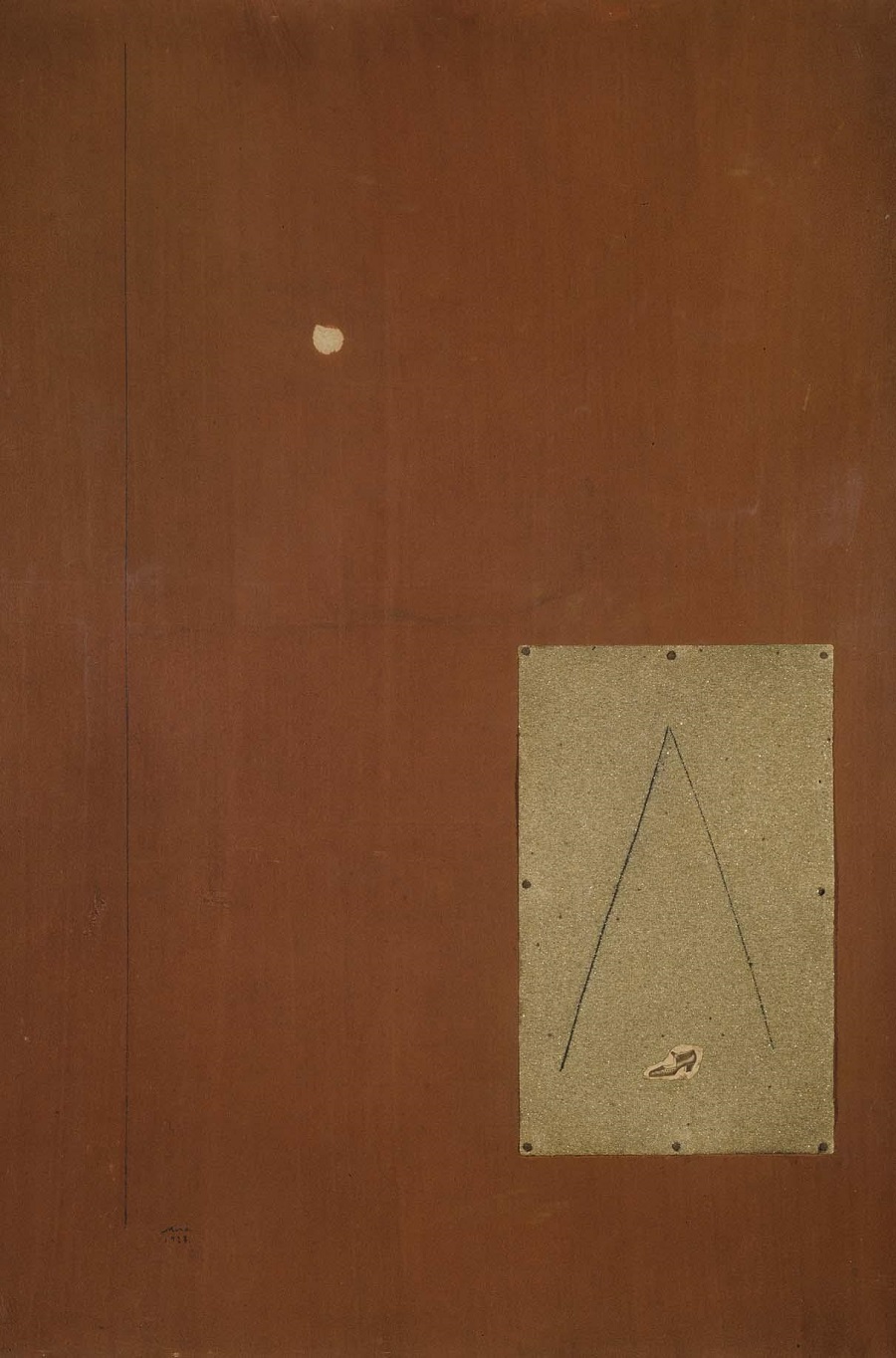
"Spanish Dancer I” (1928). Reina Sofia Museum, Madrid. From www.museoreinasofia.es
Collages, objects and murals
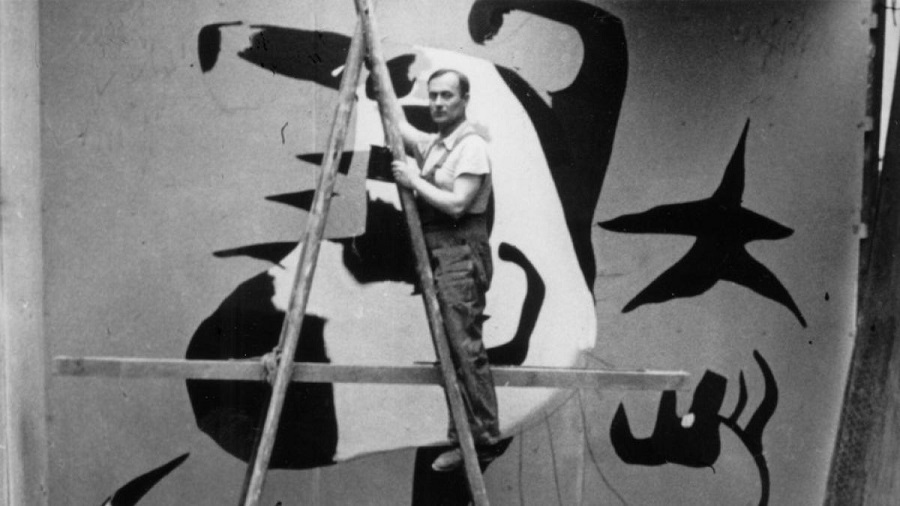
Joan Miró working on the mural "The Reaper" (1937). From www.20minutos.es
From 1931, Miró, dividing his time between Mont-Roig, Paris and Barcelona, adds another new and fascinating location - New York, where Pierre Matisse, son of the French Fauvist painter and engraver Henri, will be his representative. During these years, Miró increasingly expands the spectrum of disciplines used for his work, creating etchings, collages, assemblages and paintings on masonite. The outbreak of the Spanish Civil War forces him, along with his family, to move to Paris where he commits to the Republican cause by painting, in 1937, a large mural, "The Reaper (Catalan peasant in revolt)", for the Spanish Pavilion at that year's International Expo. The mural has since disappeared and black and white photographs are all that survived.
A passion for sculpture
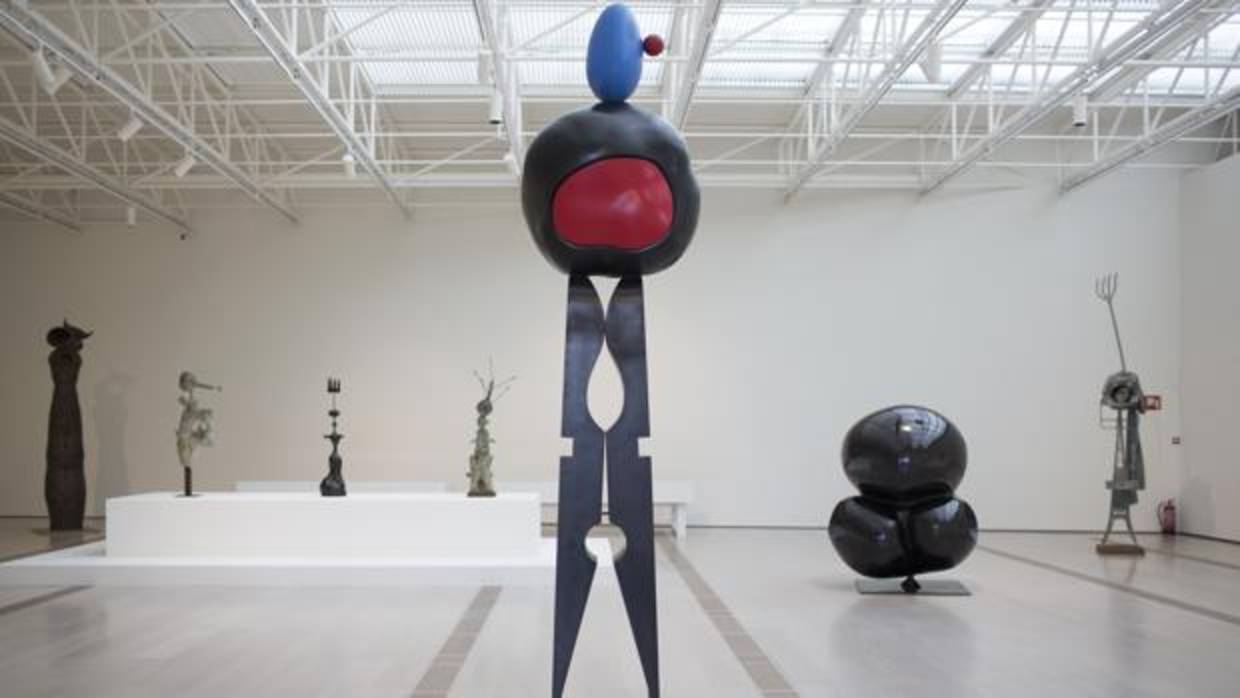
"Personnage" (1974) from the exhibition Joan Miró: Sculptures, organised by the Centro Botin de Santander in 2018. From ABC
From the 1920s onwards, Miró dedicates a large part of his time to sculpting. His three-dimensional works took their inspiration from his declared passion for 'objects', so much so that he came to stockpile hundreds of them in his studio. In the 1940s, the artist cast his first bronzes and began experimenting with different materials and media. Up until the very end of his life, Miró would develop his work on sculpture and compile an enormous portfolio. In the 1960s, Alberto Giacometti advised him to paint some of his bronzes, a suggestion that resulted in some magnificent pieces, such as "Personnage" (1967). In addition to bronzes and painted figures, Miró also worked with marble and ceramic-clad concrete. His last monumental sculpture, "Dona i Ocell" (1987), is a fine example of his mastery of materials.
International art that lives on
From the 1950s onwards, Miró consolidates his international reputation and his fame begins to spread worldwide. He settles definitively in Palma de Pallorca where he undertakes his first ever ceramic pieces, in collaboration with the ceramicist Josep Llorens Artigas. He will employ this technique in enormous murals that can still be seen and admired in numerous major cities, those at the UNESCO headquarters in Paris (winner of the Guggenheim International Award), Harvard University and Barcelona Airport to name but a few. 1975 sees the inauguration of the Miró Foundation in Barcelona, tasked with managing and disseminating the artist's legacy. Miró continued to work for the remainder of his life and died aged ninety in 1983, widely regarded as one of the greatest artists of the 20th century.

Mural "La Luna" (1958) in collaboration with Josep Llorens Artigas at UNESCO headquarters, Paris. From www.unesco.org
EXHIBITIONS
Hommage to Miró (1974)
This exhibition at the Grand Palais in Paris was the last retrospective of his work to take place during Miró's lifetime. Over forty years later, in 2018, the Grand Palais was to inaugurate another large exhibition dedicated to the artist, "Miró, the colour of dreams", showcasing more than 150 of his works.
Miró and the object (2016)
Organized by the CaixaForum Madrid, the aim of this exhibition was to explore new facets of Miró's universe through objects: their poetics, their expressive possibilities and the "soul" that Miro was always able to find in them. The exhibition opened in Madrid after first showing at the Miró Foundation in Barcelona and covers the long artistic period from the 1920s to the 1970s. Some of the works on display (for instance "The Toys", 1924) were being seen in Spain for the first ever time.
Miró, the colour of dreams (2018-19)
As mentoned above, this exhibition at the Grand Palais was in honour of the work and figure of Joan Miró forty four years after the previous retrospective in the 1970s. As his personal friend and the exhibition's curator Jean Luis Prat commented at the time: “Miró was probably deeply affected by 50 years of history marked by two world wars. These formidable events and the questions he asked of men, of himself and of his homeland have coloured his work."
Birth of the World – MoMA (2019)
In early 2019, the Museum of Modern Art in New York (MoMA) organized a grand exhibition of the artist's work with key pieces from its magnificent collection and several exclusive loans. The exhibition centres the painting "The Birth of the World" as its focal point. The display comprised almost 60 oils on canvas, drawings on paper, engravings, illustrated books and objects.
BOOKS
"Miró". Jacques Dupin, 1961
Constantly revised, updated and reworked, the monograph published by Jacques Dupin in the early 1960s is essential reading for anyone wanting to know all there is to know about our Catalan artist. The biographer completed the book including Miró's work over the subsequent two remaining decades of his life, thanks to the excellent relationship he enjoyed with Miró's family and unprecedented access to work carried out by historians, curators and art experts. In 1993, another revised edition was published which is still considered, today, one of the most fundamental texts on the life and works of Joan Miró.
"Miró". Janis Mink, 1999
Taschen publishing house, the benchmark in art and artist monographs, published a 1999 biography of Joan Miró by Janis Mink. With hundreds of illustrations and magnificent attention to detail, the book covers the artist's trajectory of almost 70 years - from his Surrealist-style automatic drawings to the assemblage-sculptures he constructed from objects. The book is careful to respect Miró's idiosyncrasies as an unclassifiable artist and figure who resisted being pidgeonholed into categories, trends or schools.
“Joan Miró. The Road To Art”. Pilar Cabañas, 2013
Much has been written about Joan Miró's life and work but even so, in 2013, Pilar Cabañas managed to shine a whole new light on the artist's work and write a book that is vital for understanding it. Basing her point of view on the principles that govern Miró's work, the author provides us with the guidelines for understanding the man as a human being and as an artist. Cabañas delves into issues such as what drives his creativity, the reasoning behind his art and the exploration of sadness, loneliness and pain in his work, among others. With Miró as a starting point, Cabañas guides us through art in general as a path to transcendence and the essence of humanity. The text is enriched by the participation of Ignacio Llamas who designed the edition.
(Translated from the Spanish by Shauna Devlin)
- Joan Miró: biography, works, exhibitions - - Alejandra de Argos -

